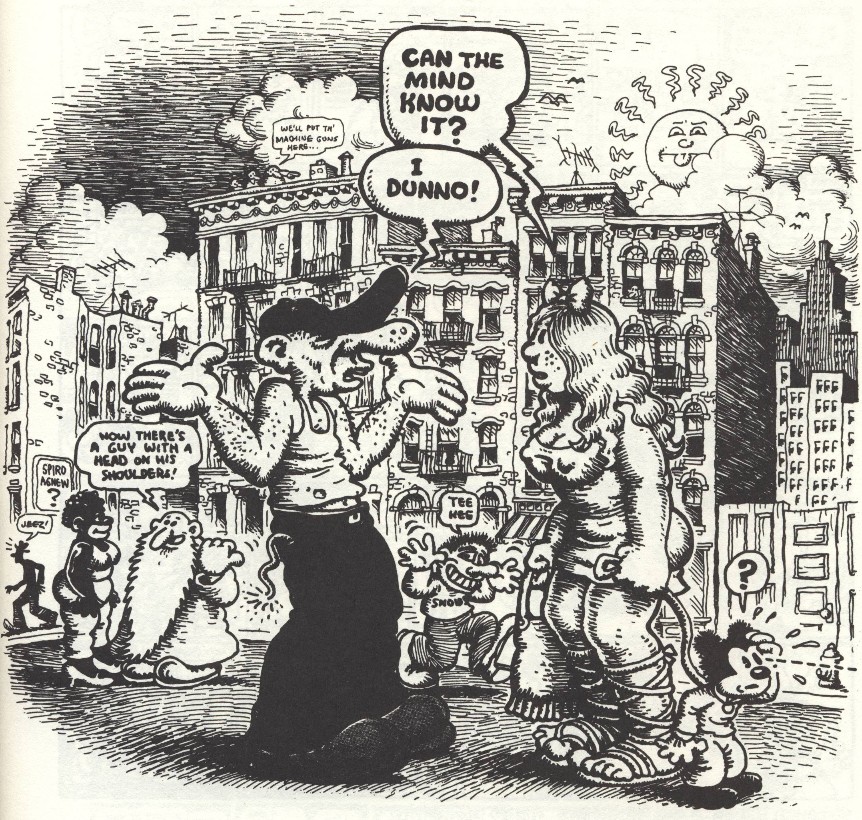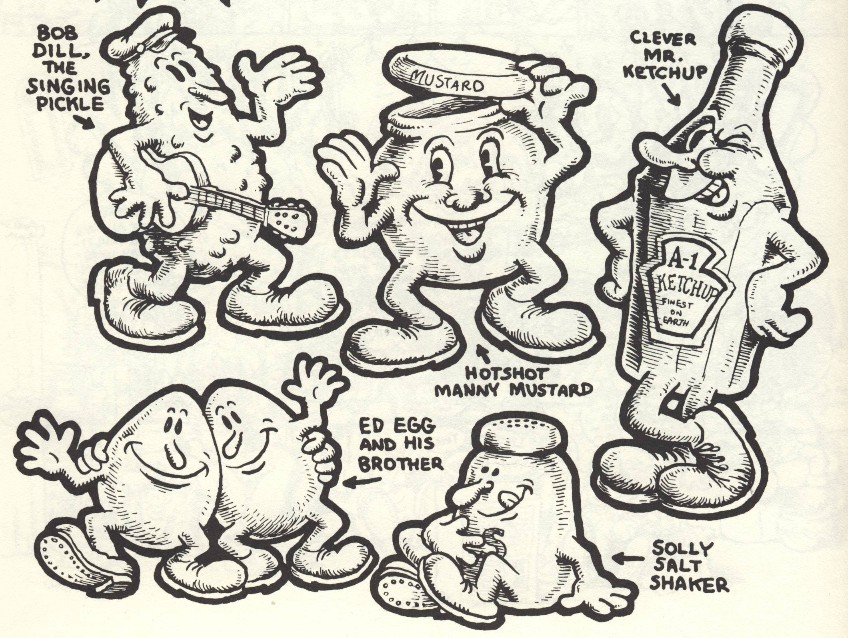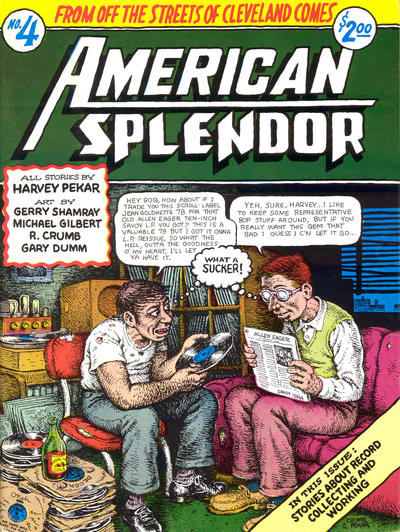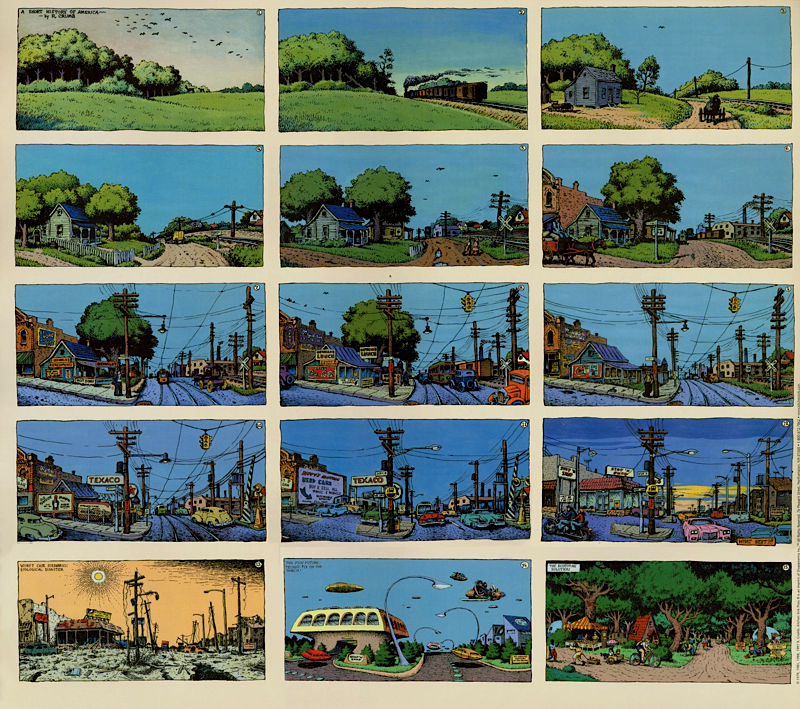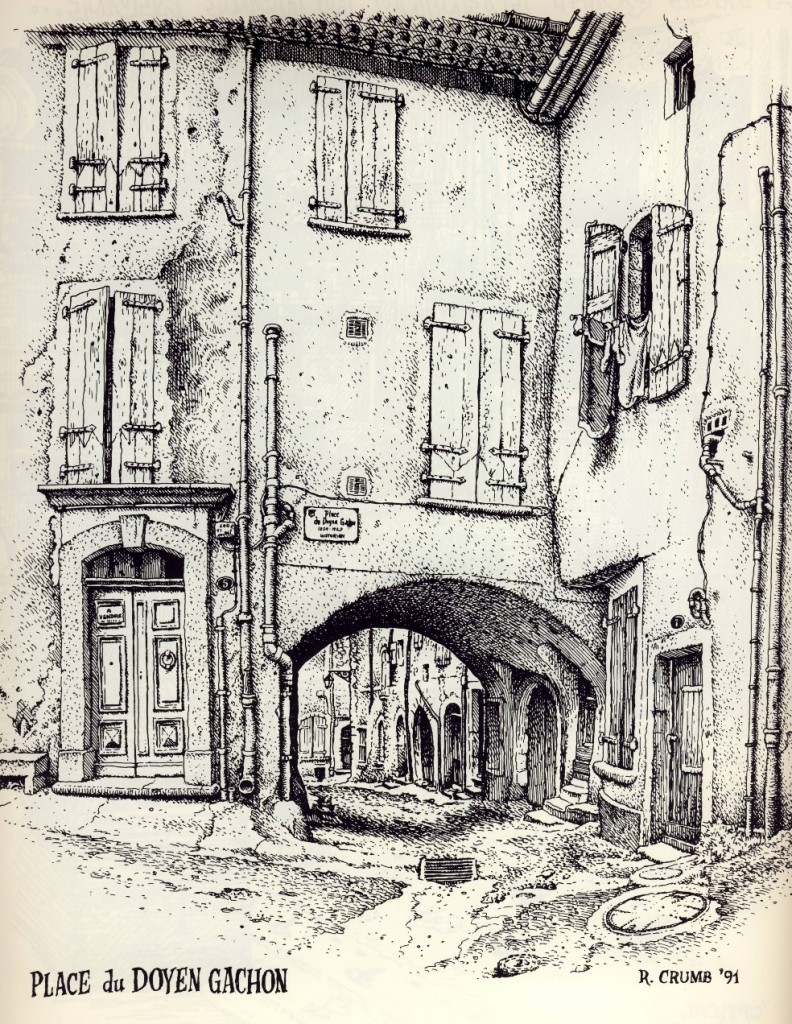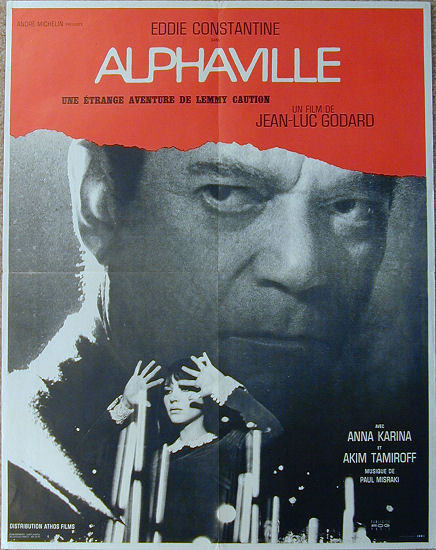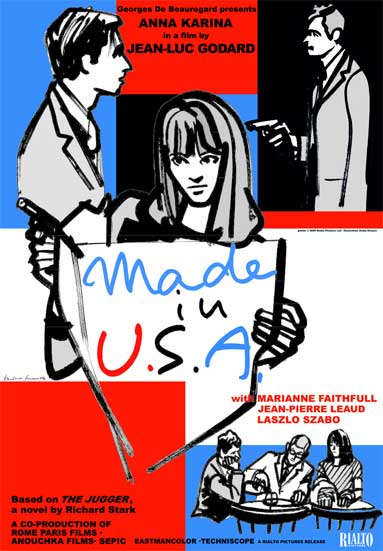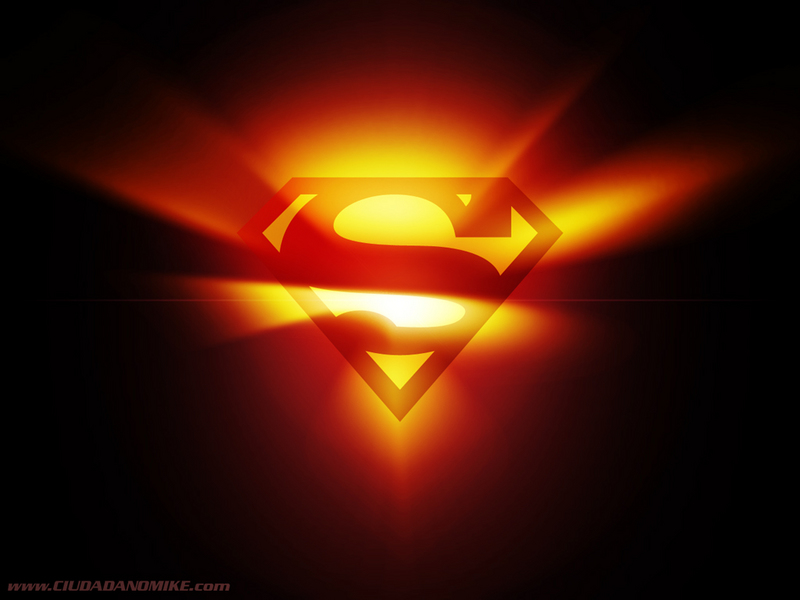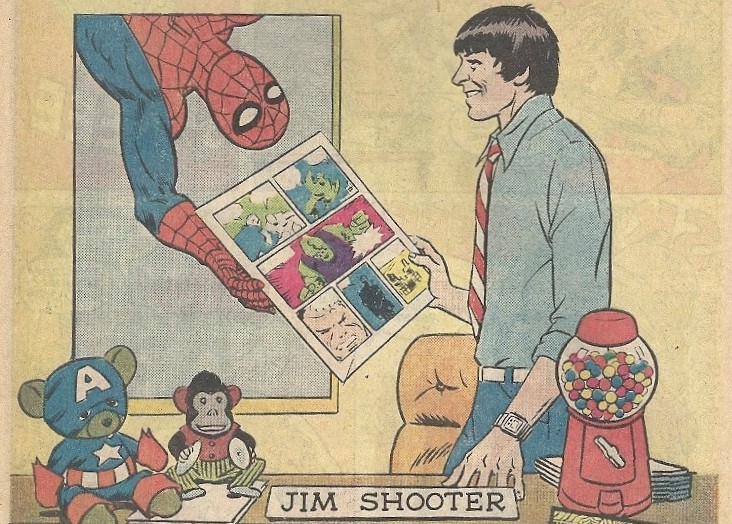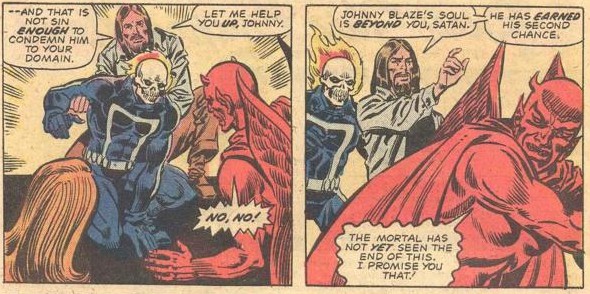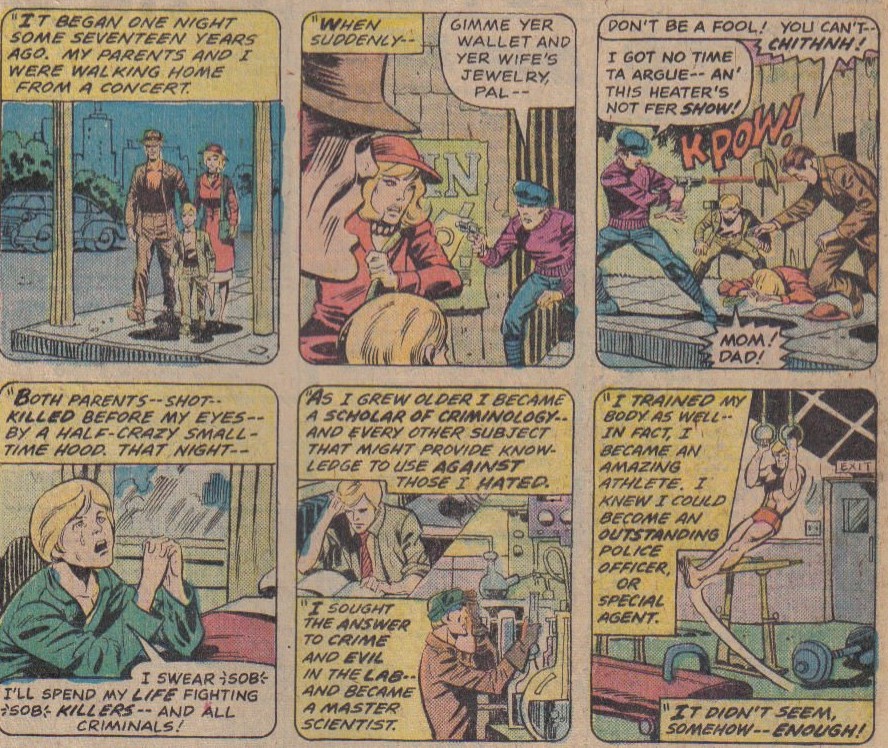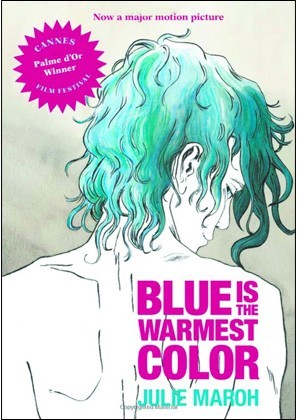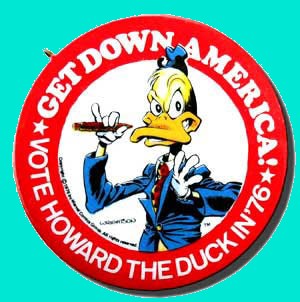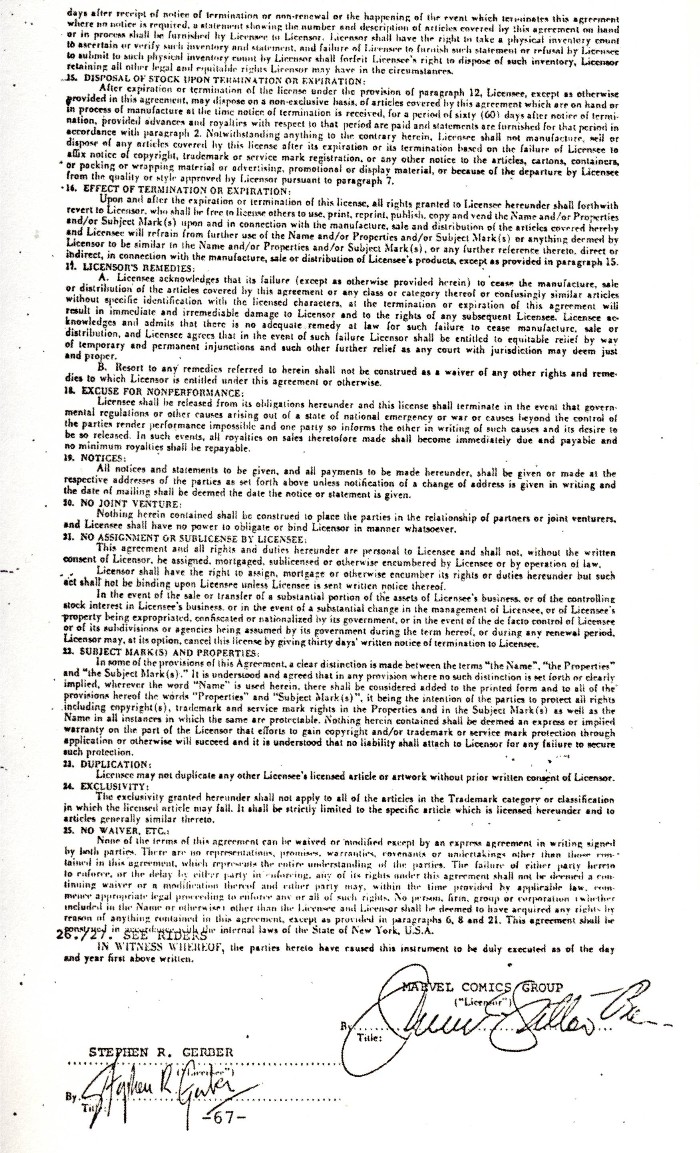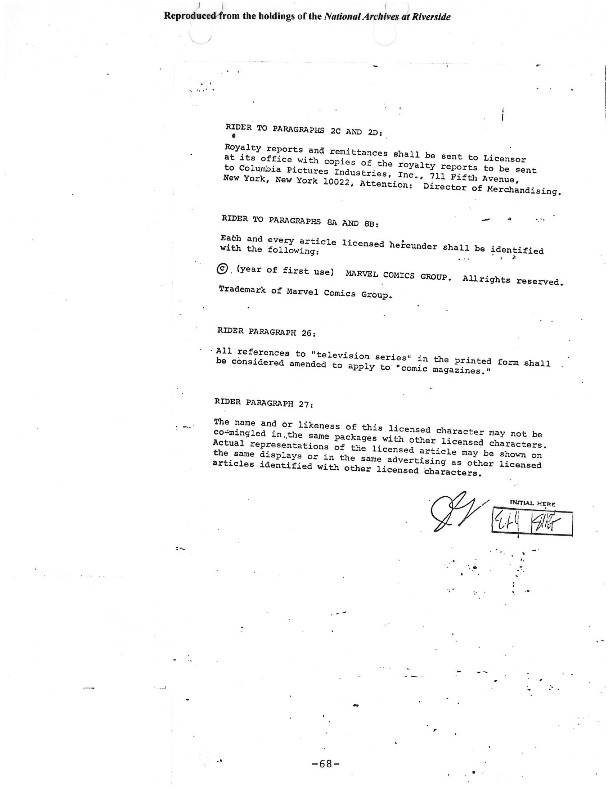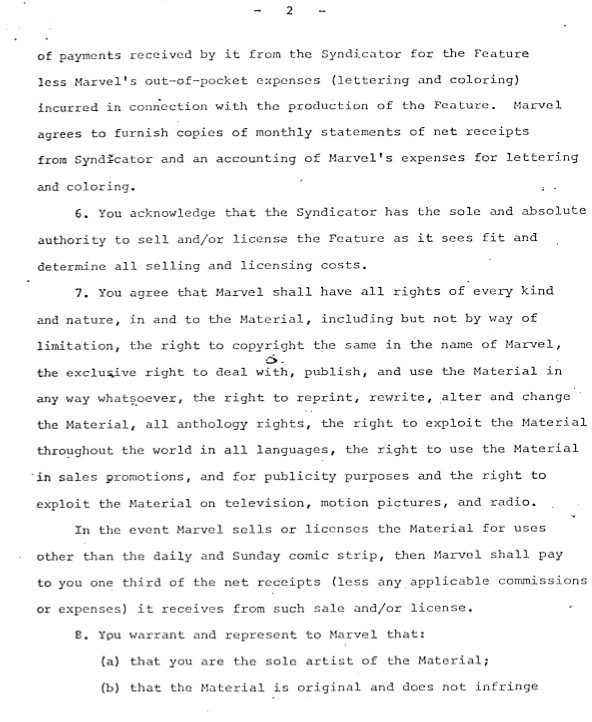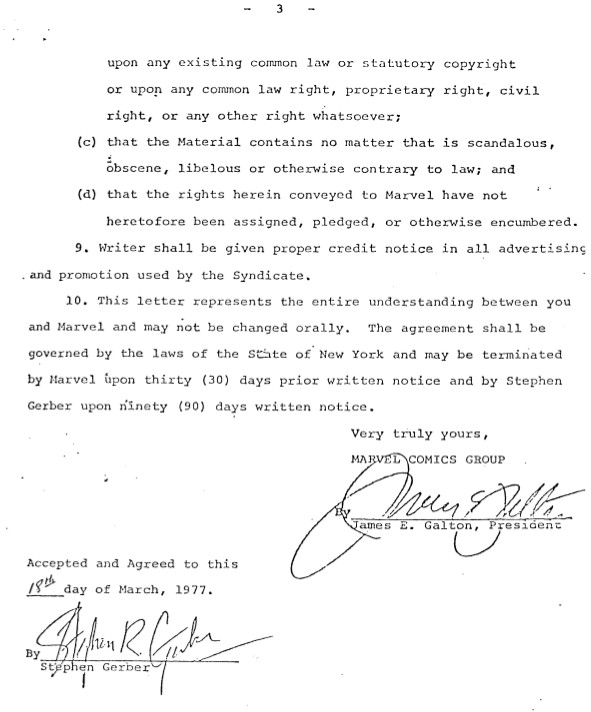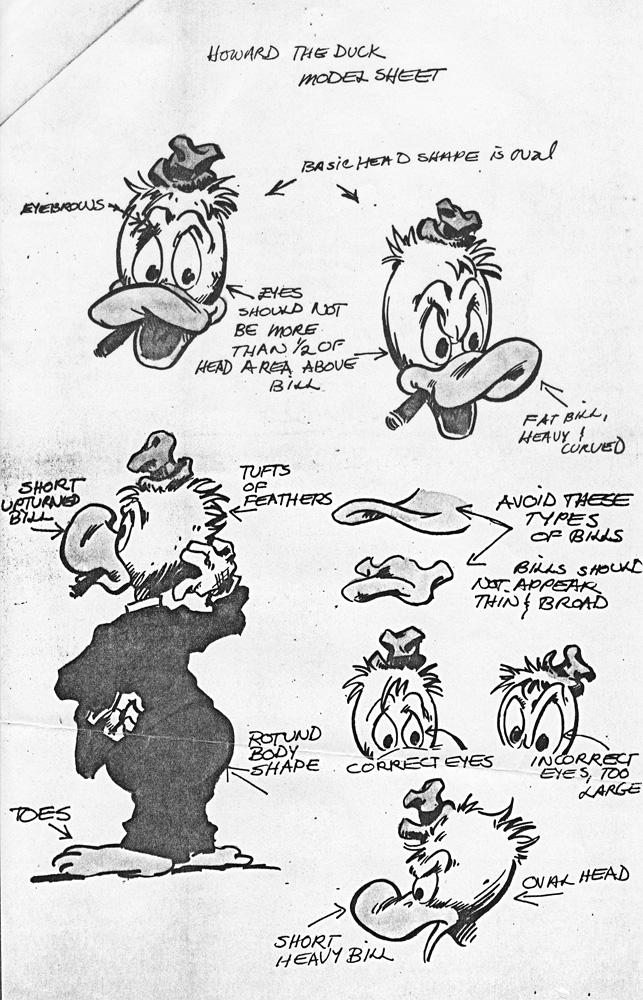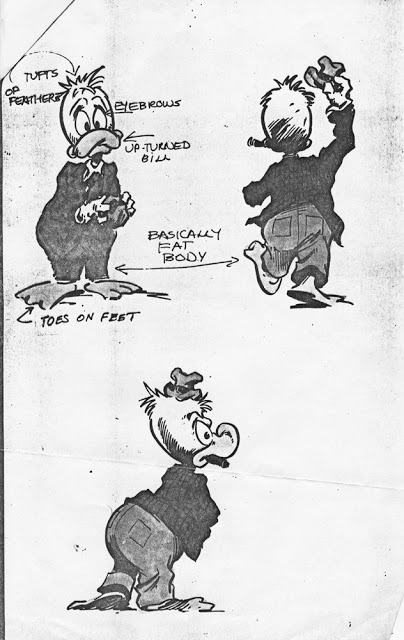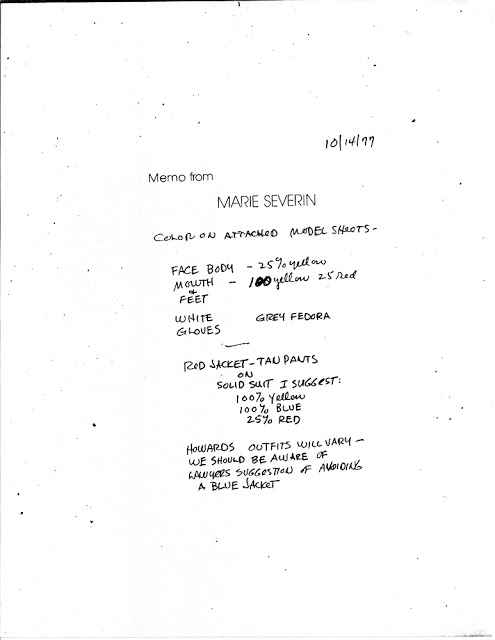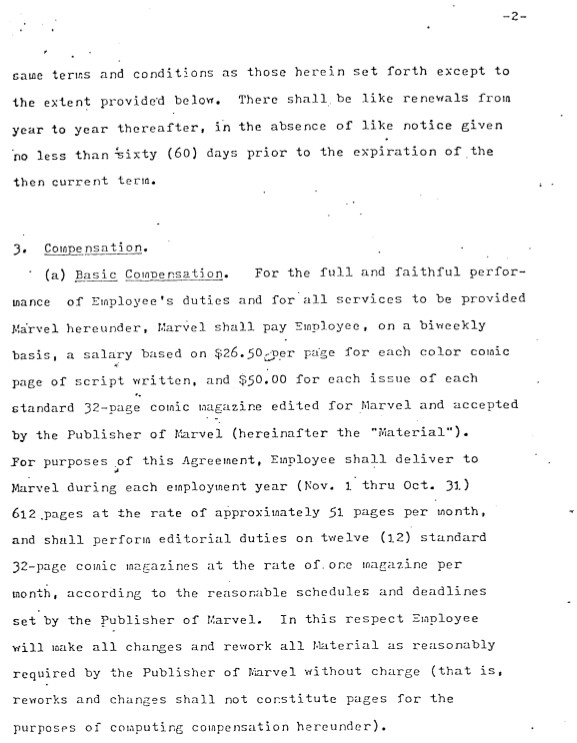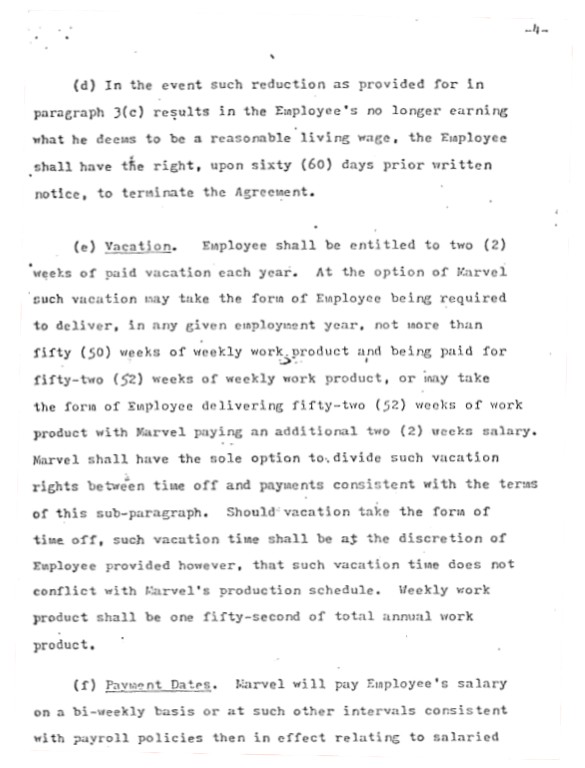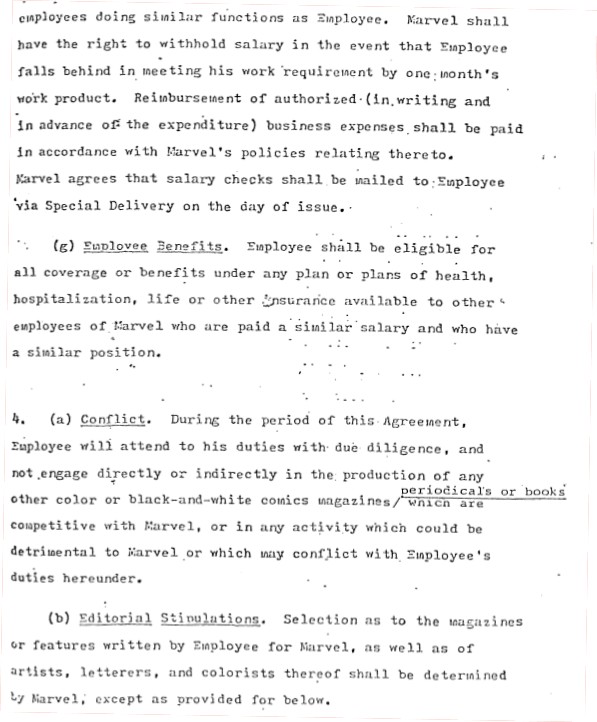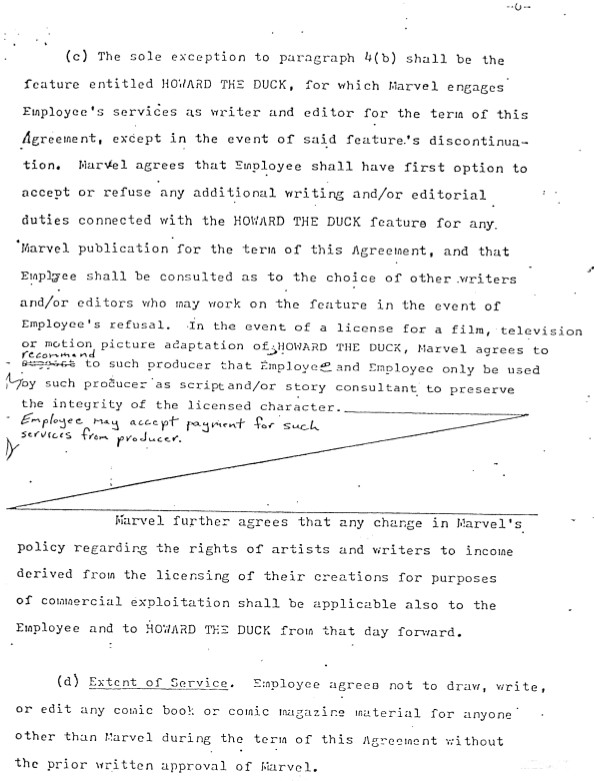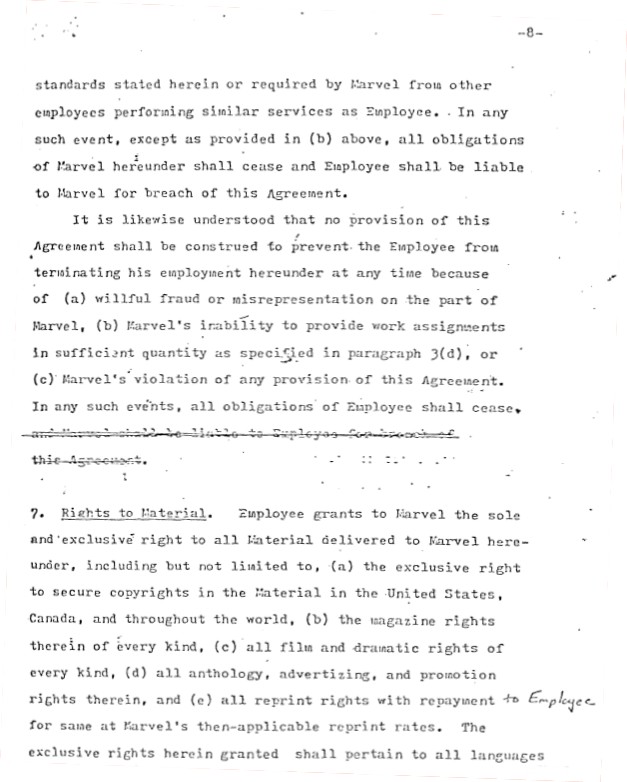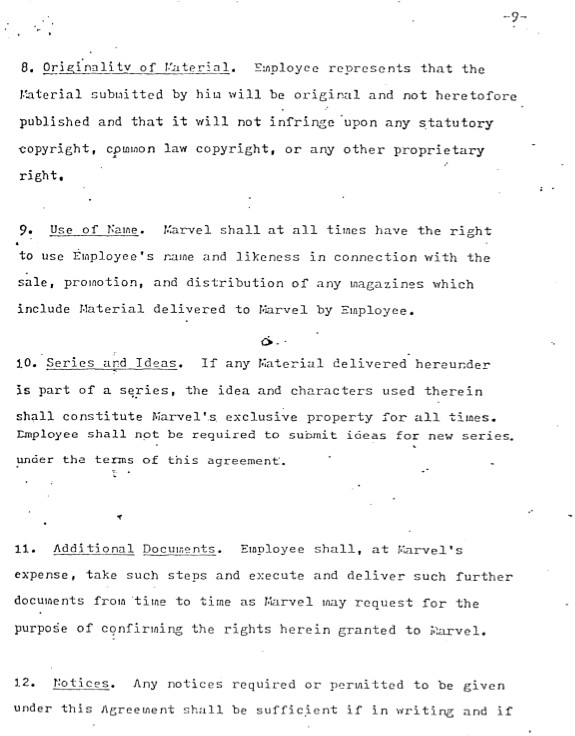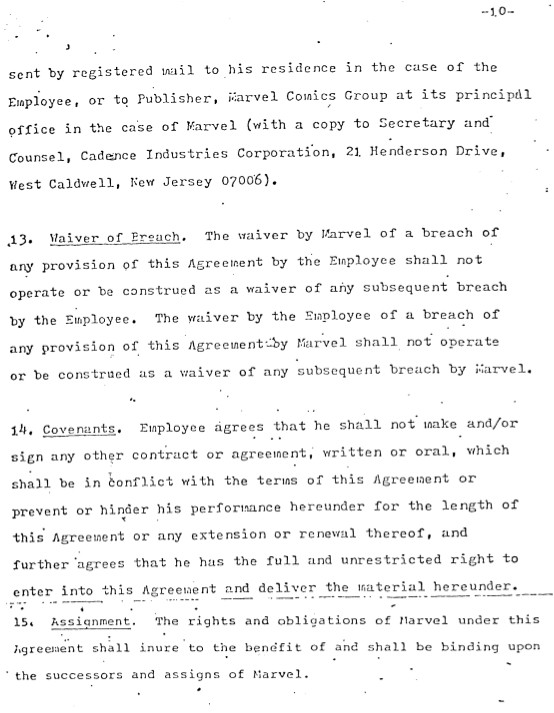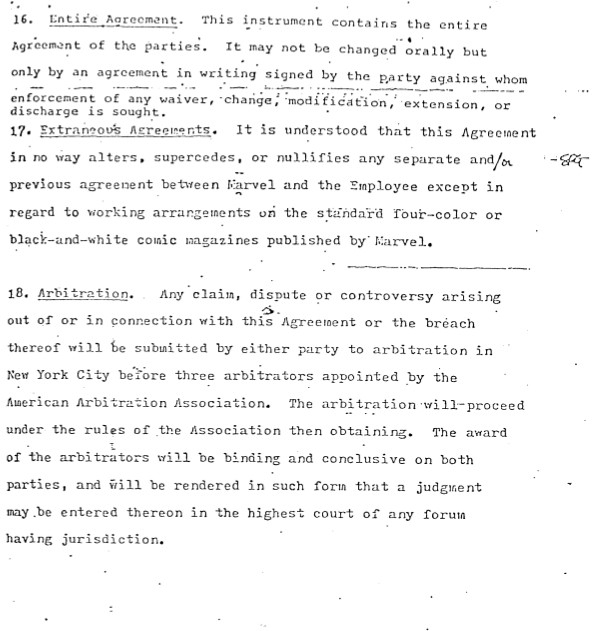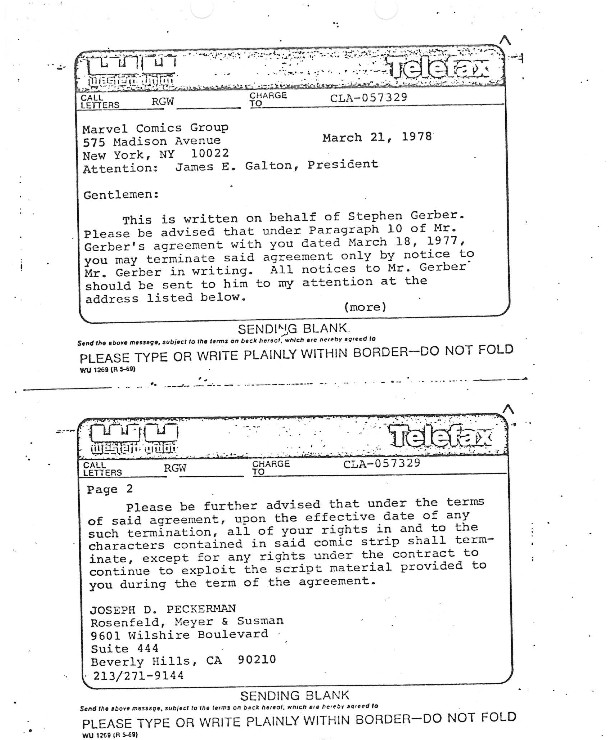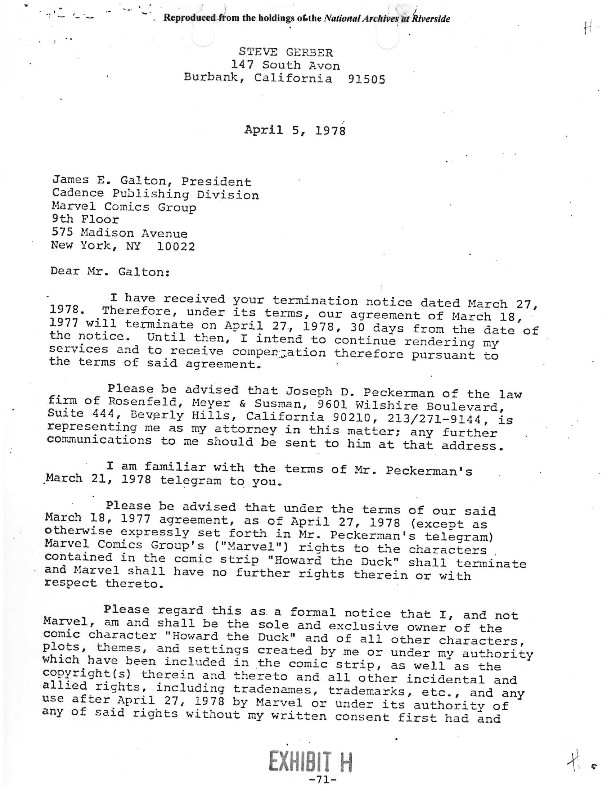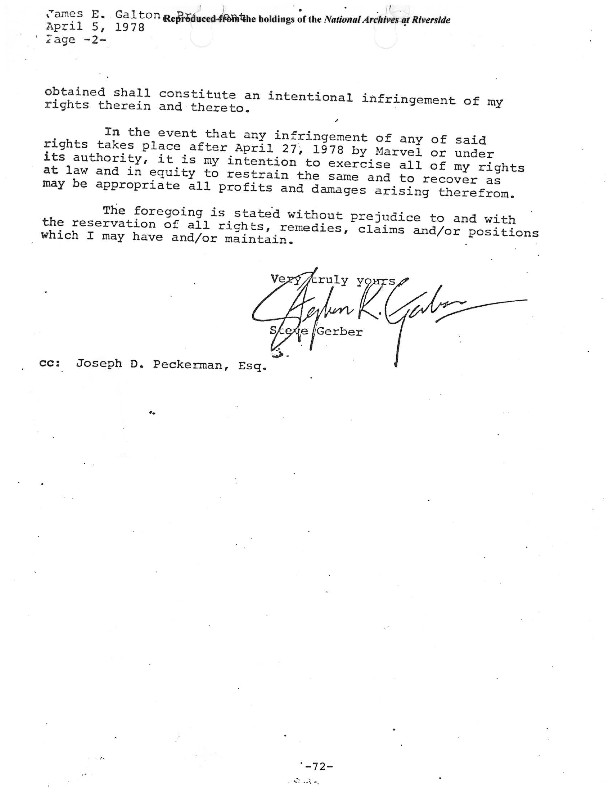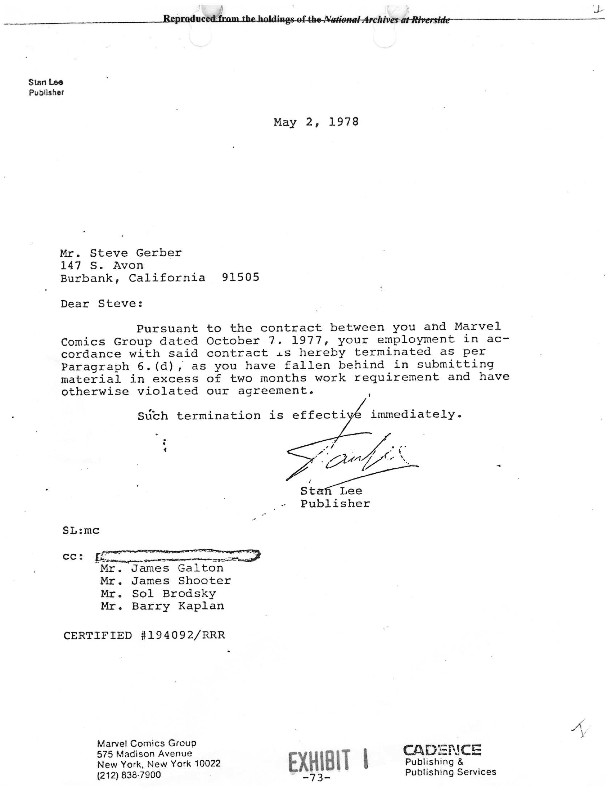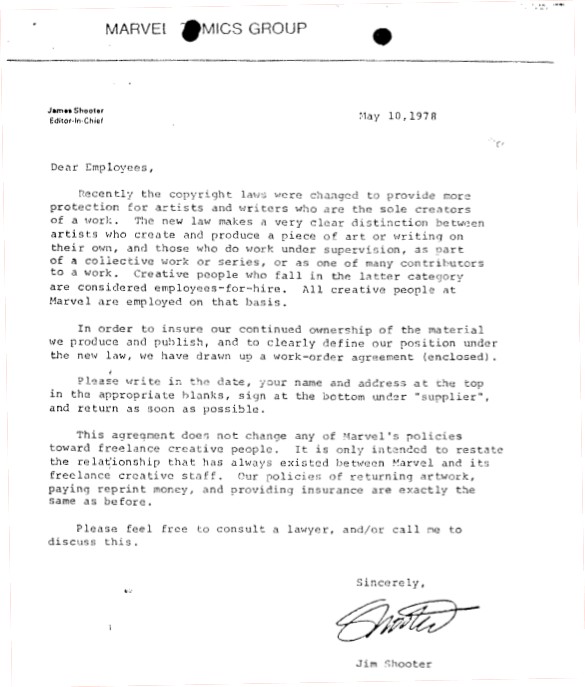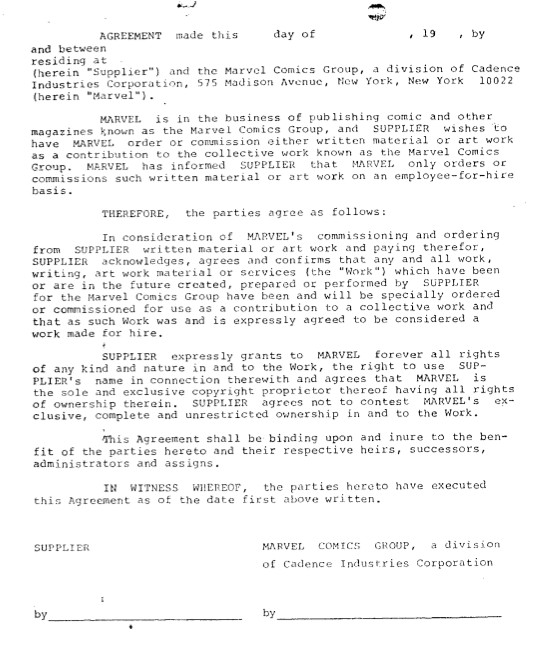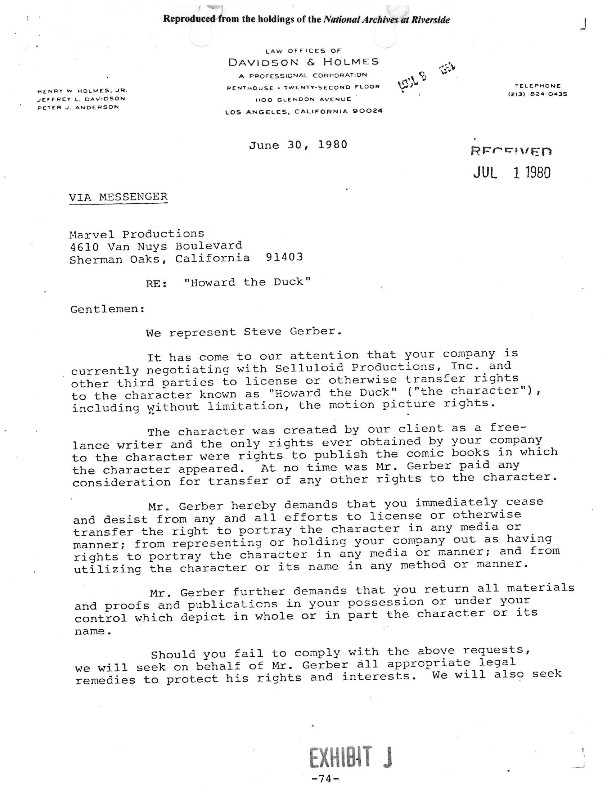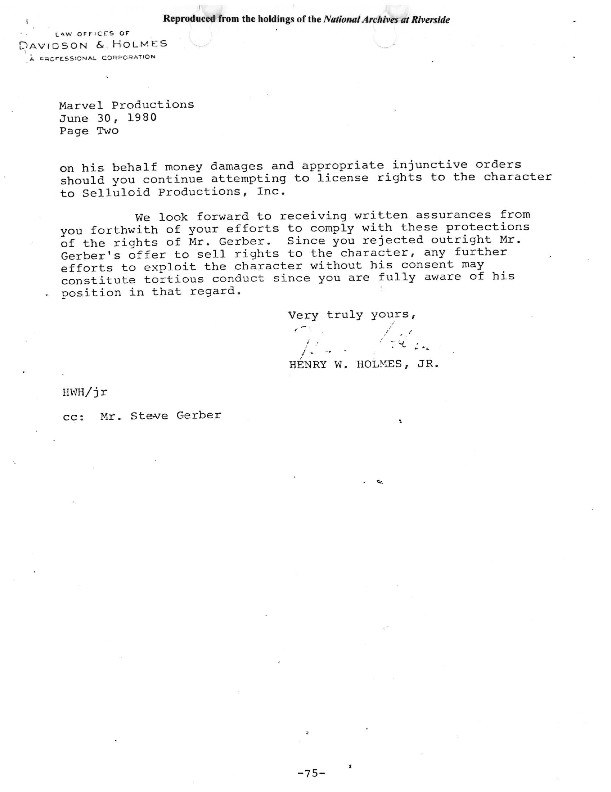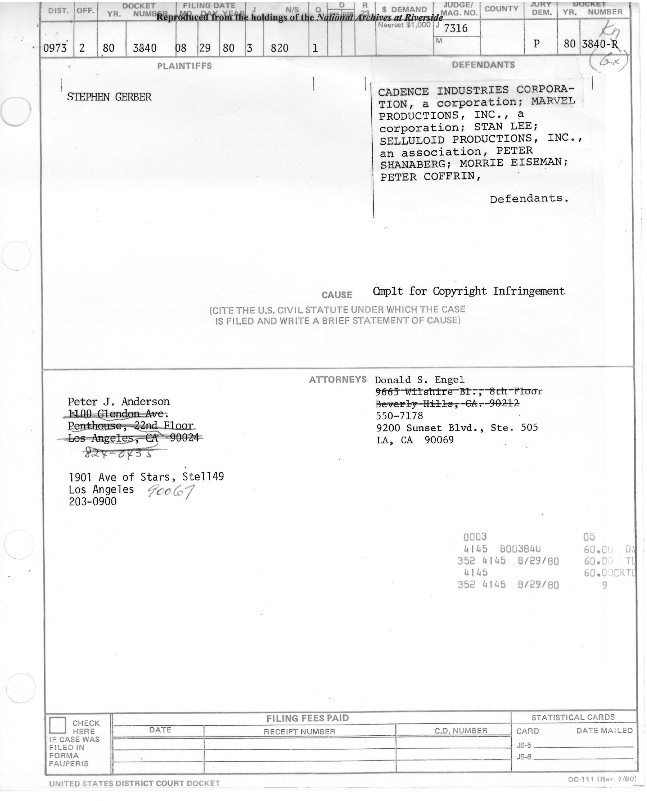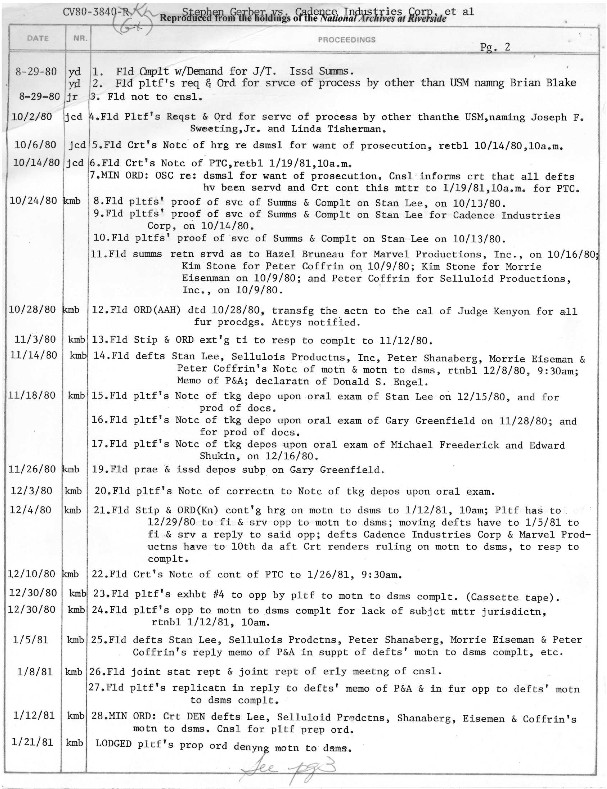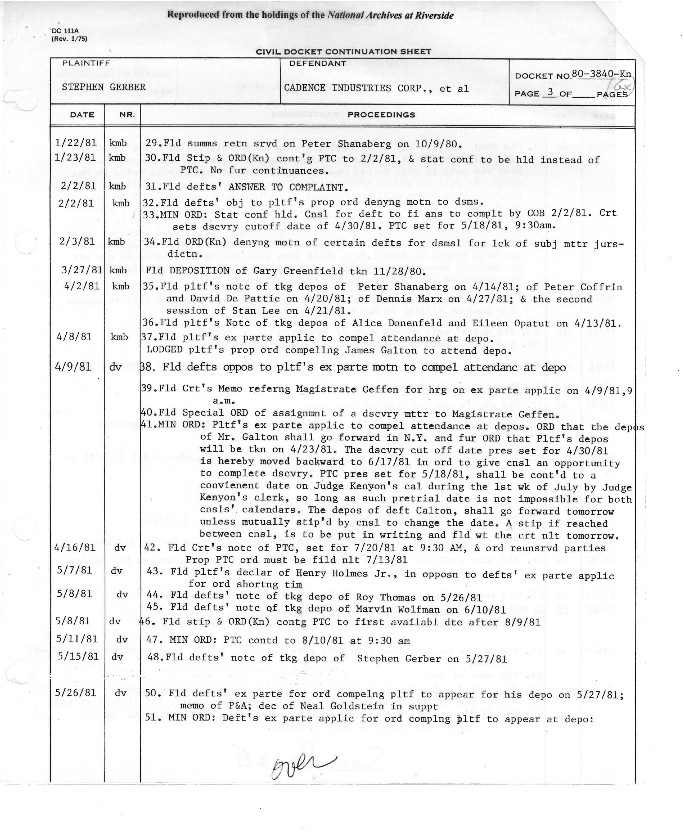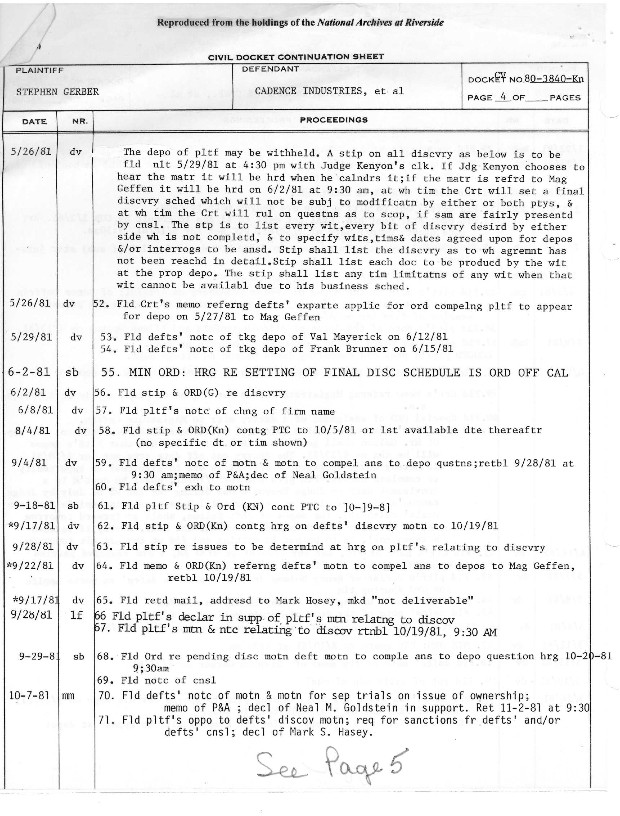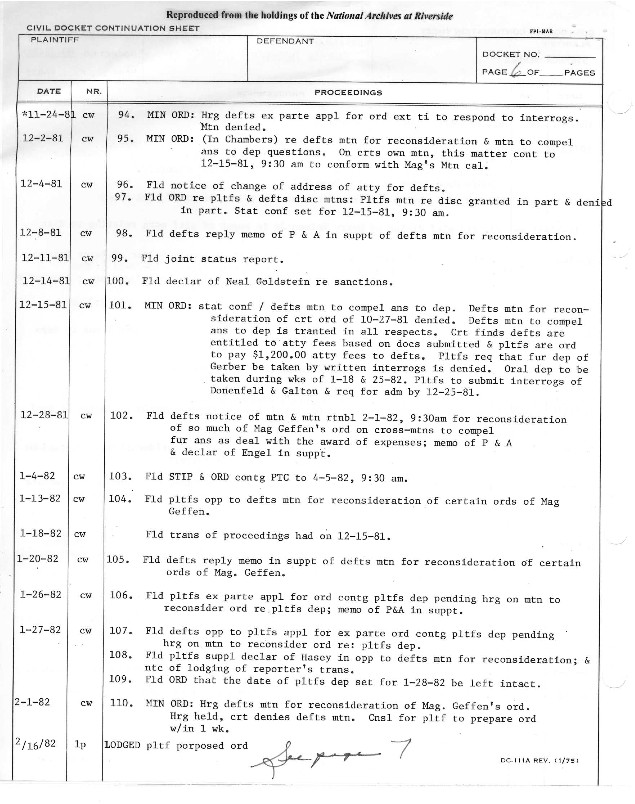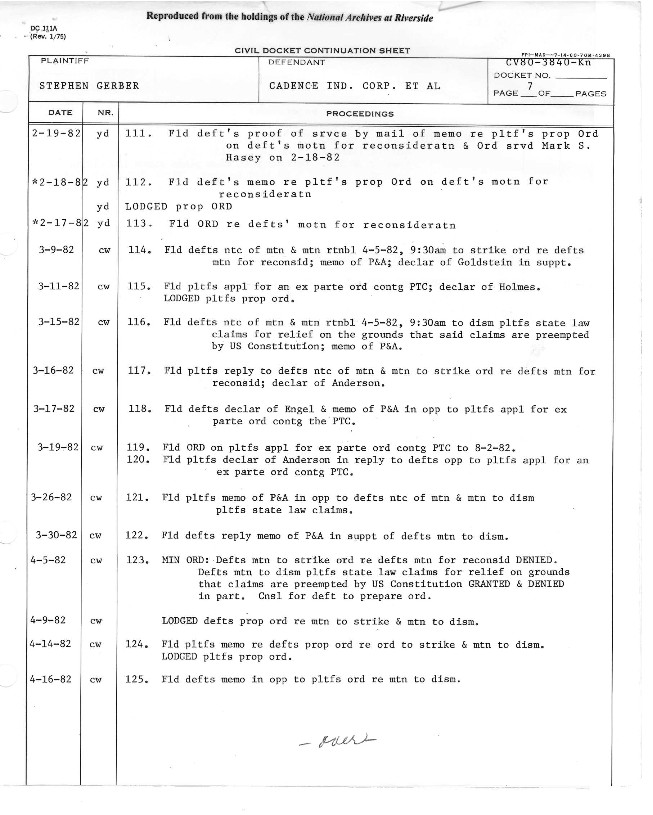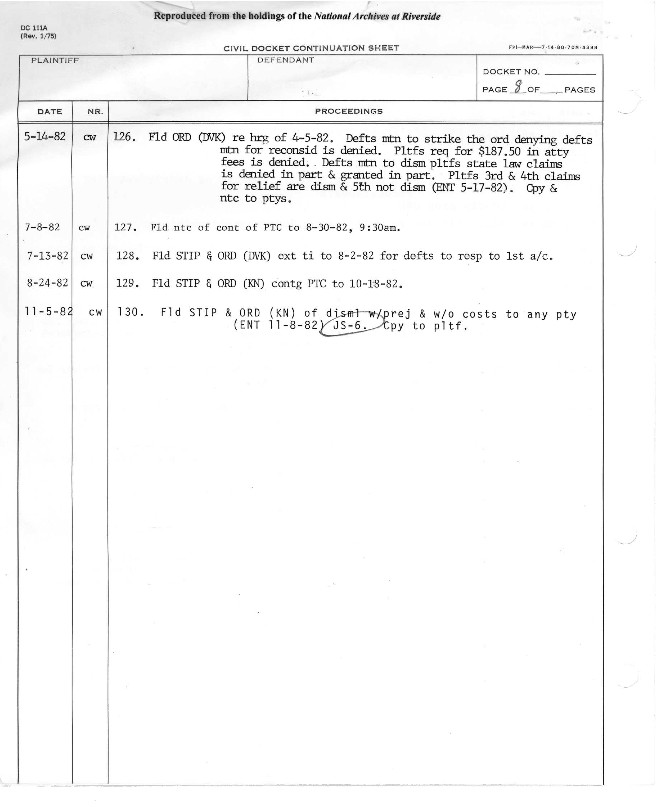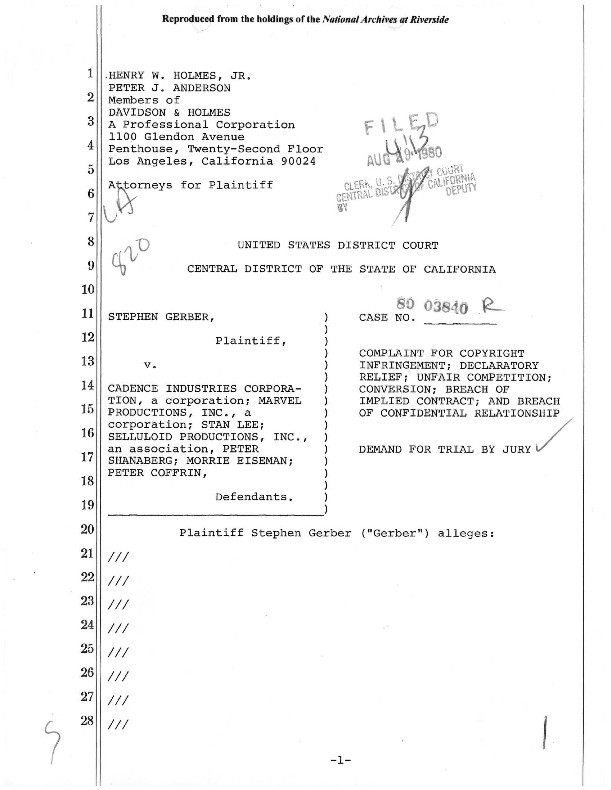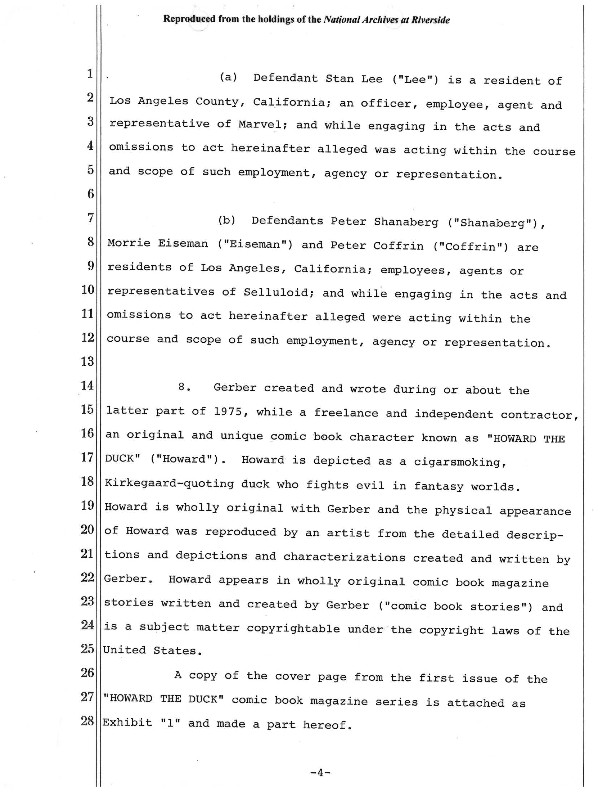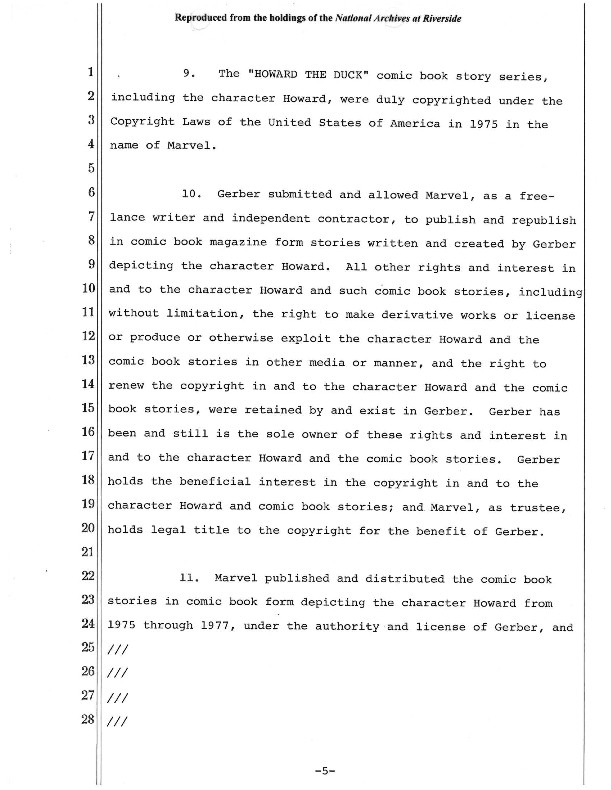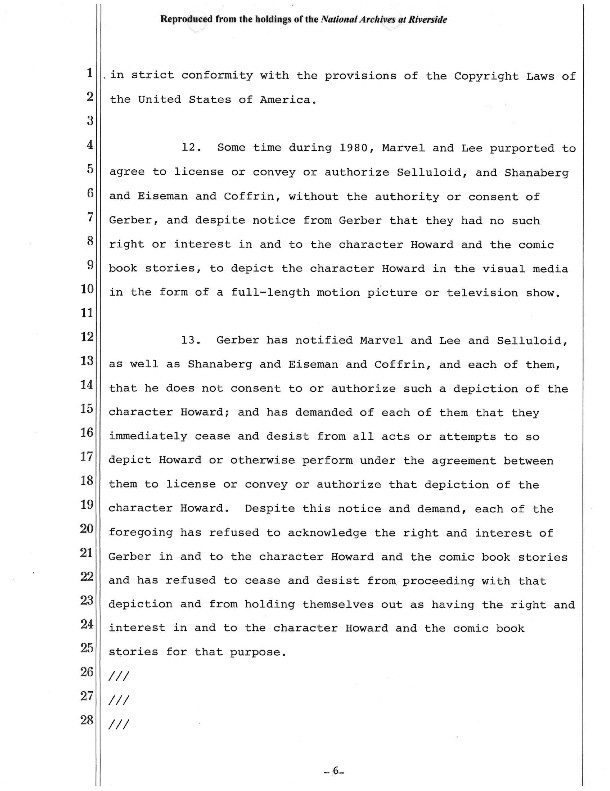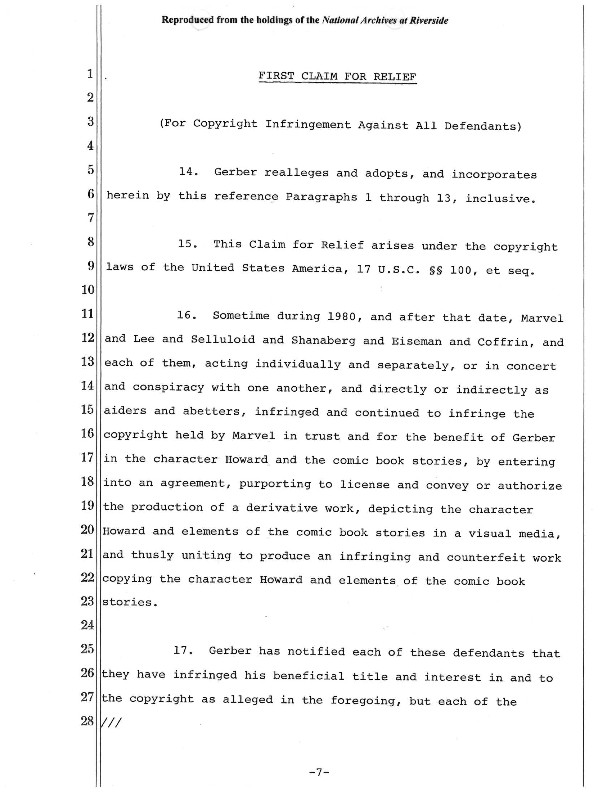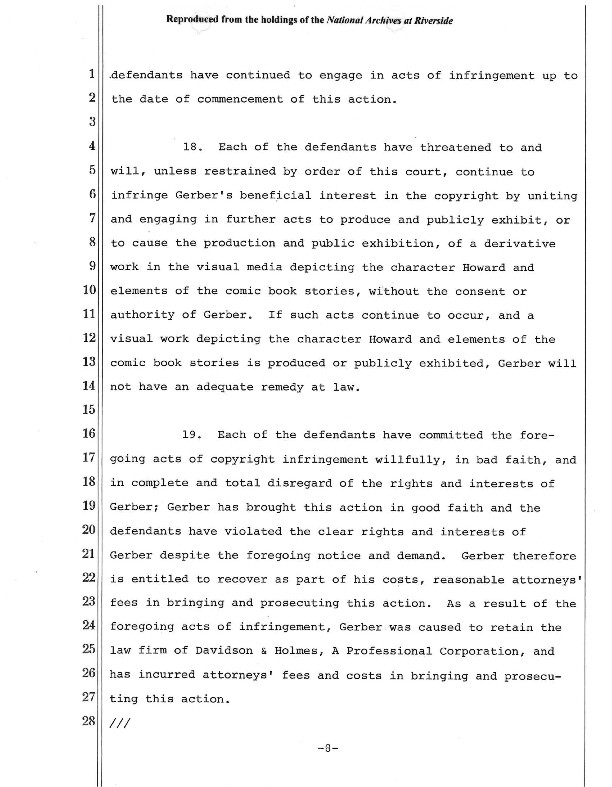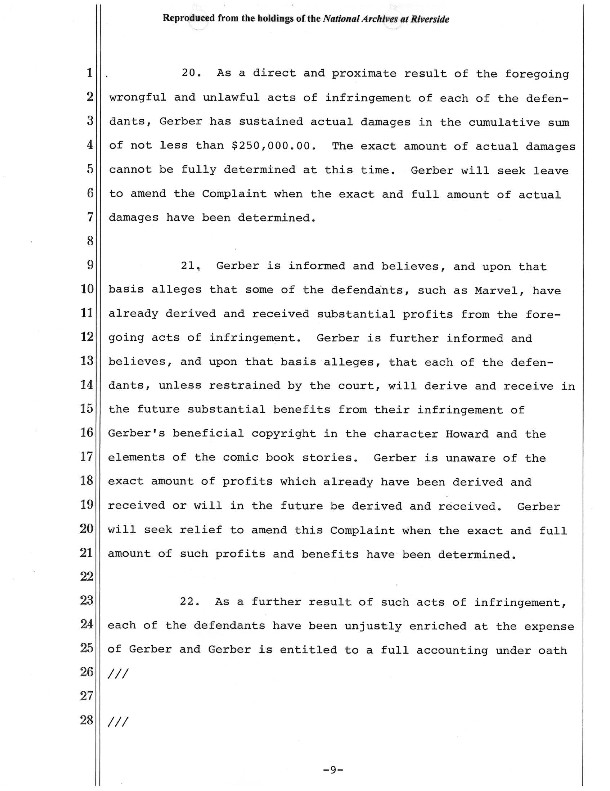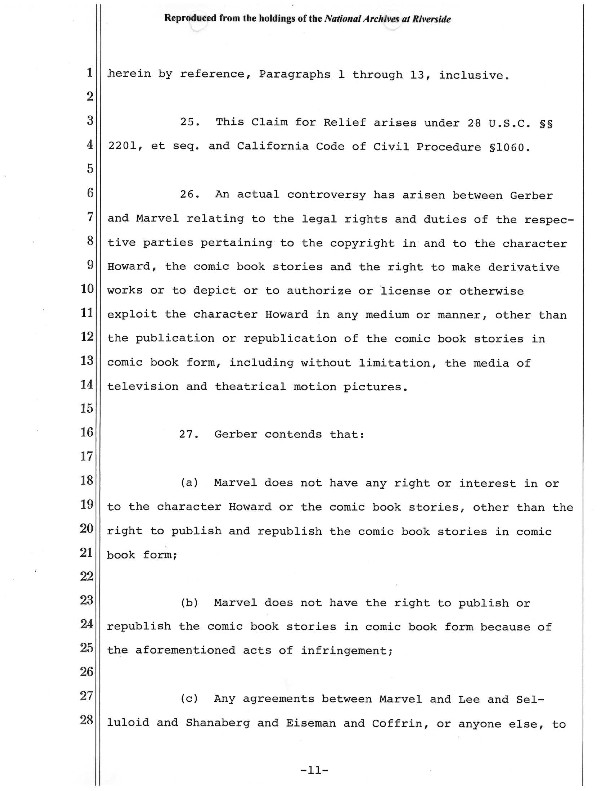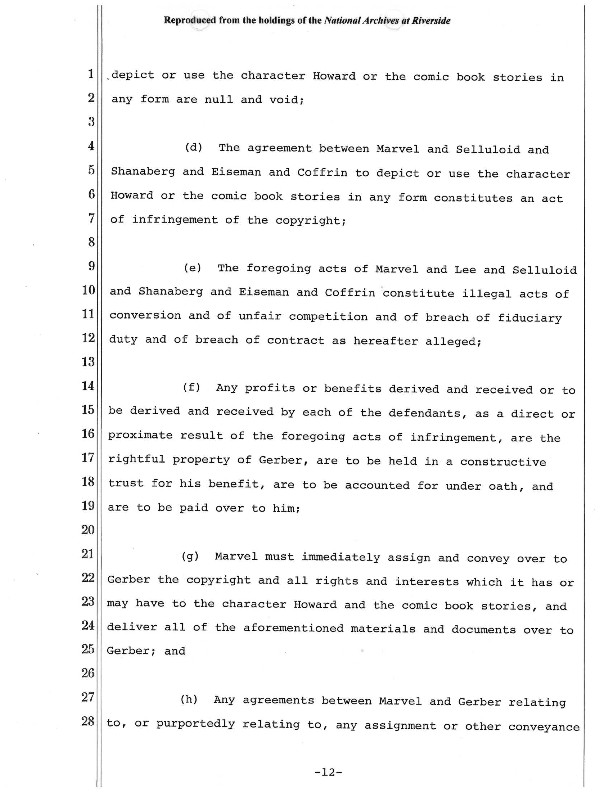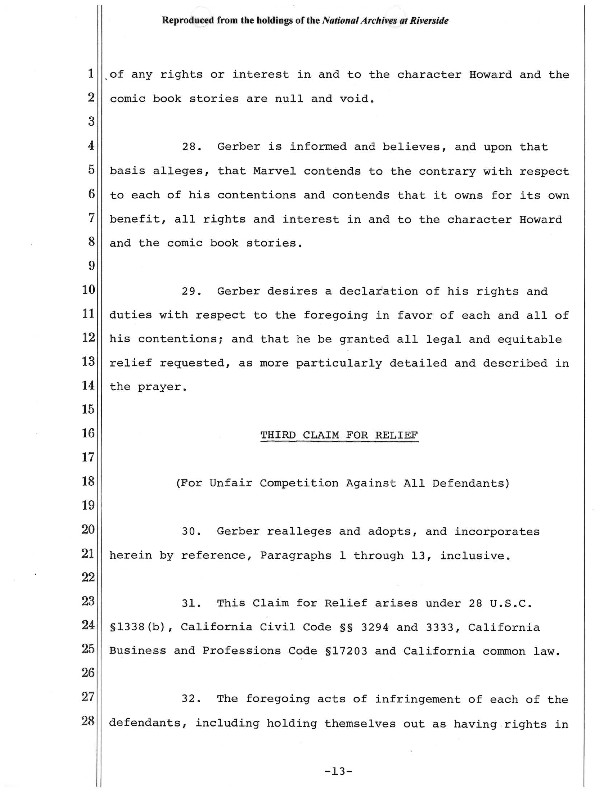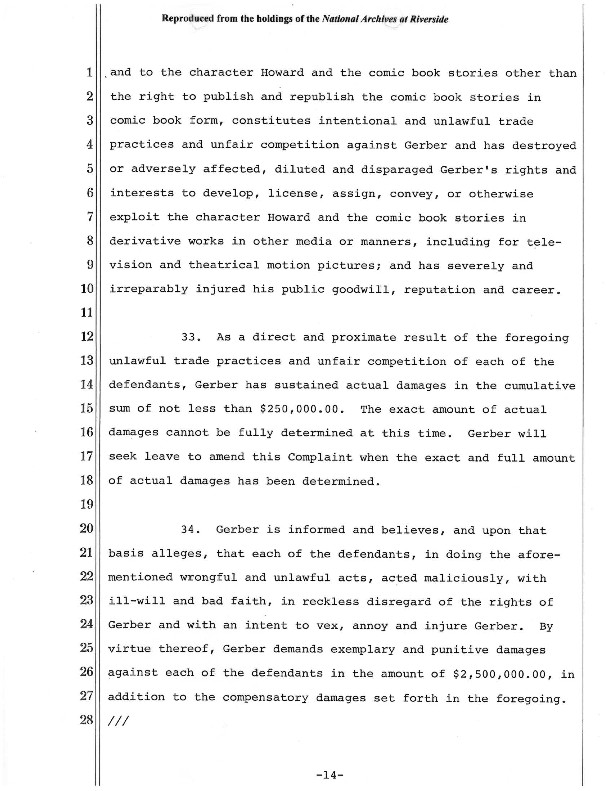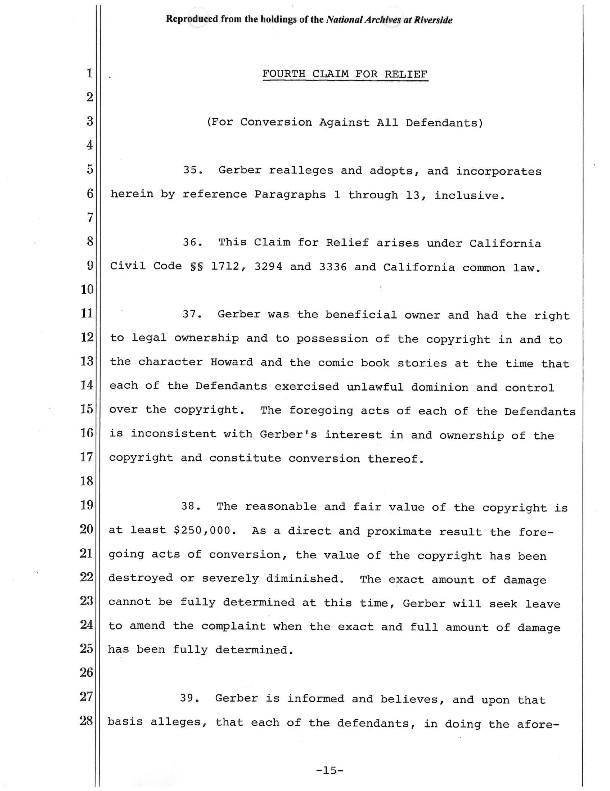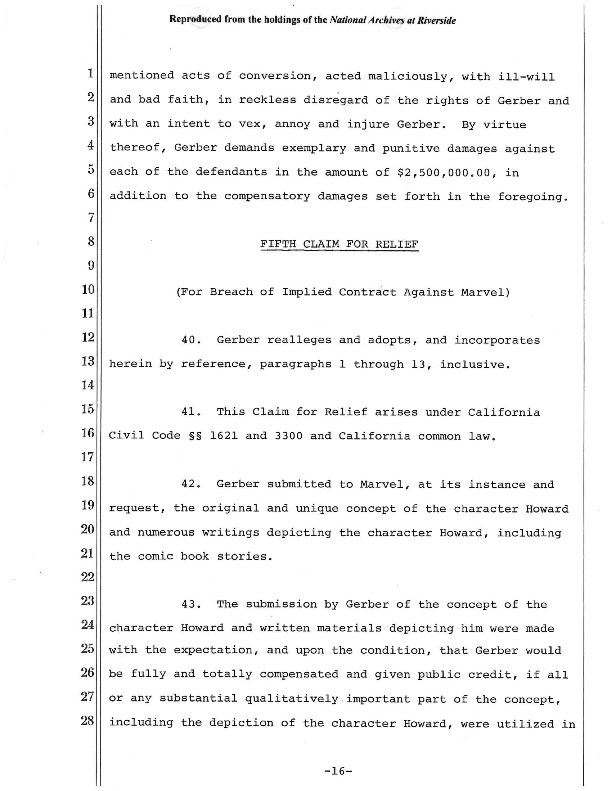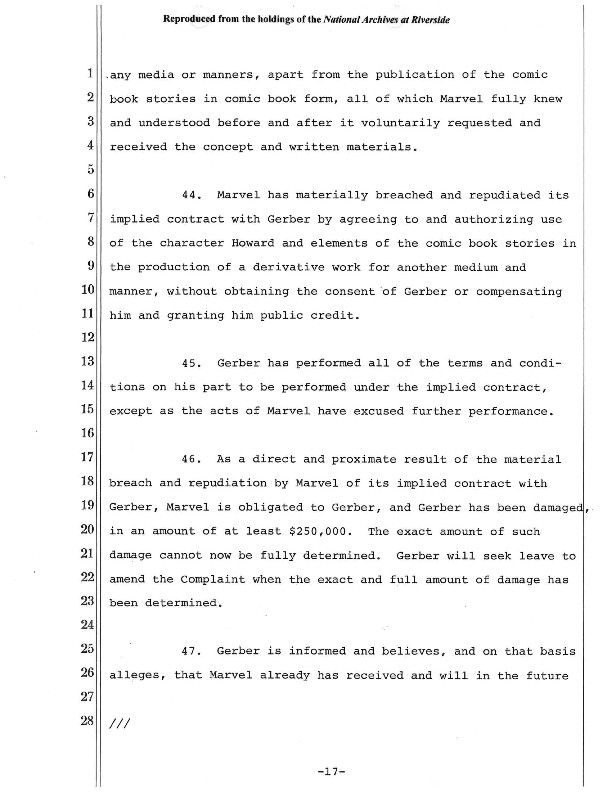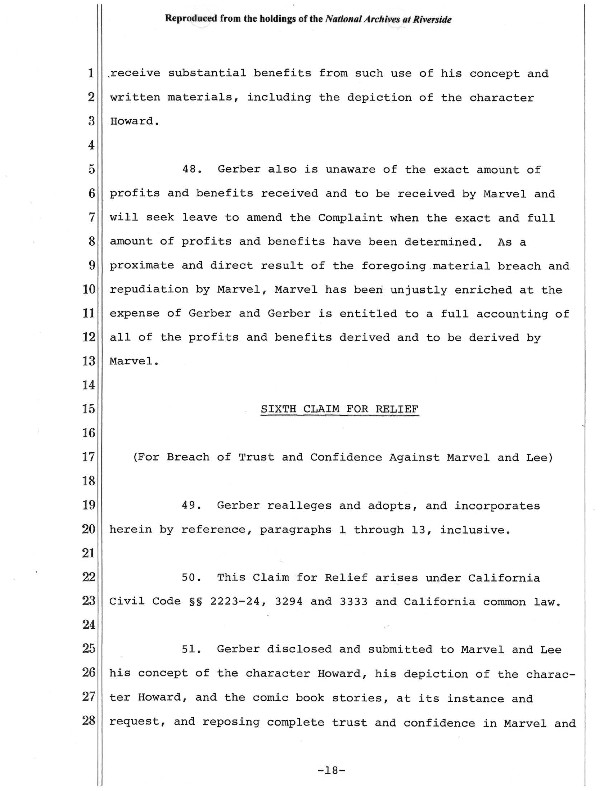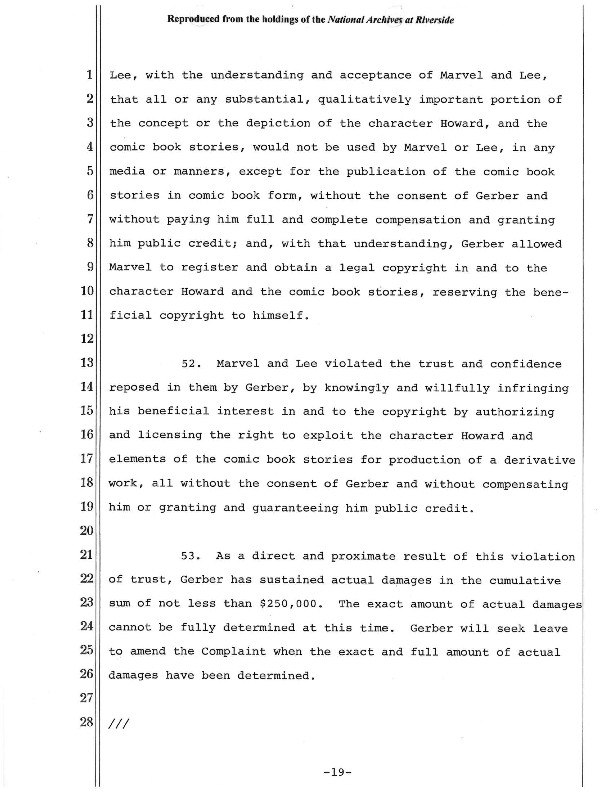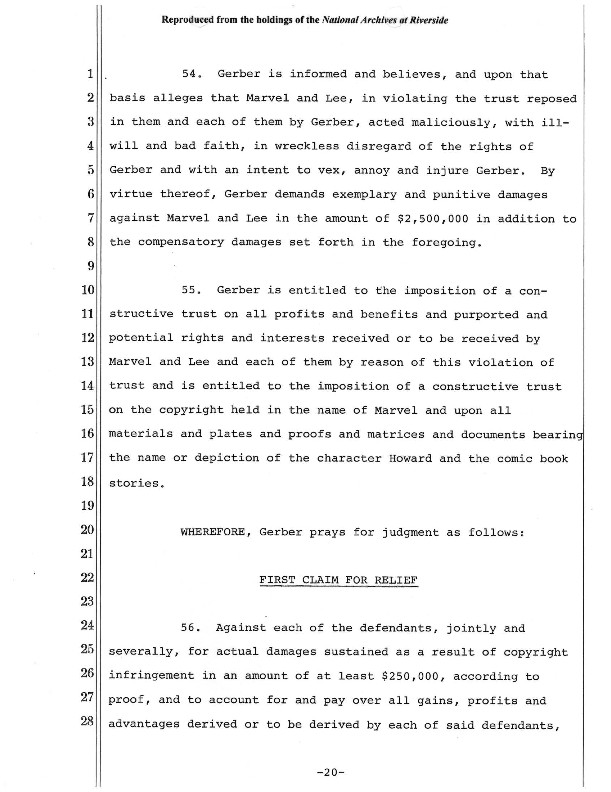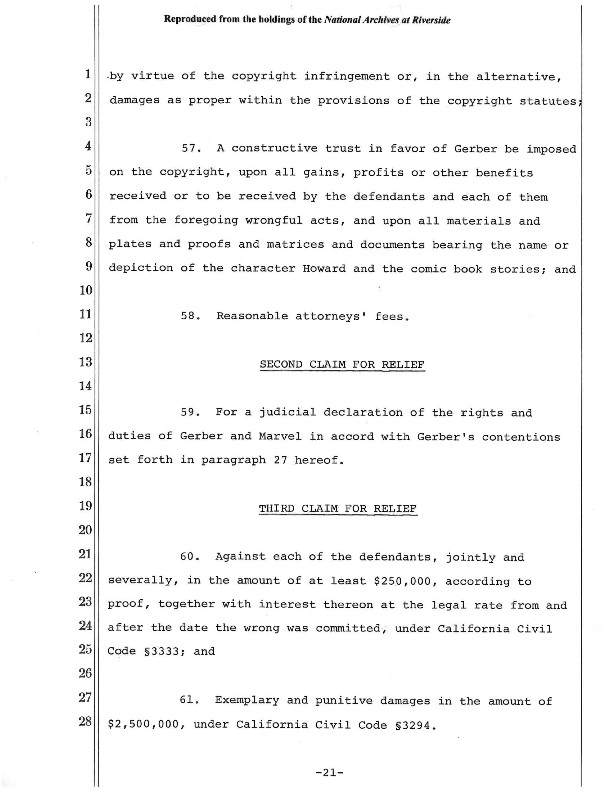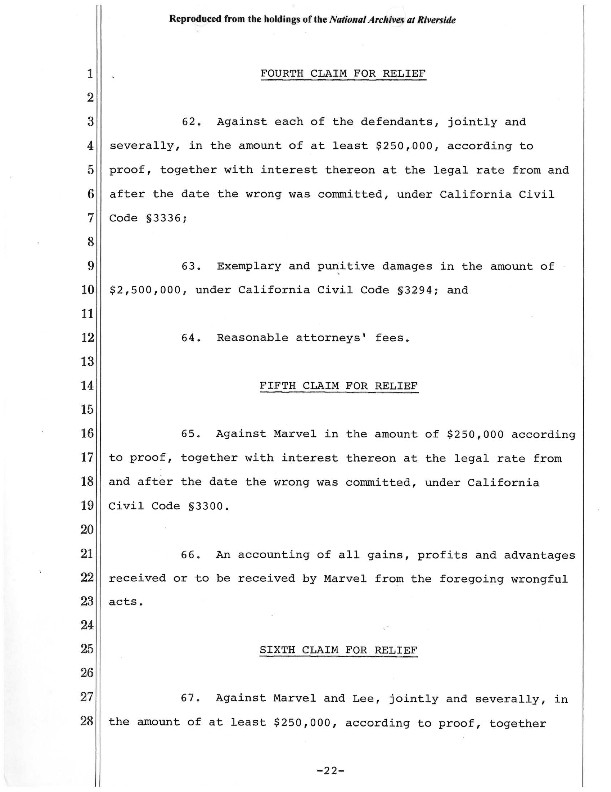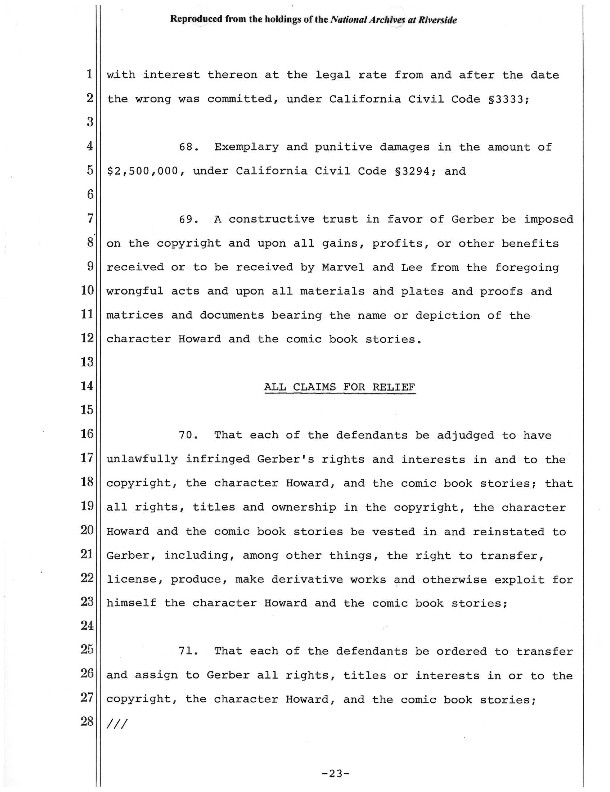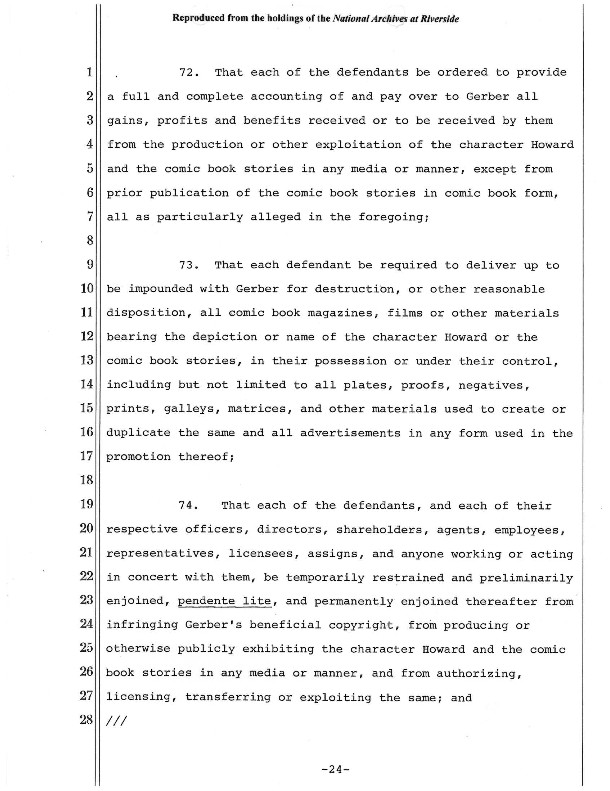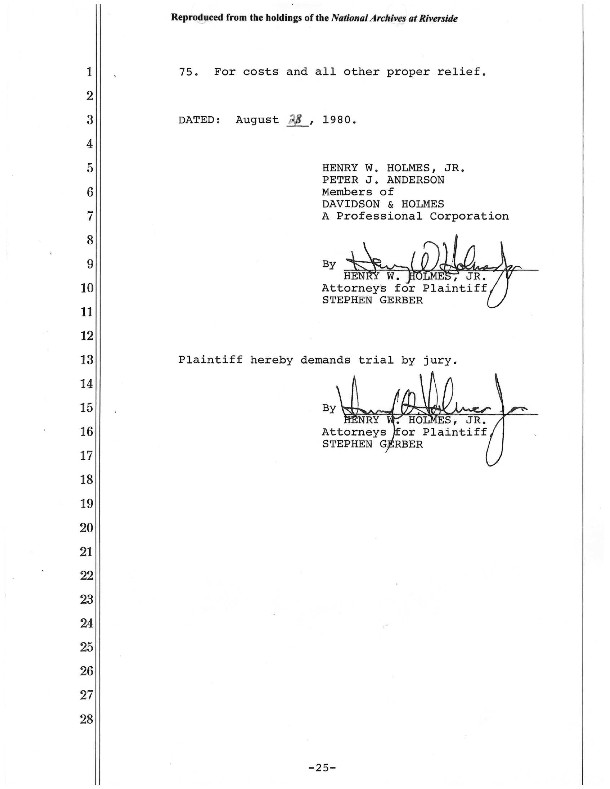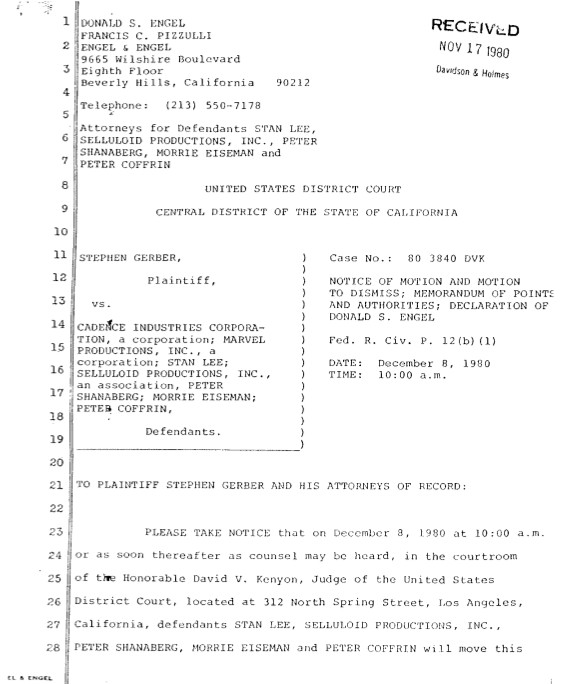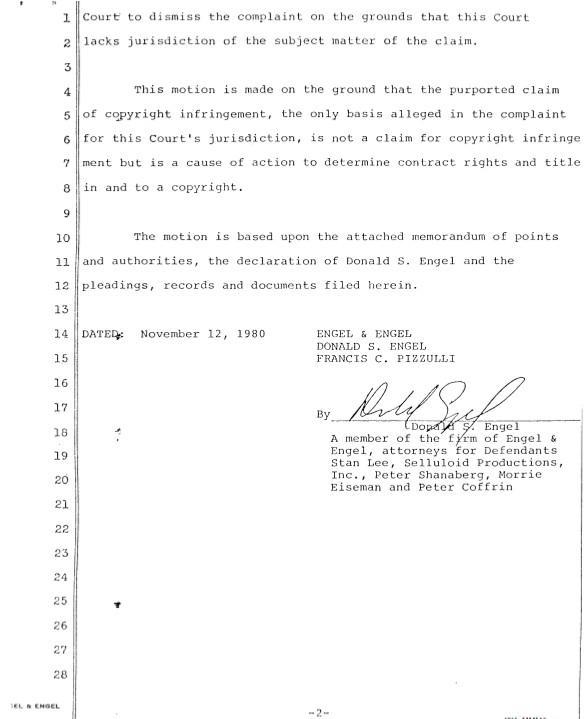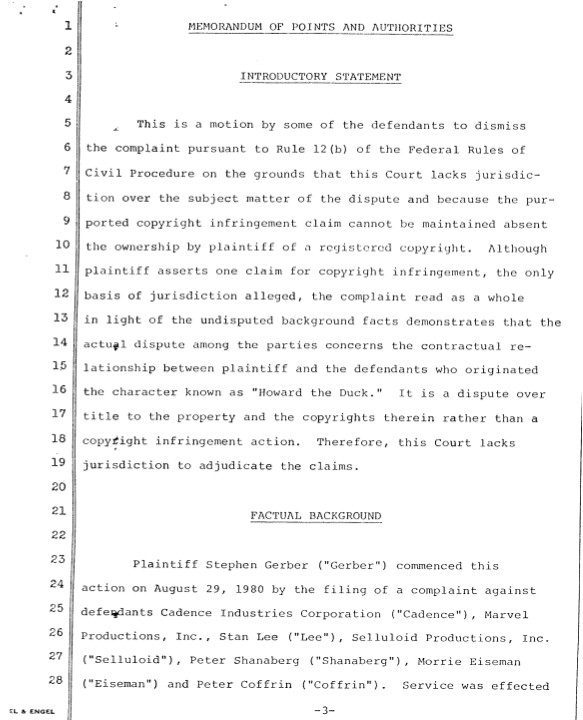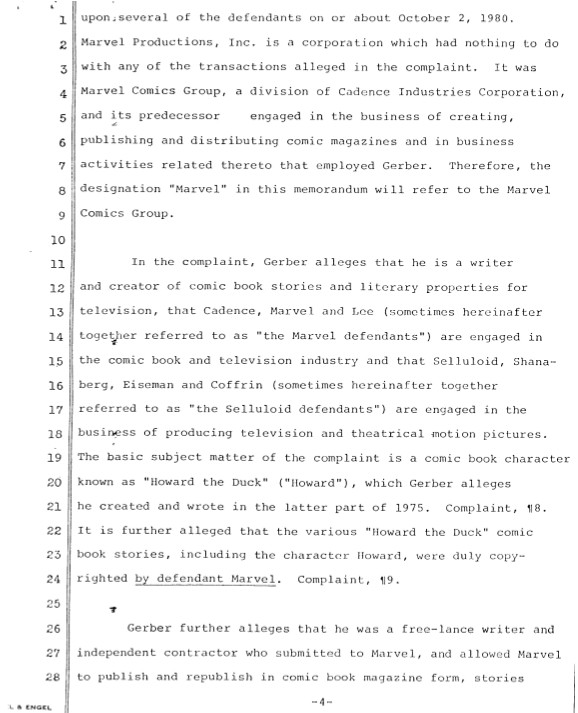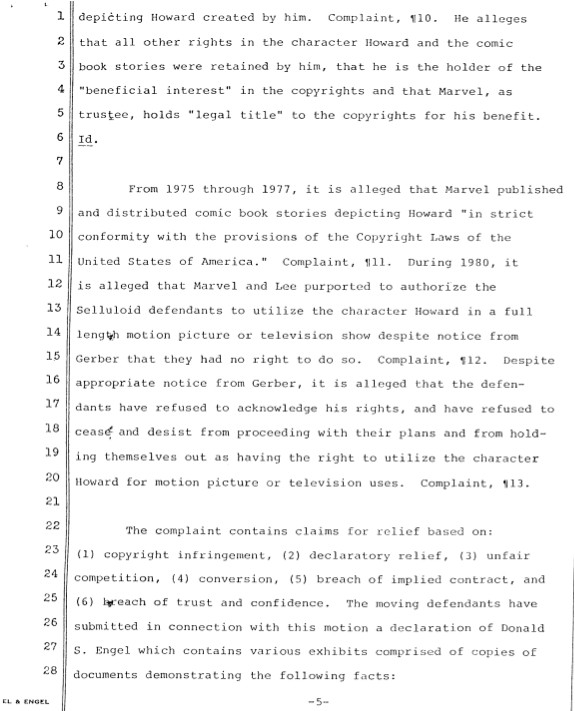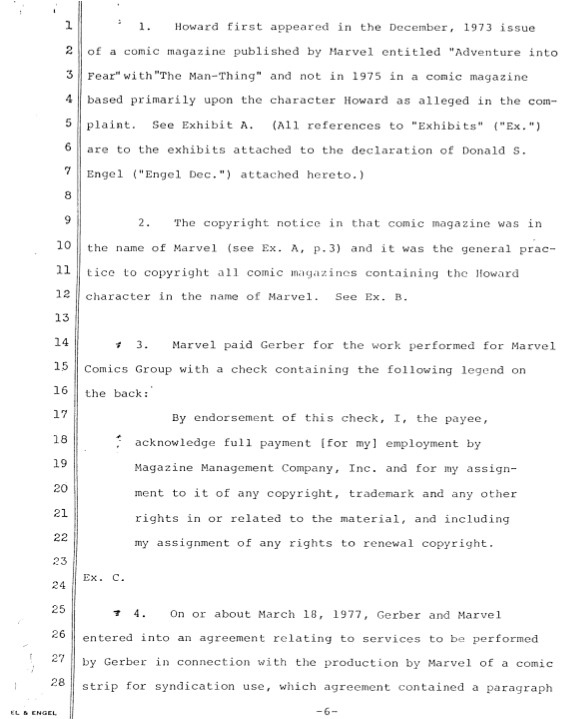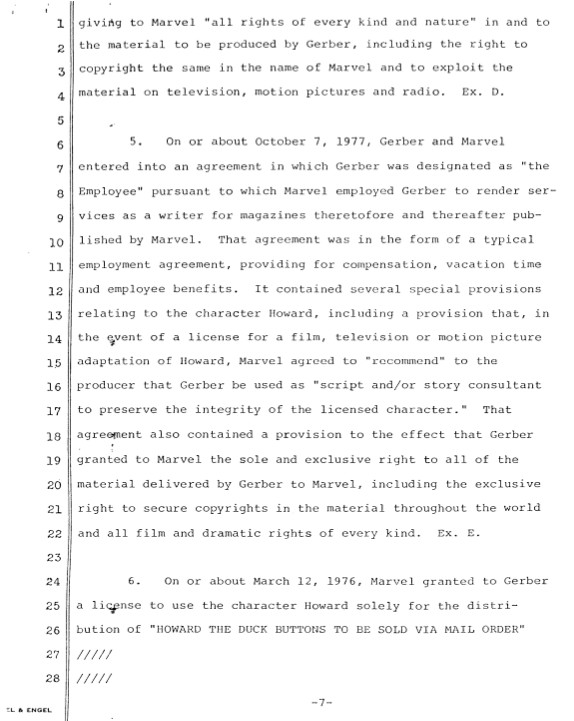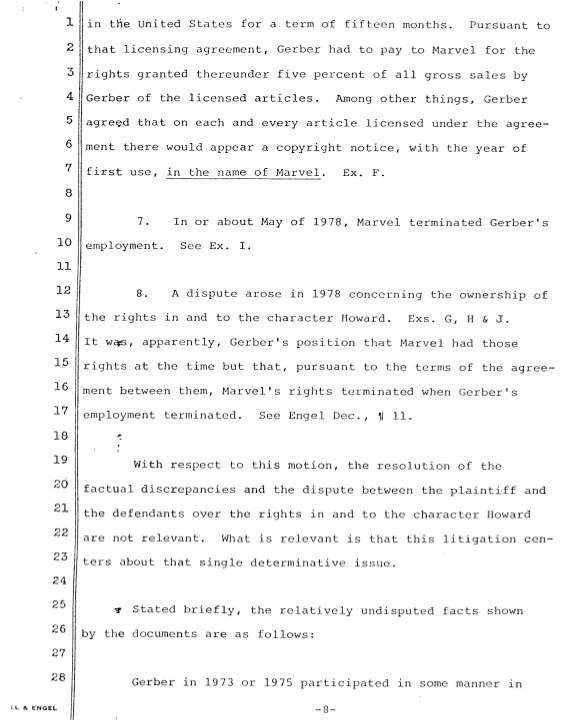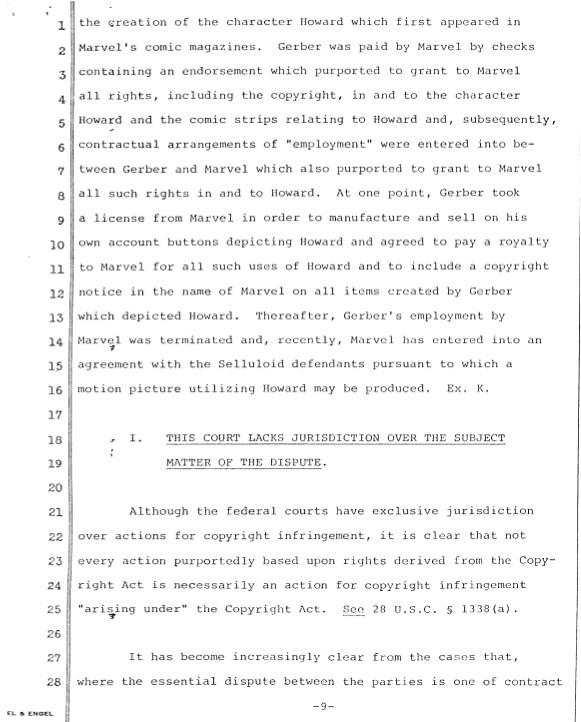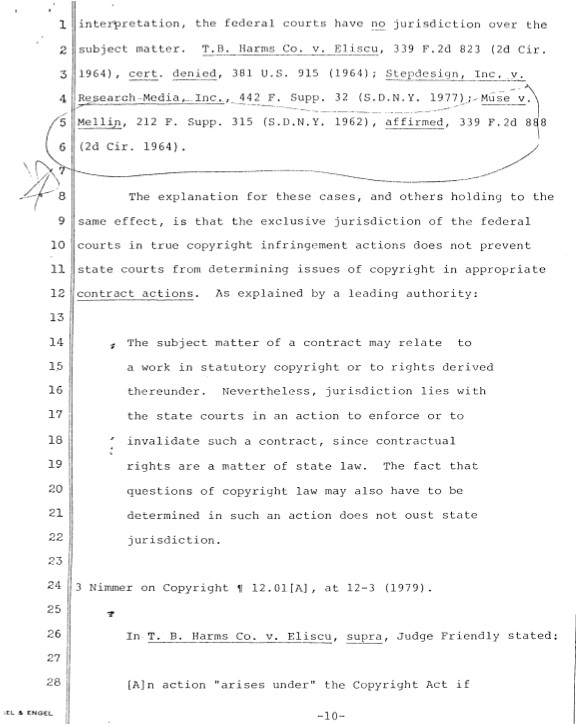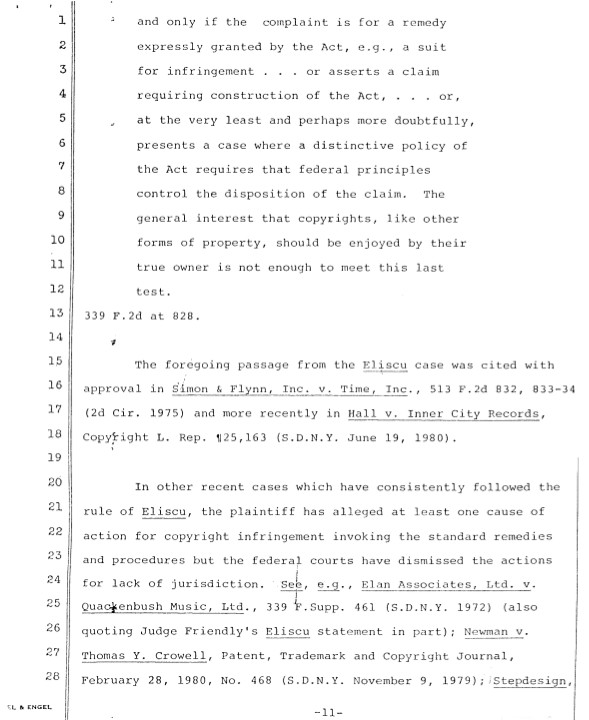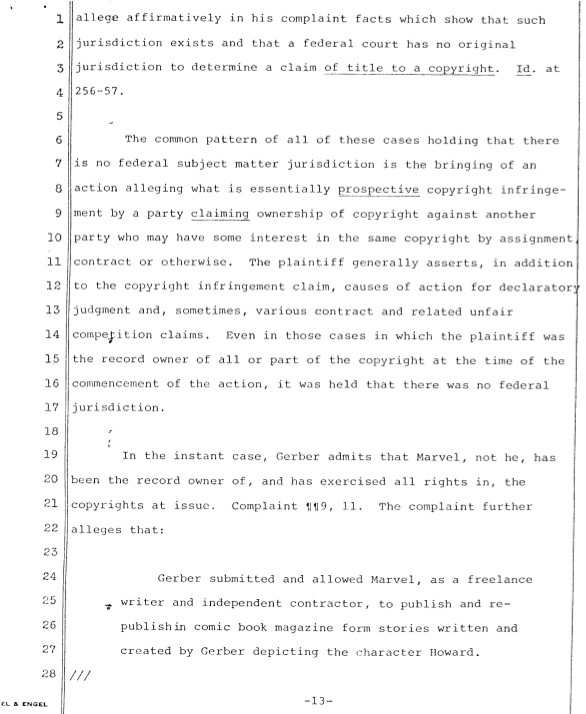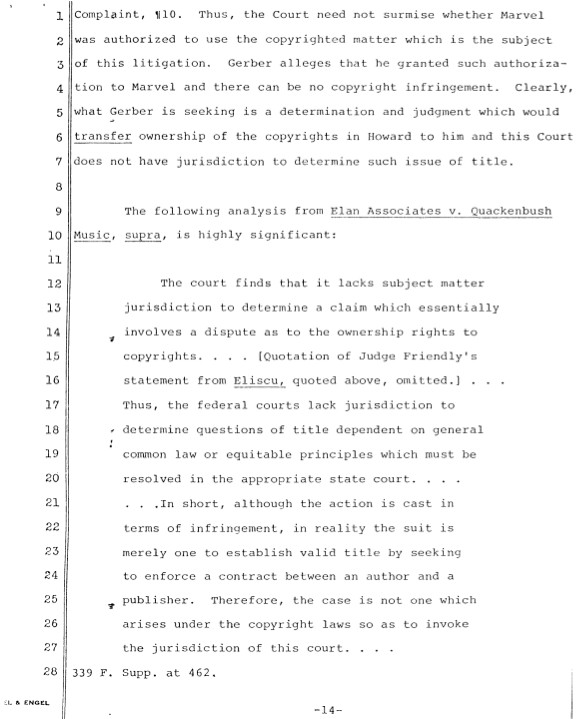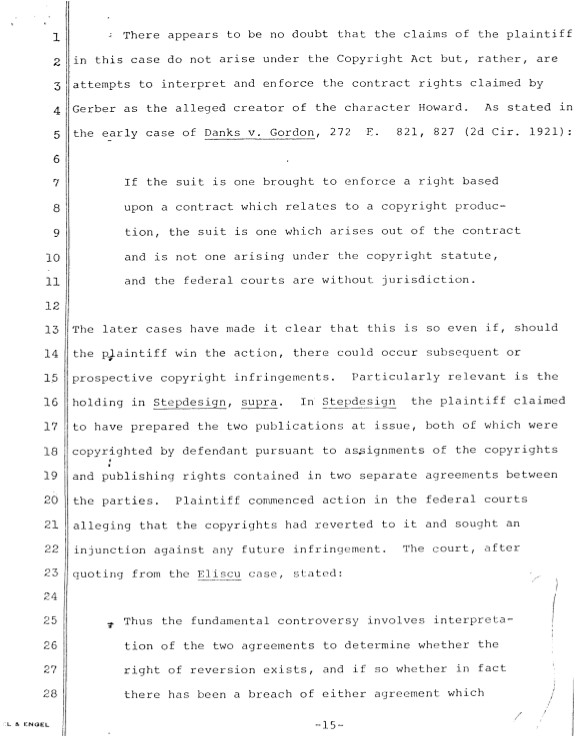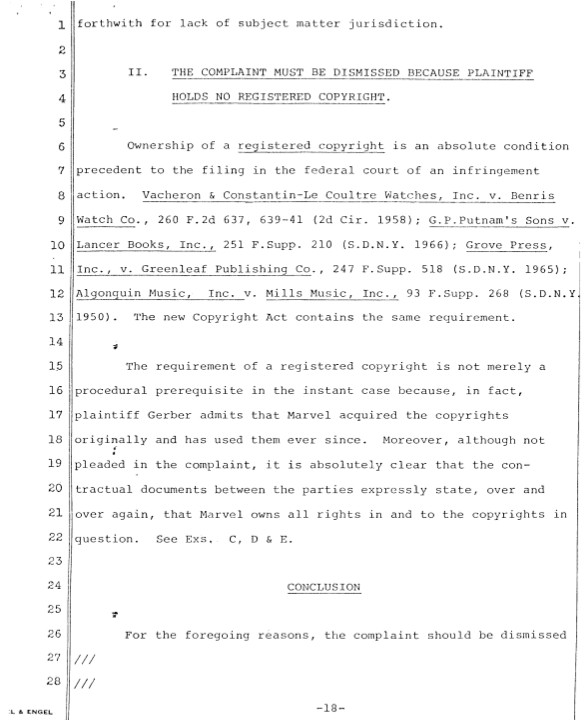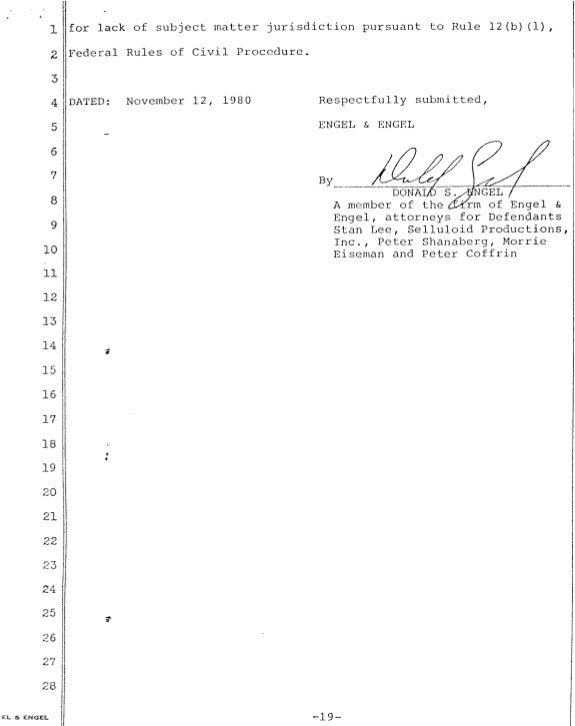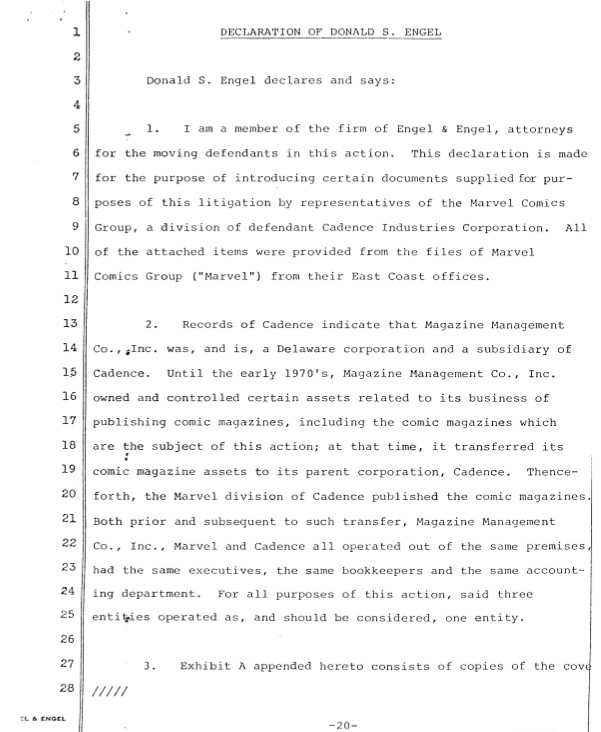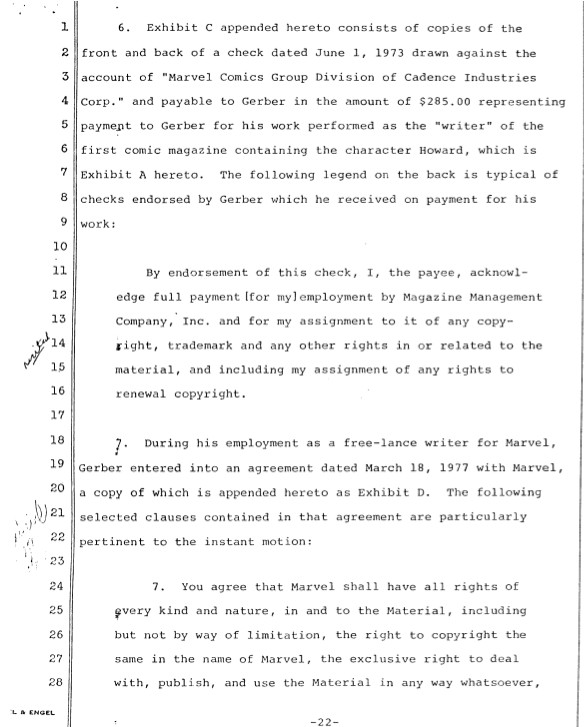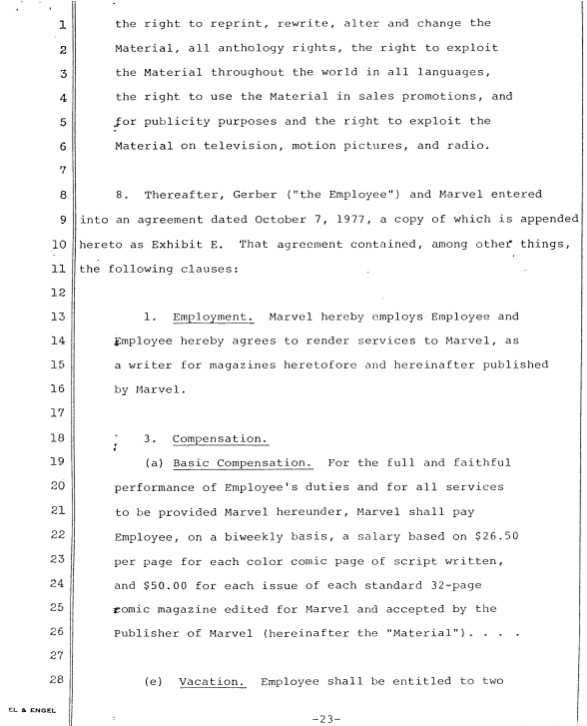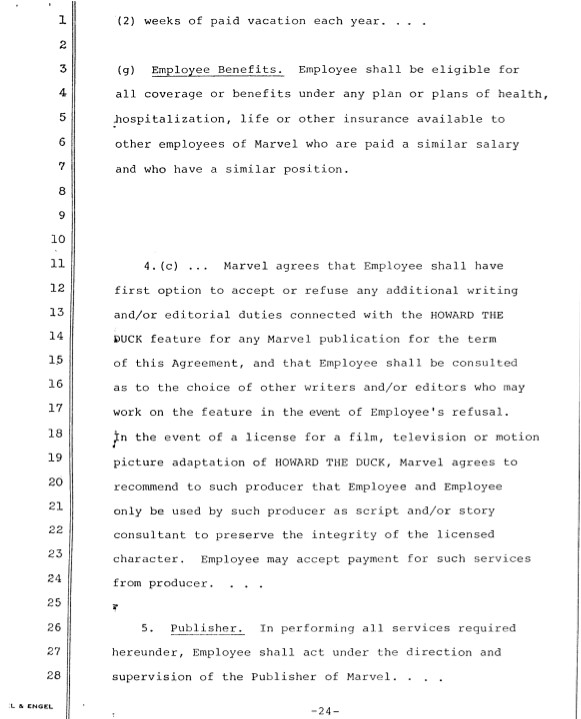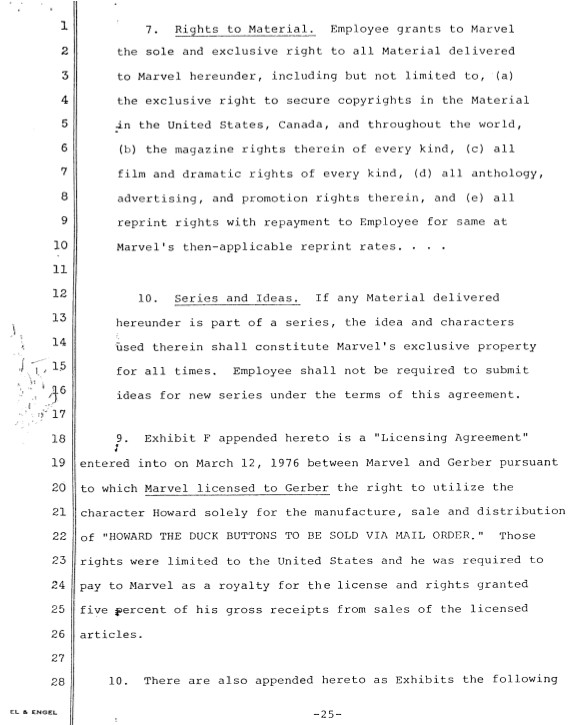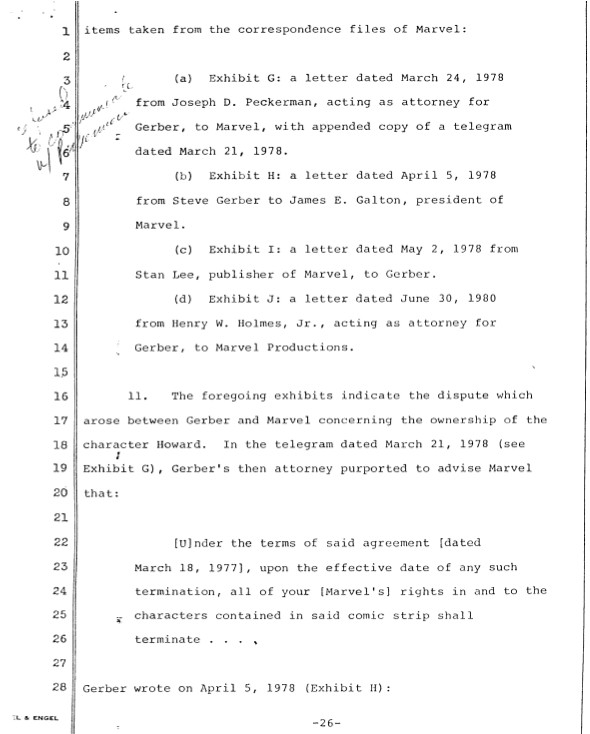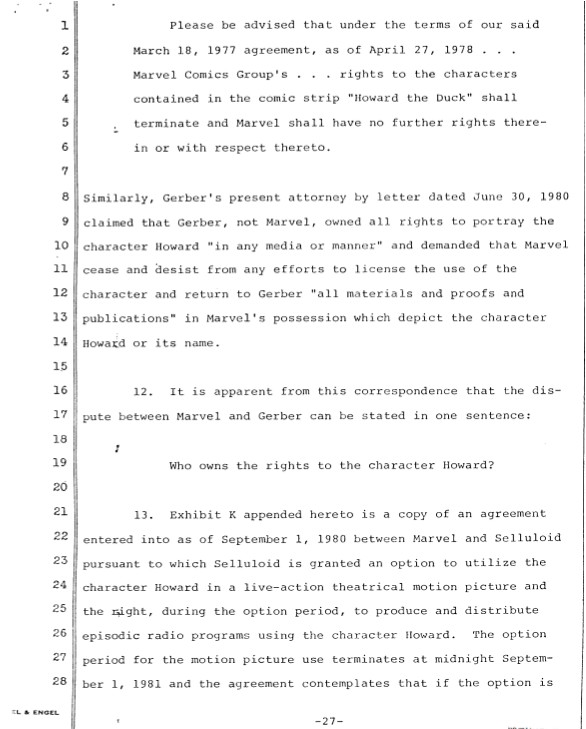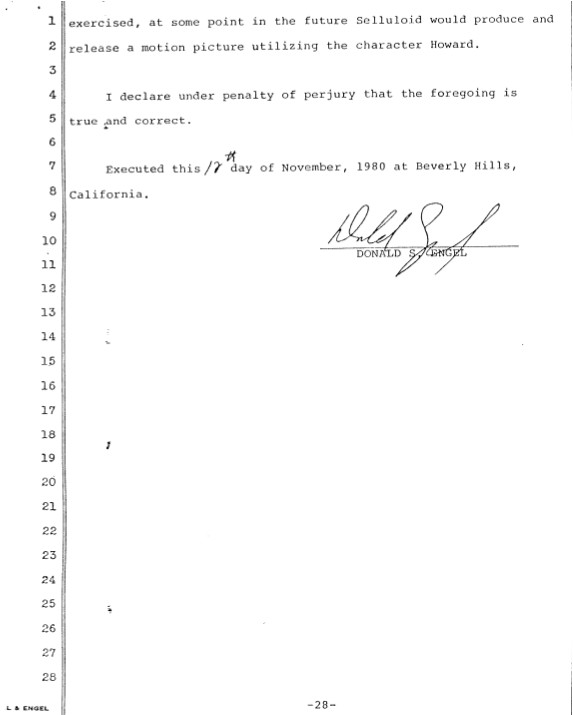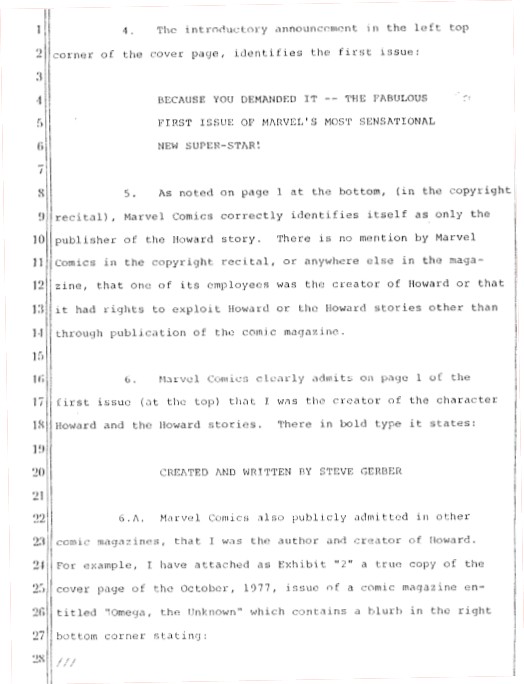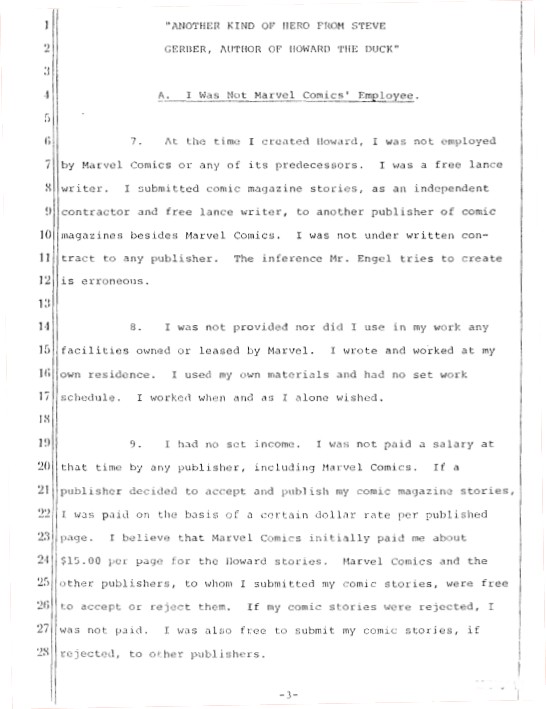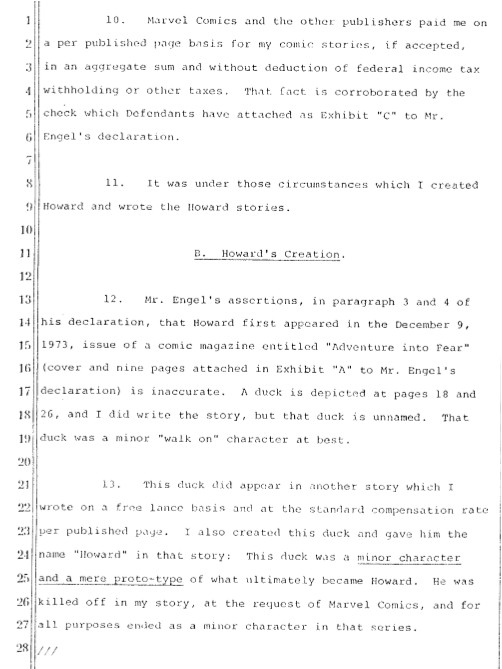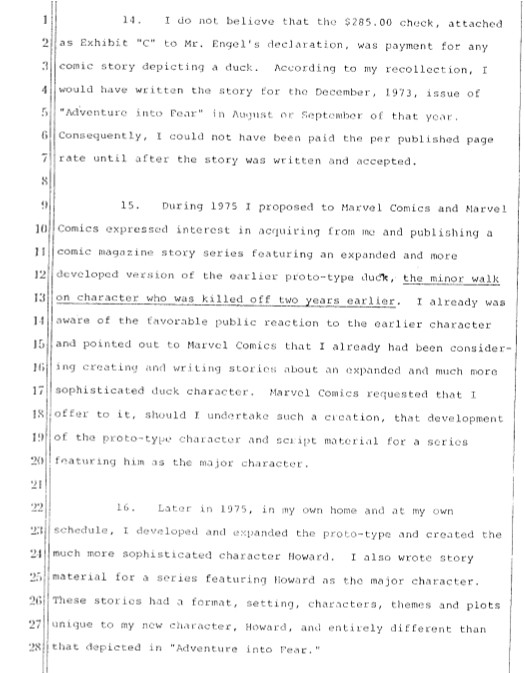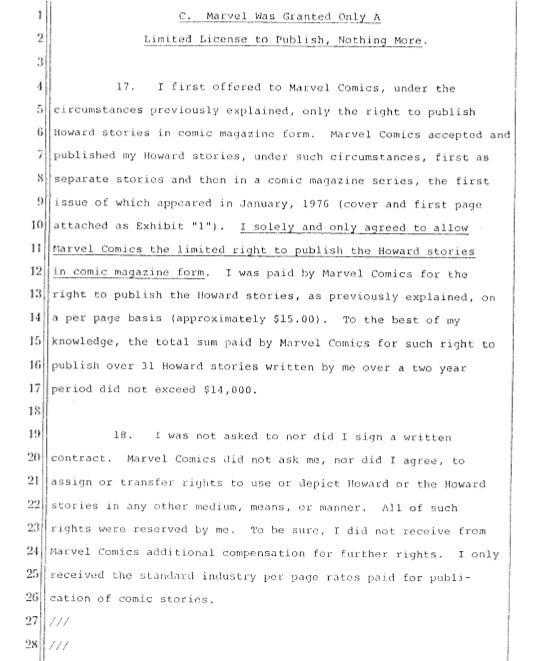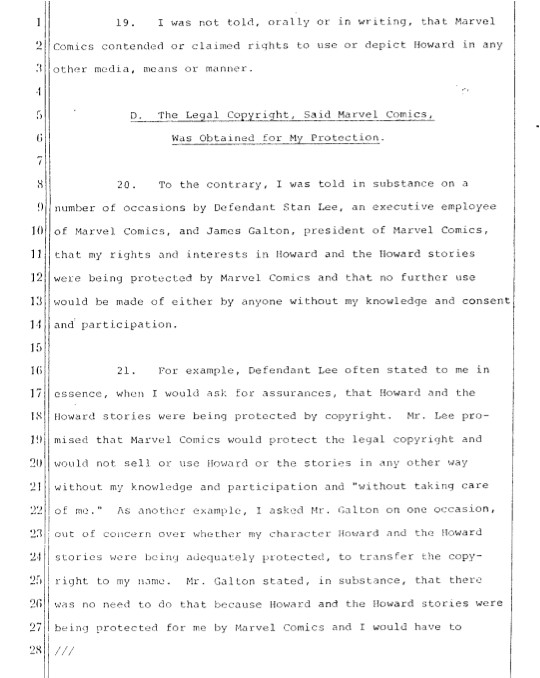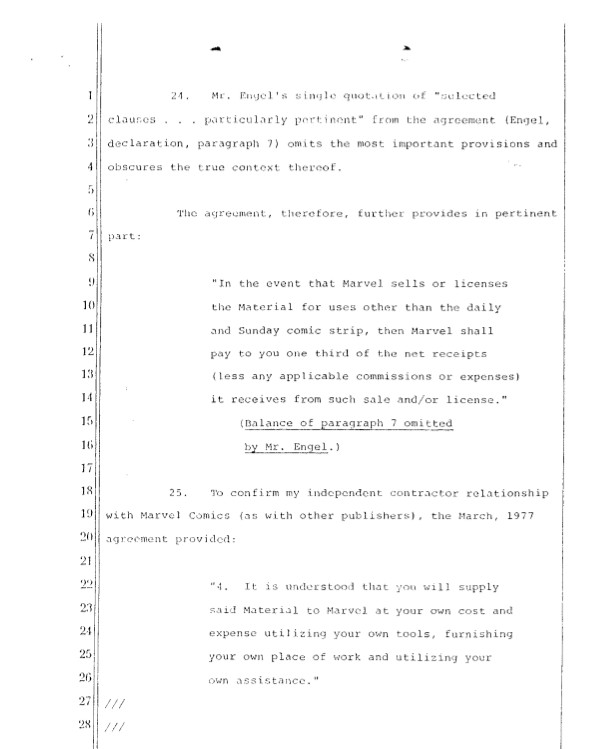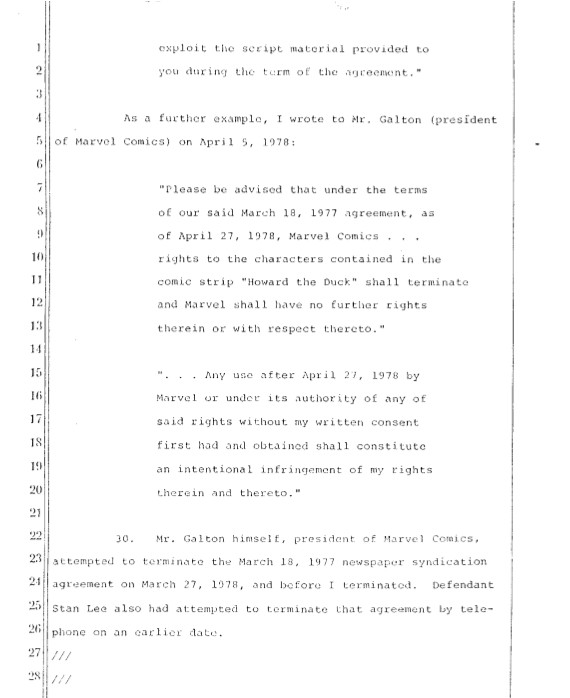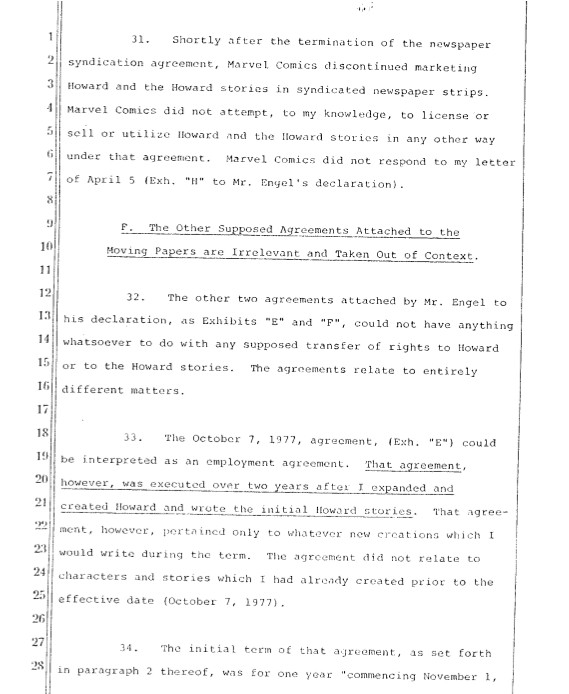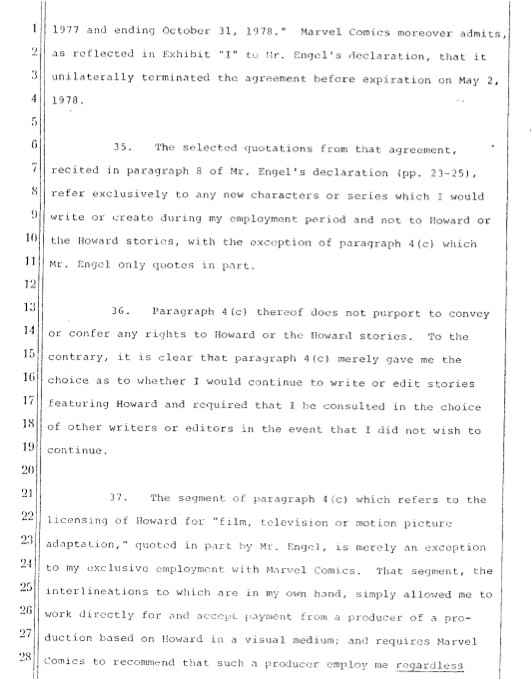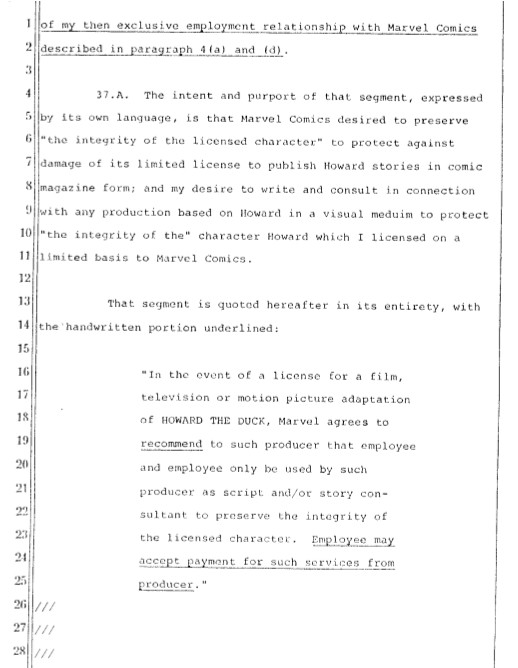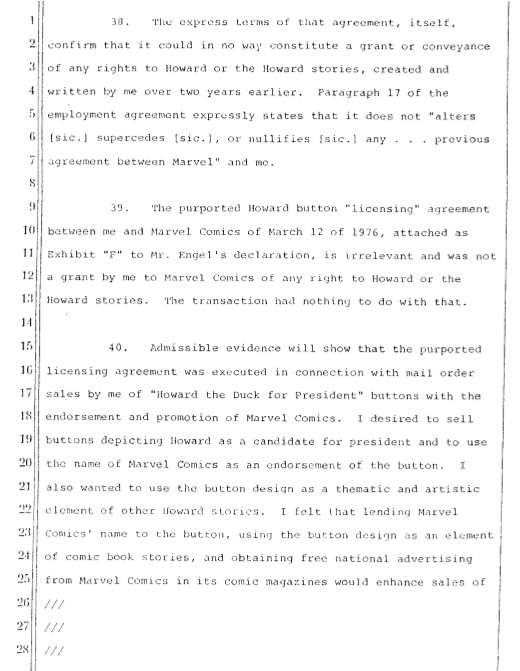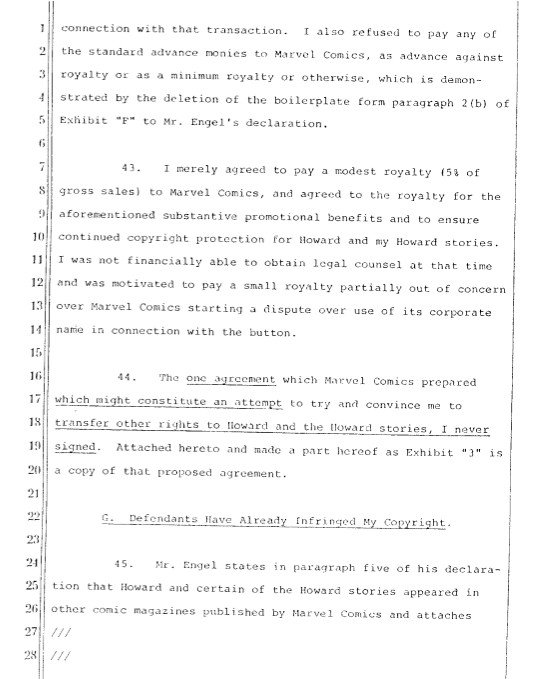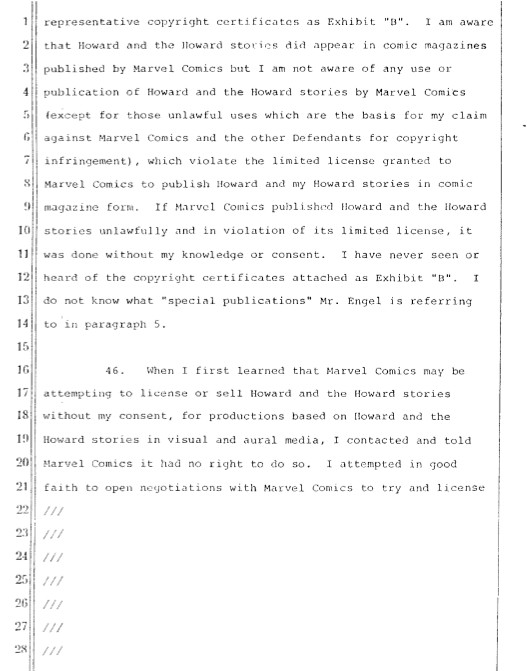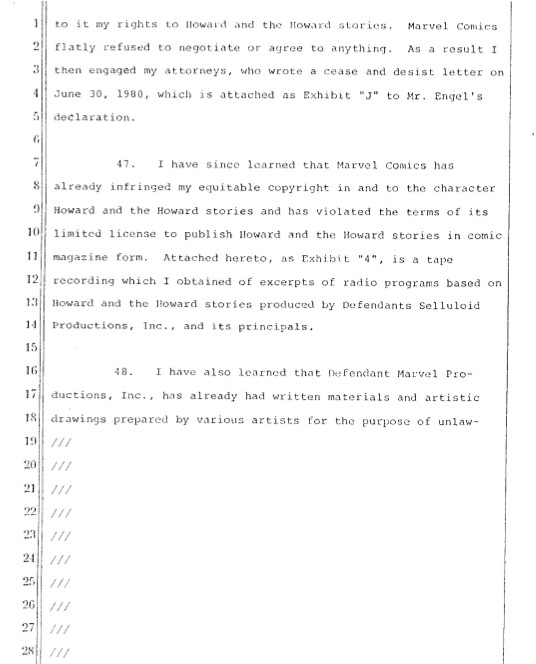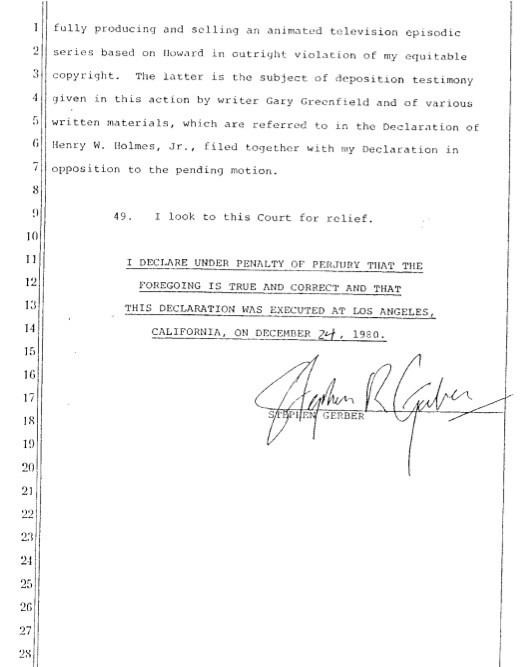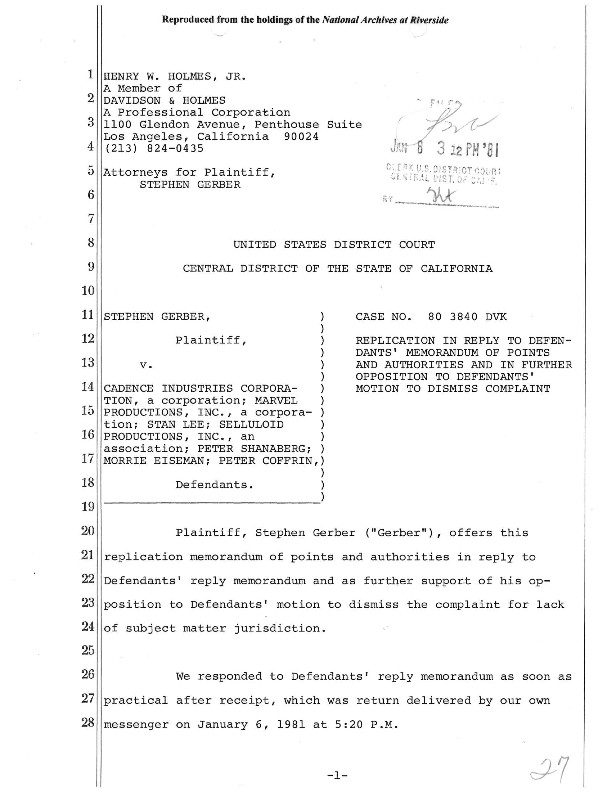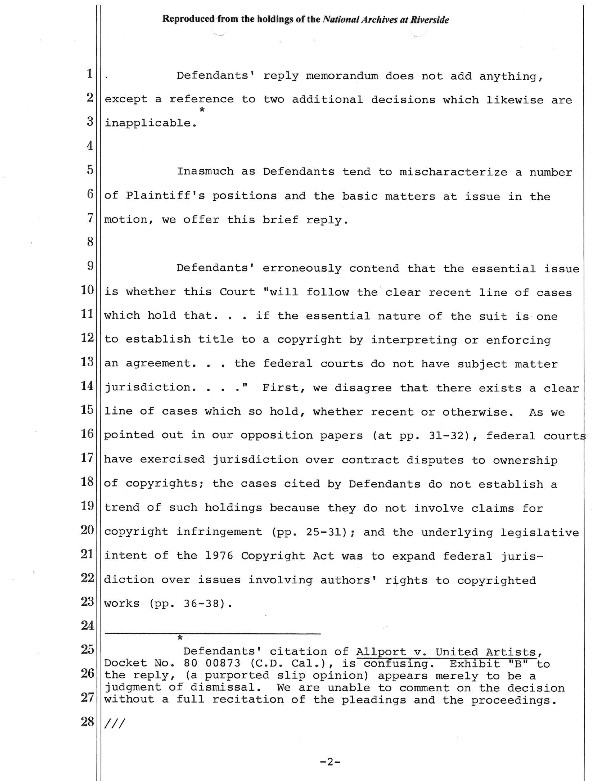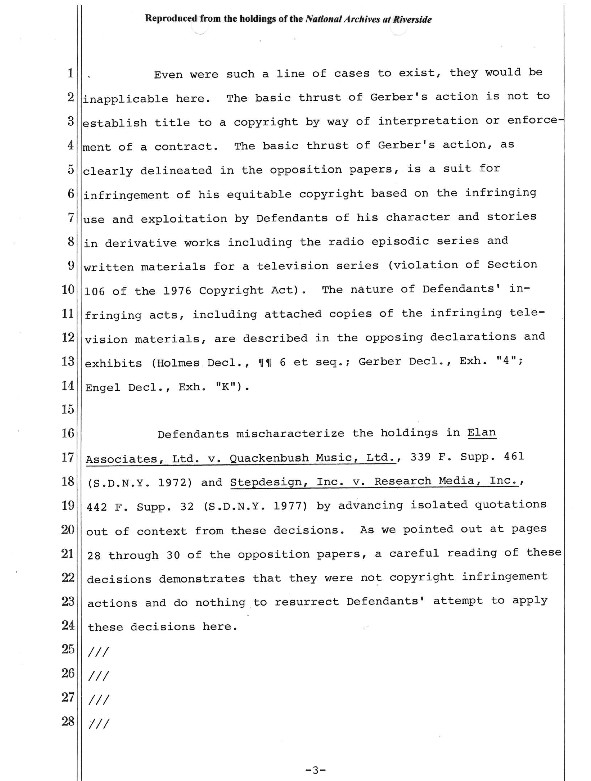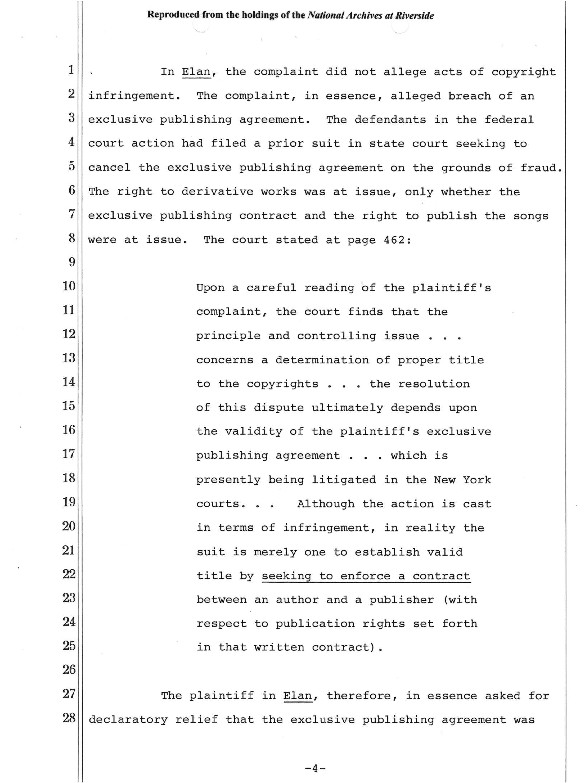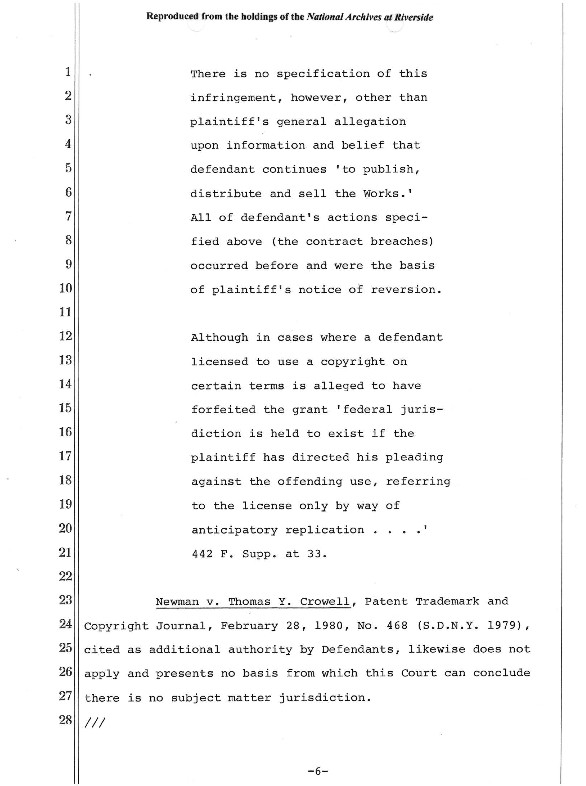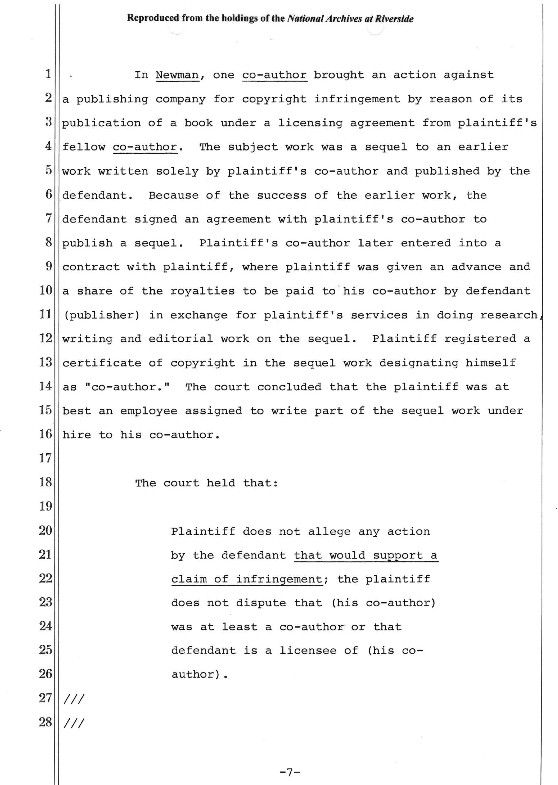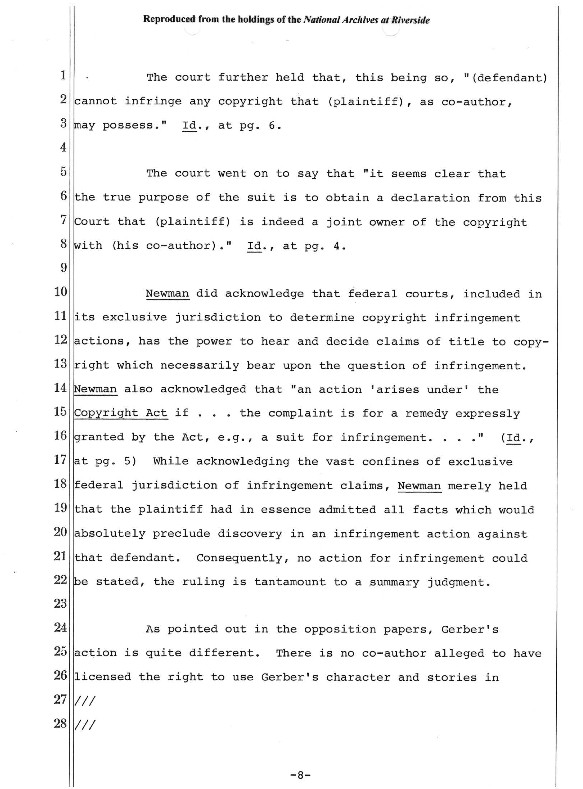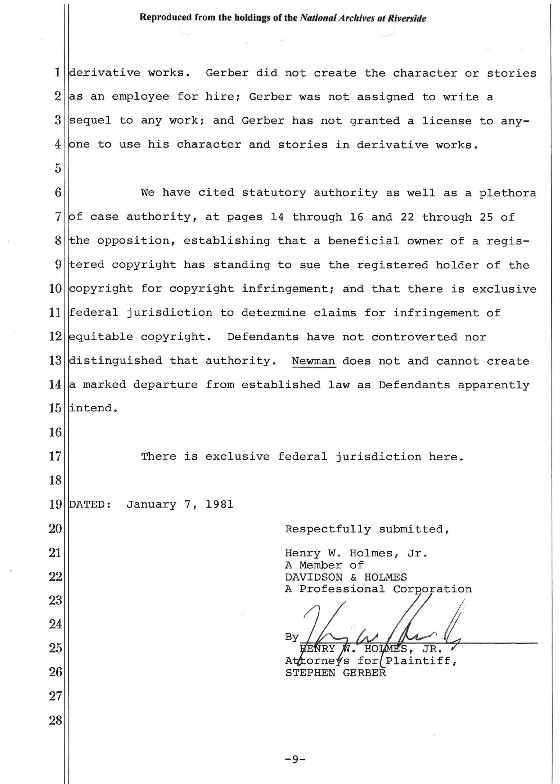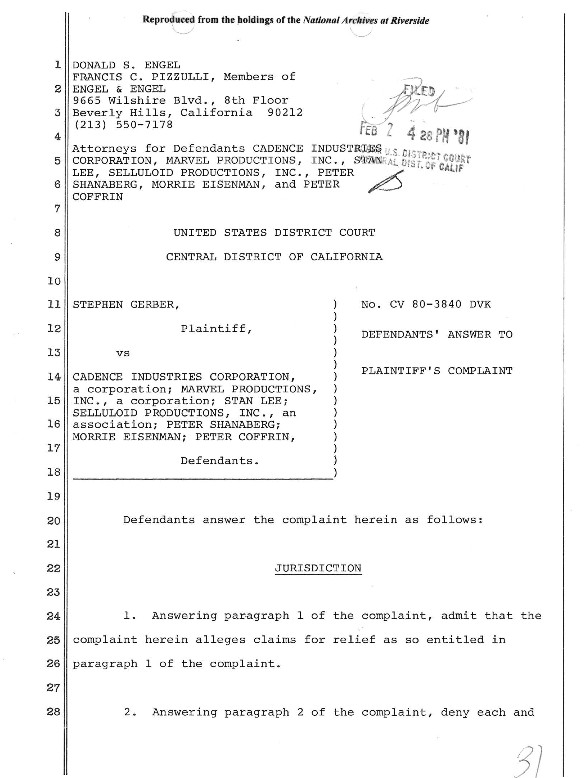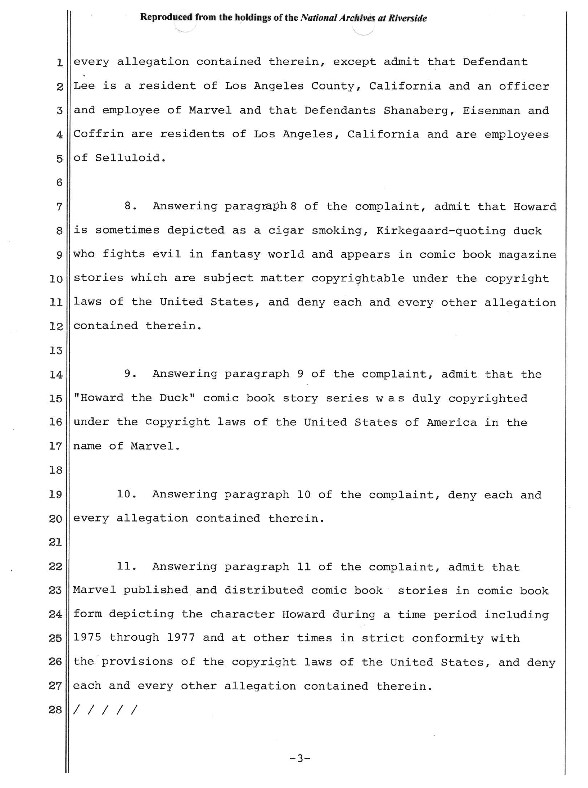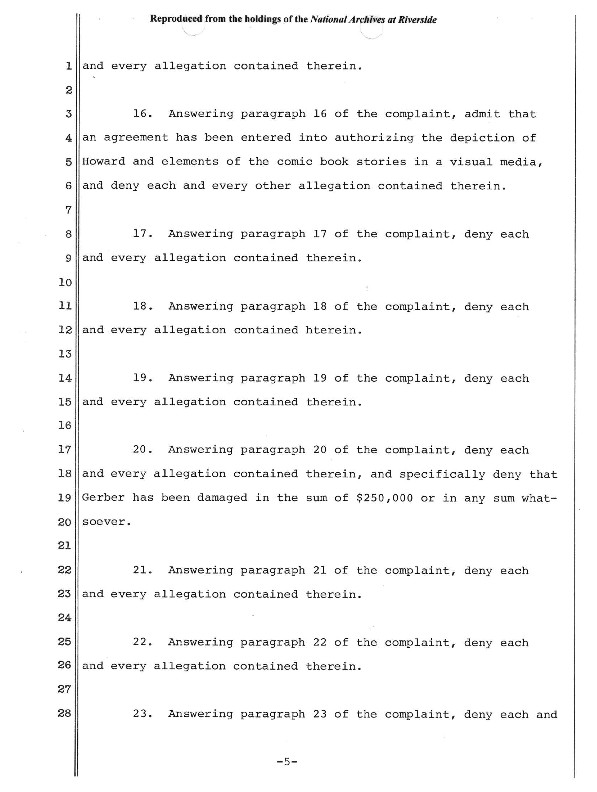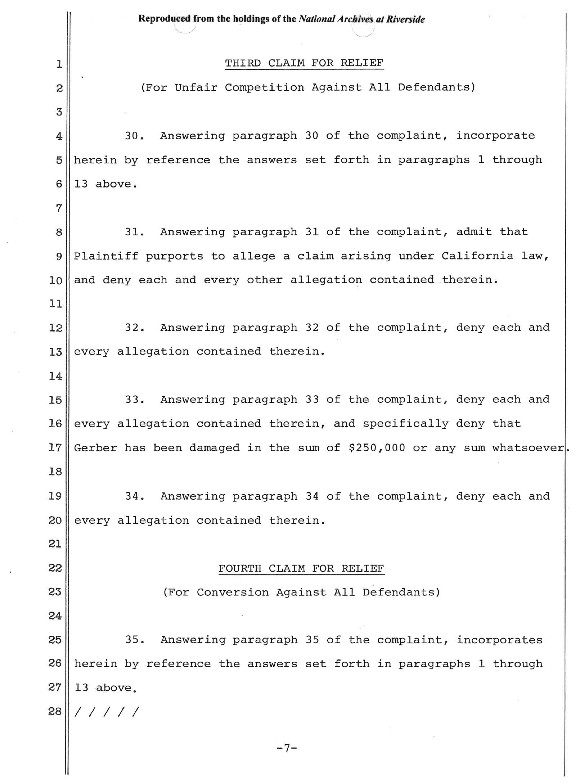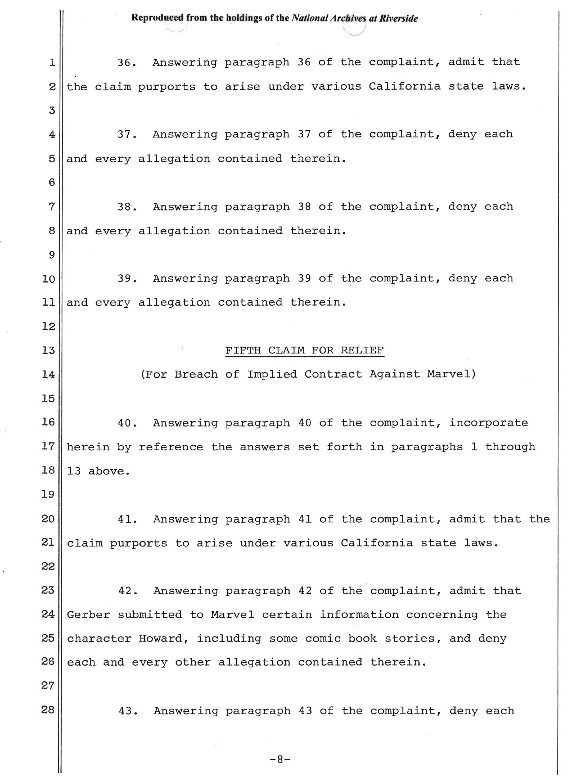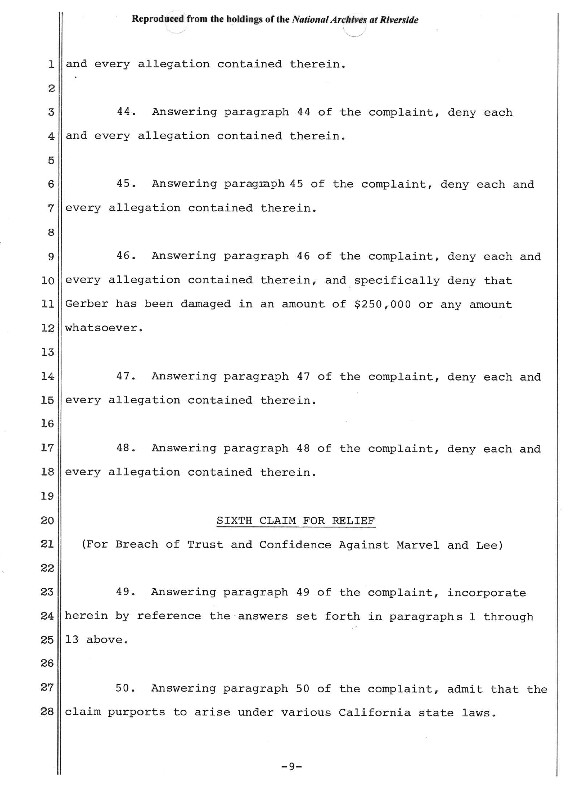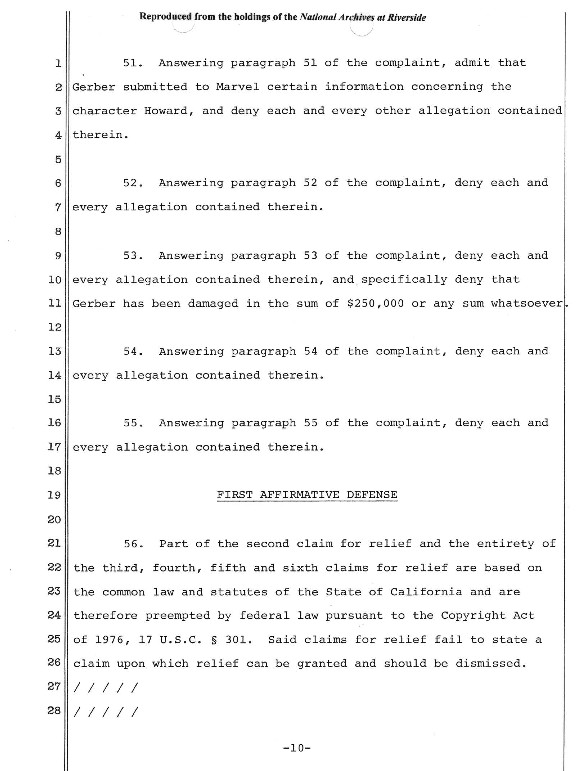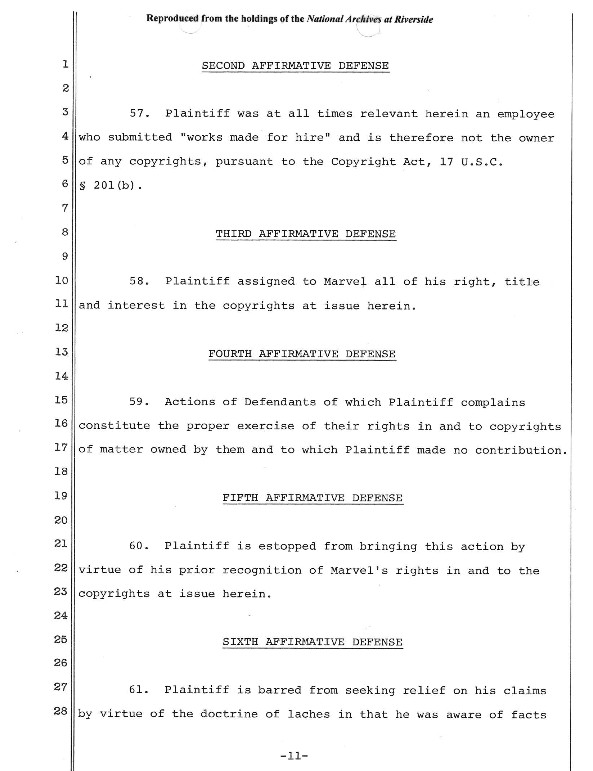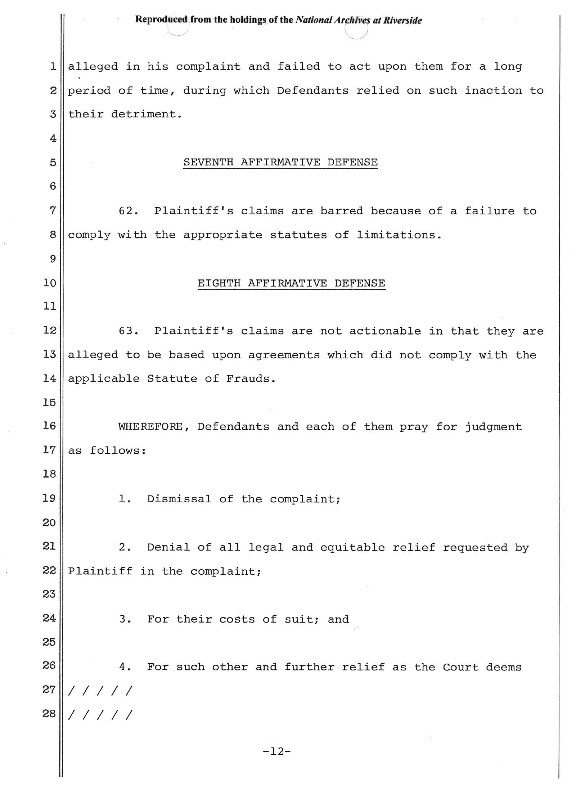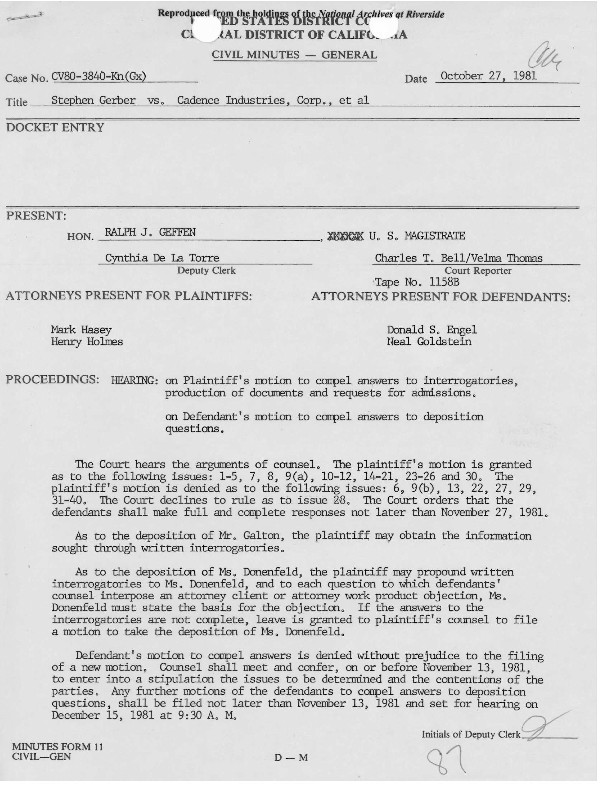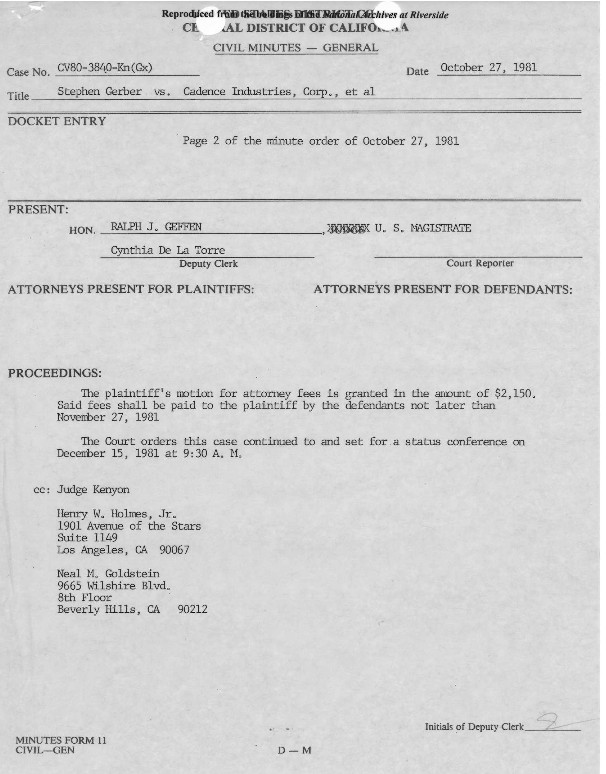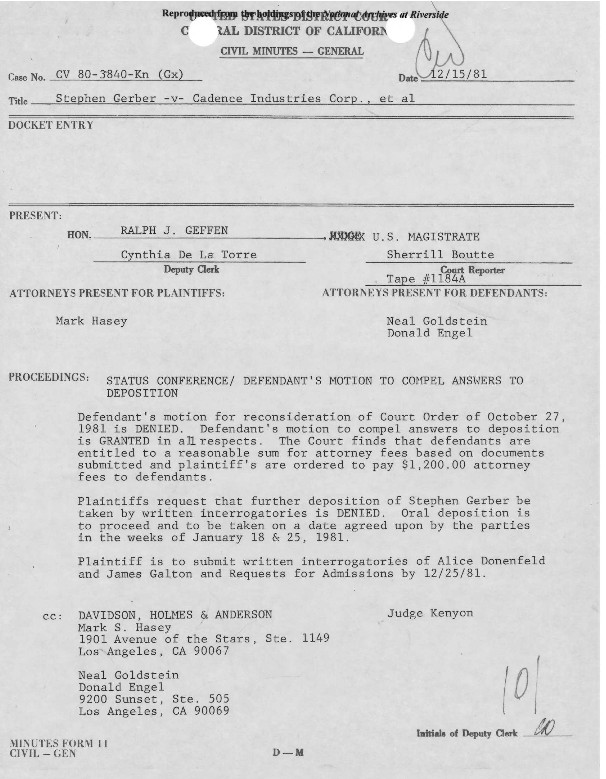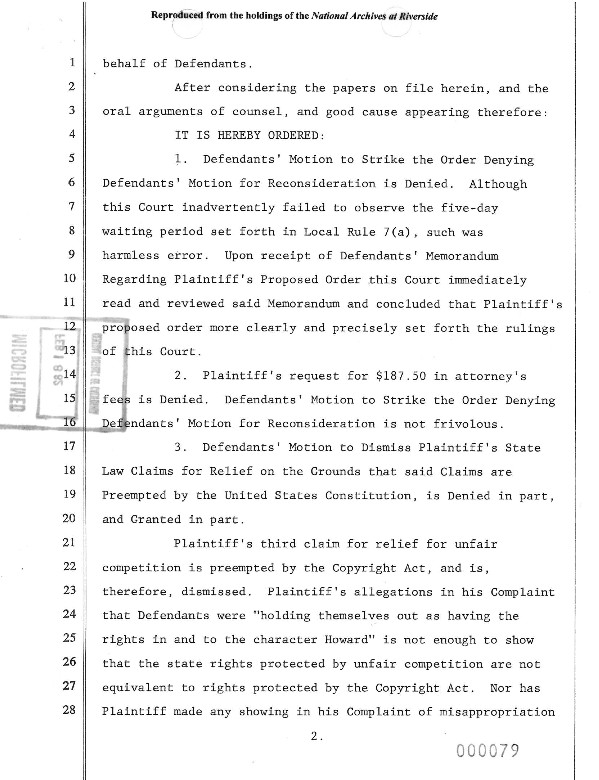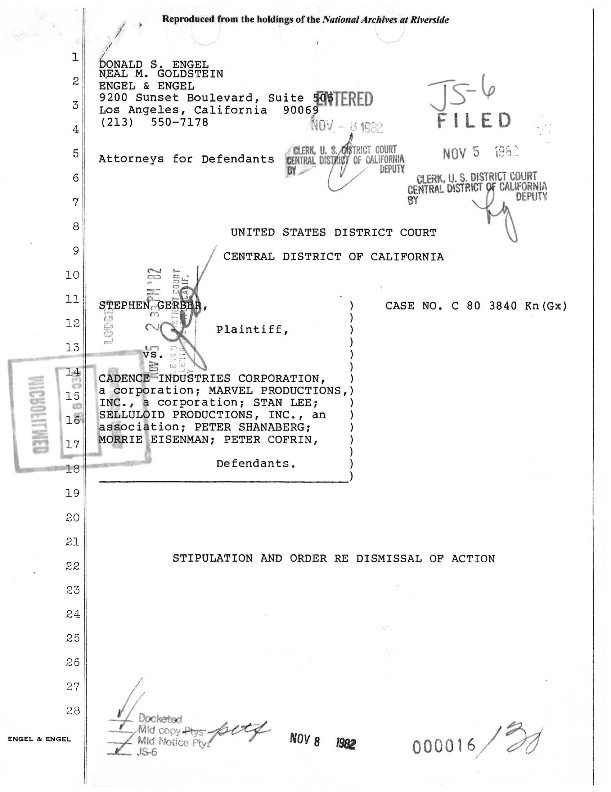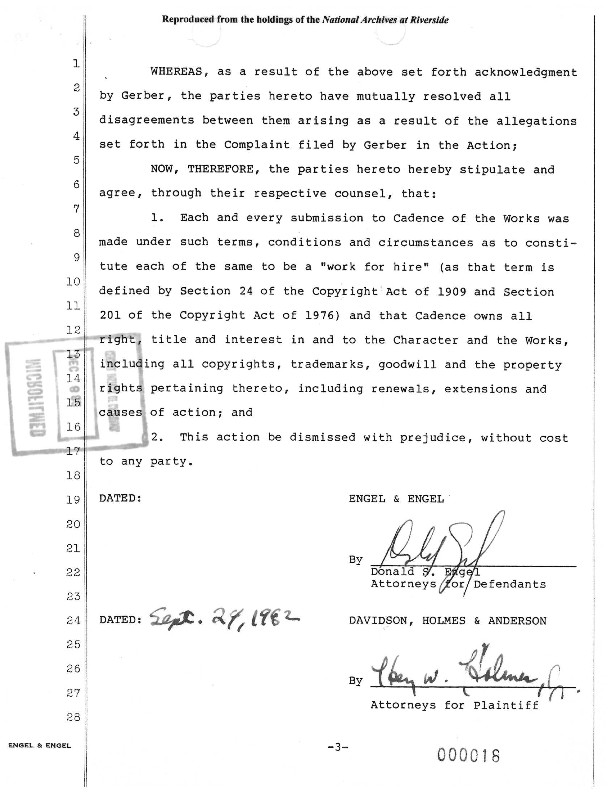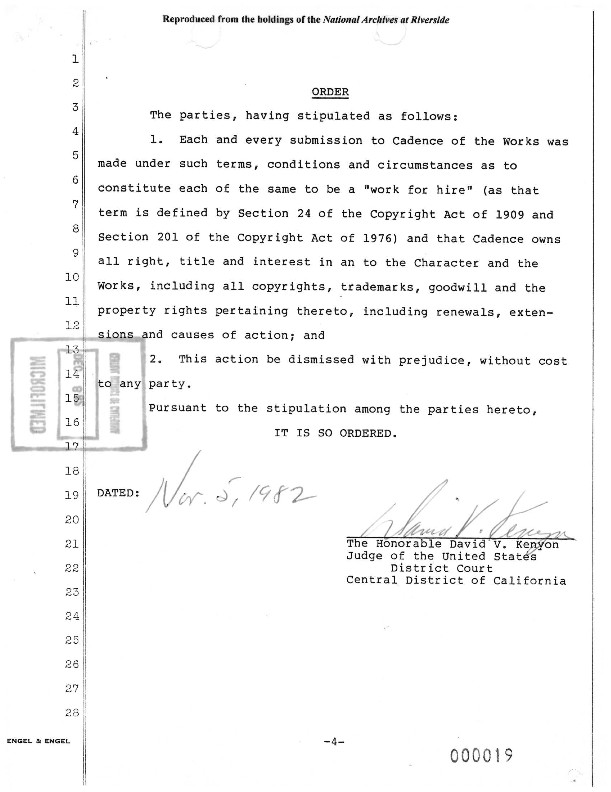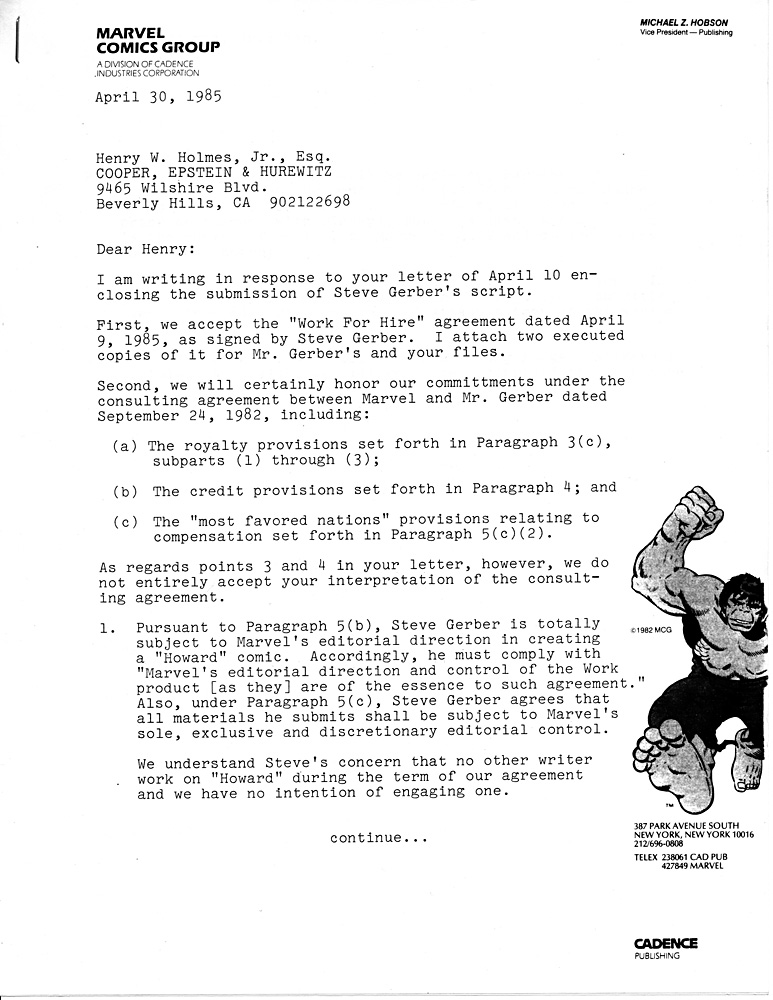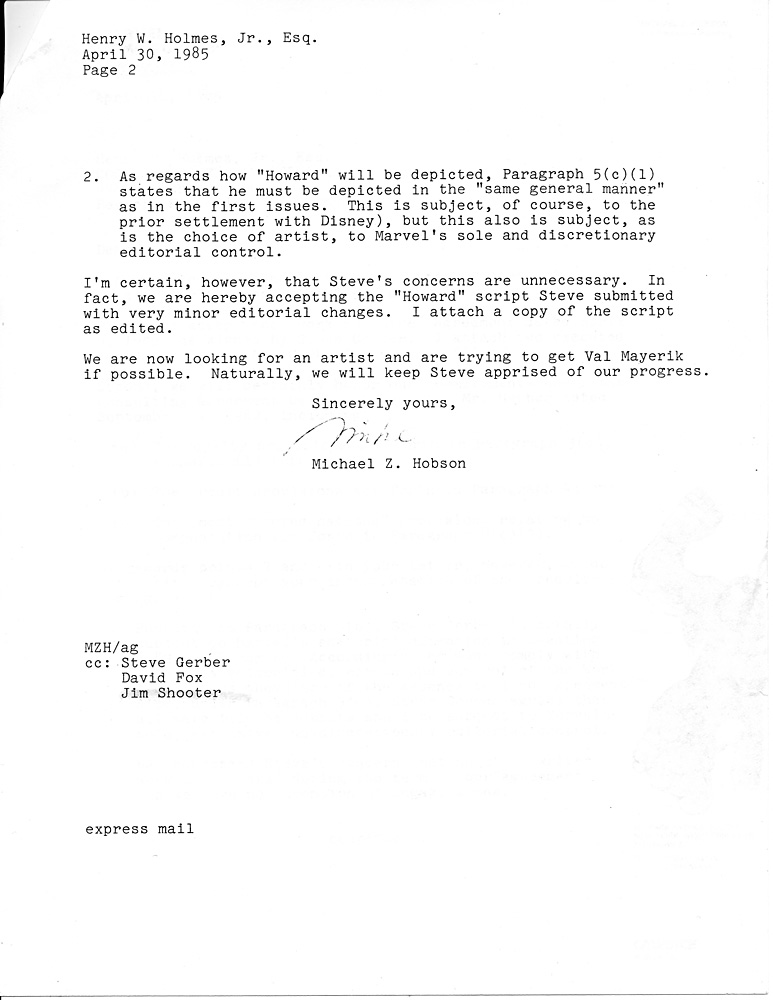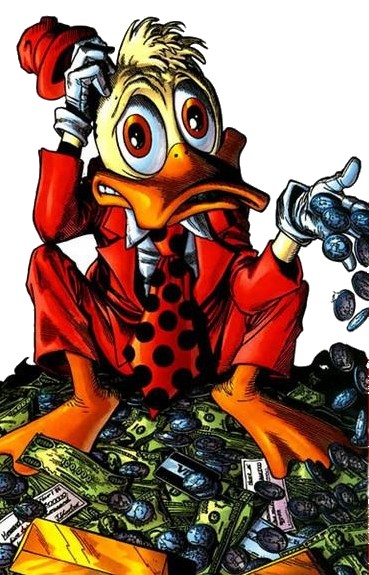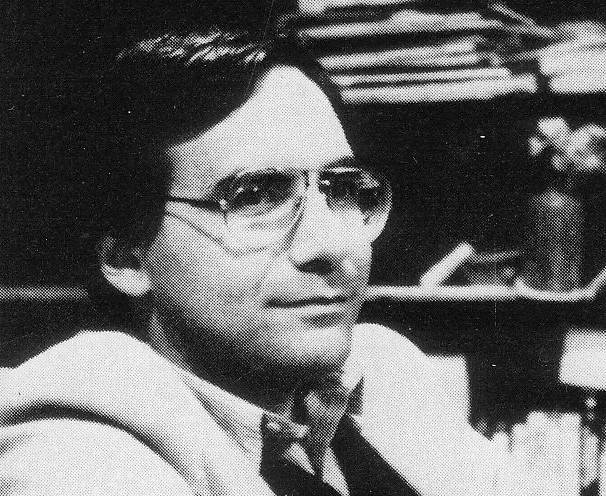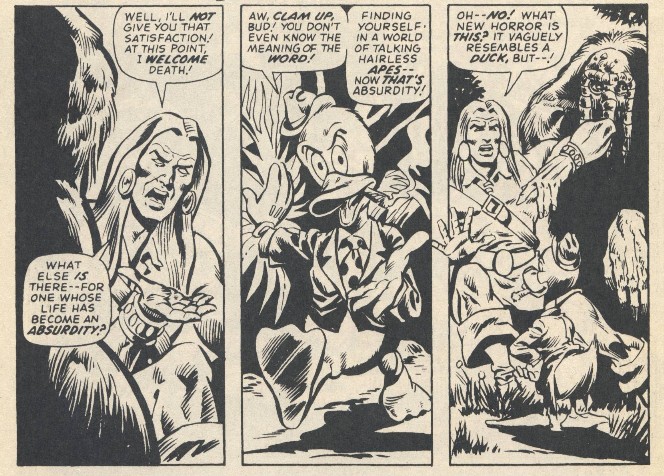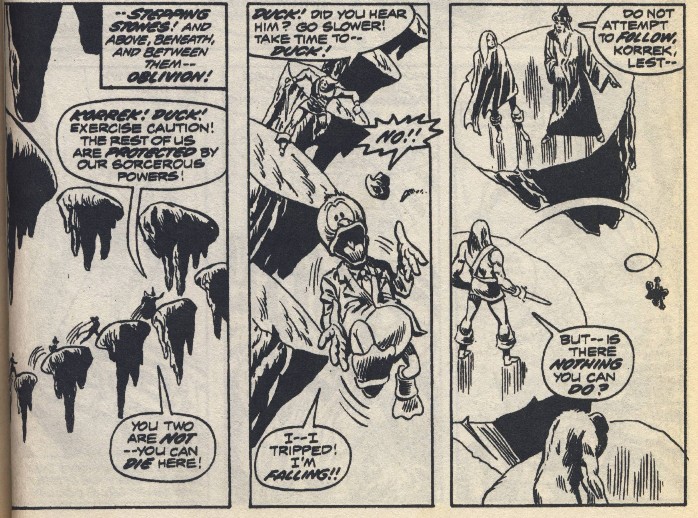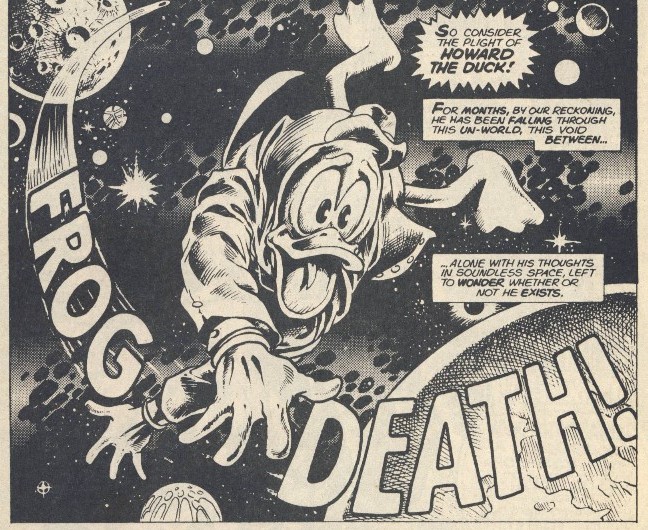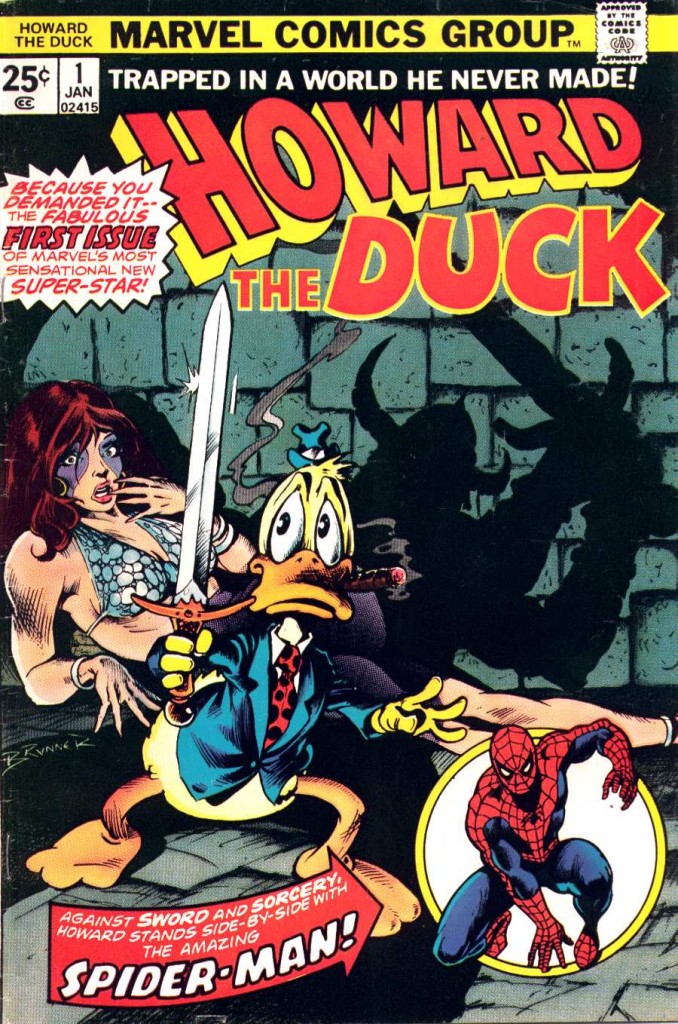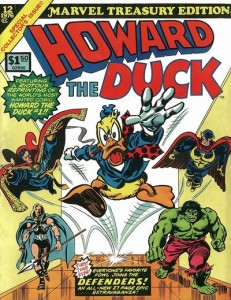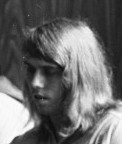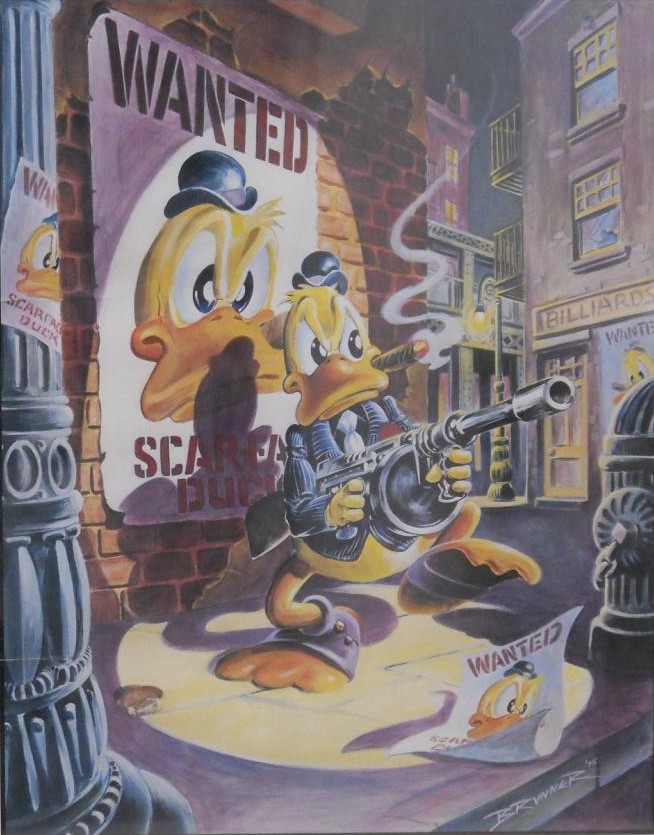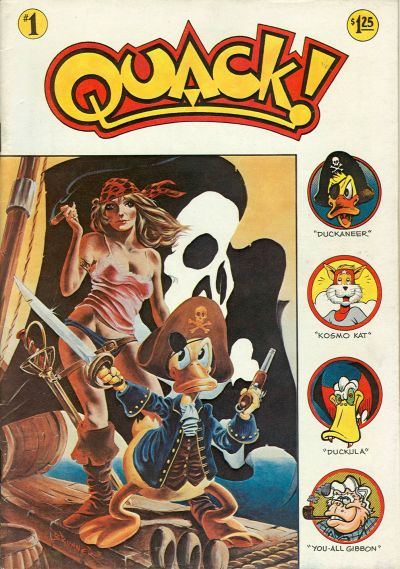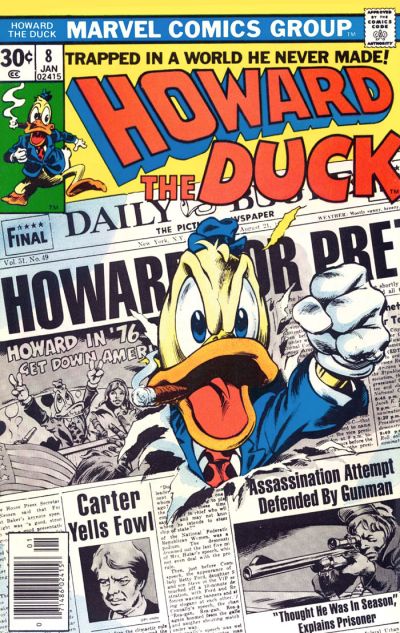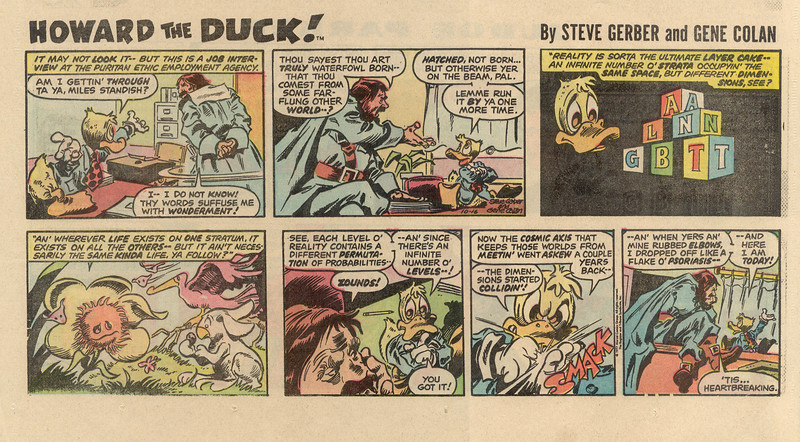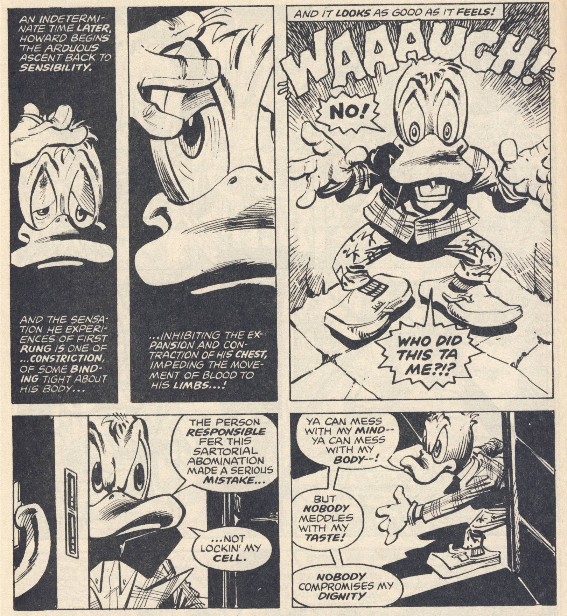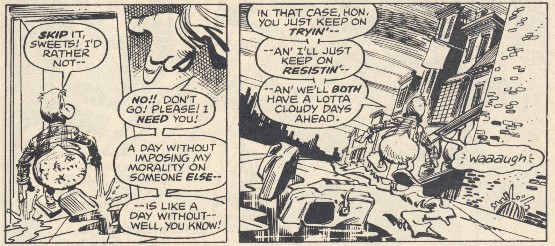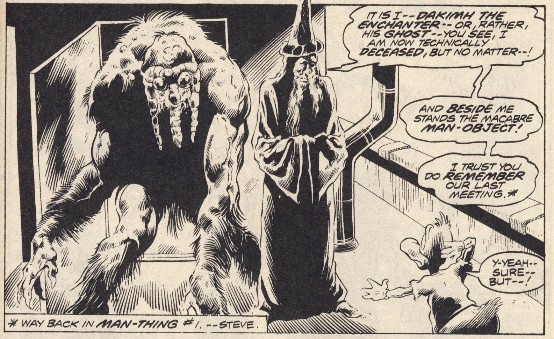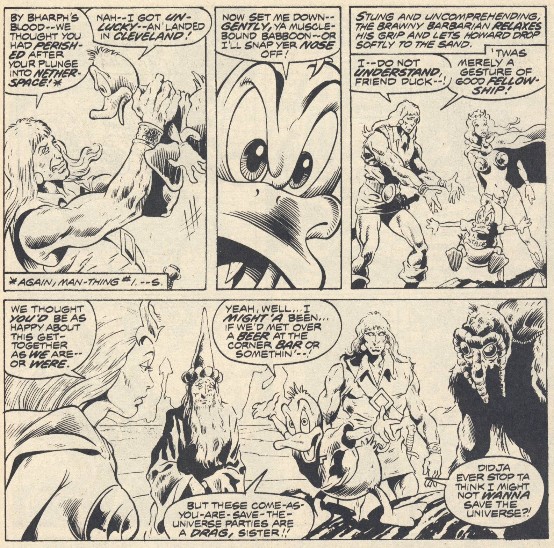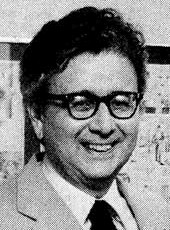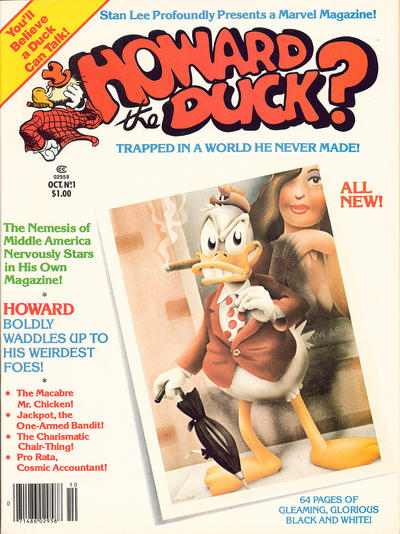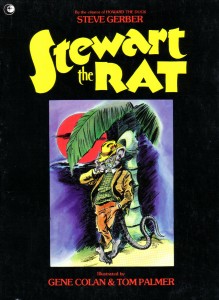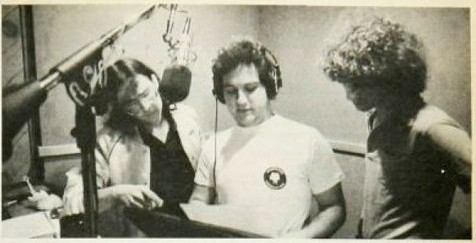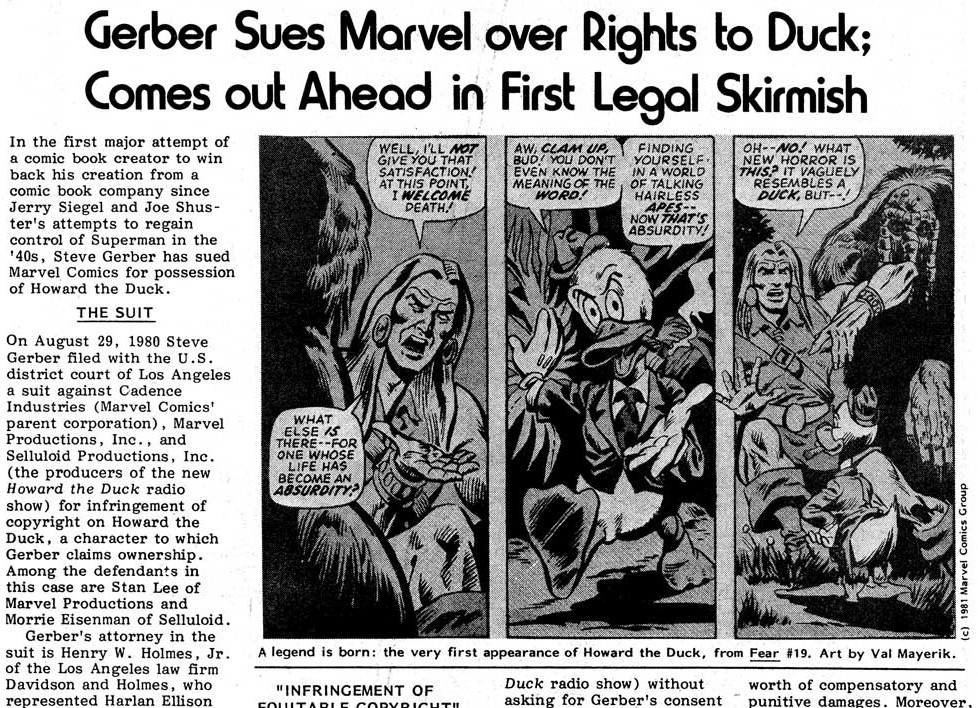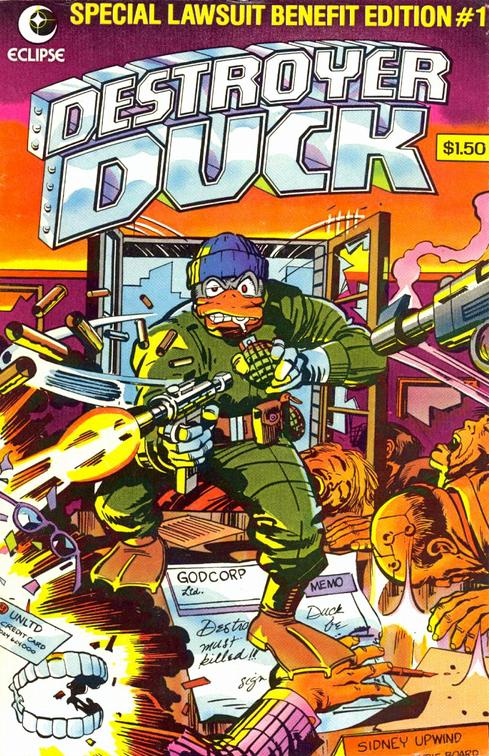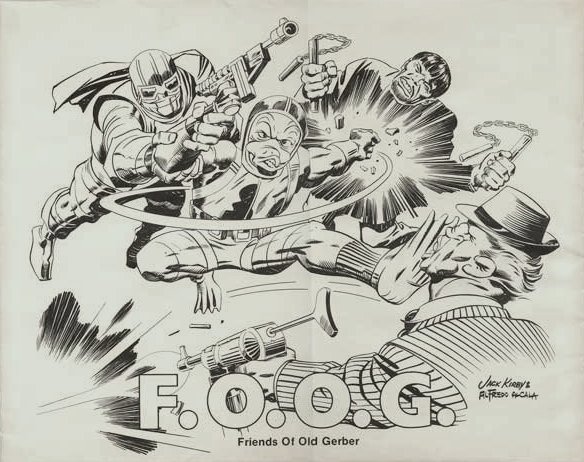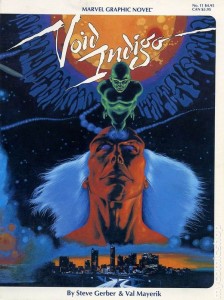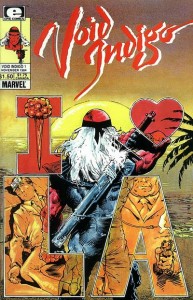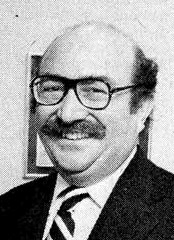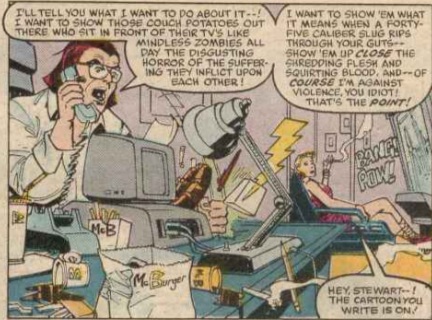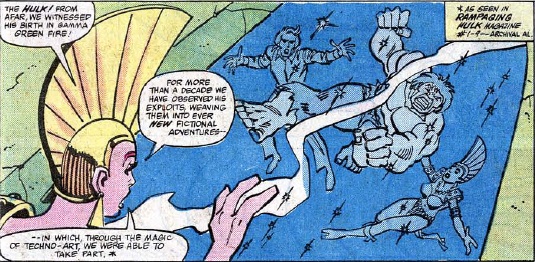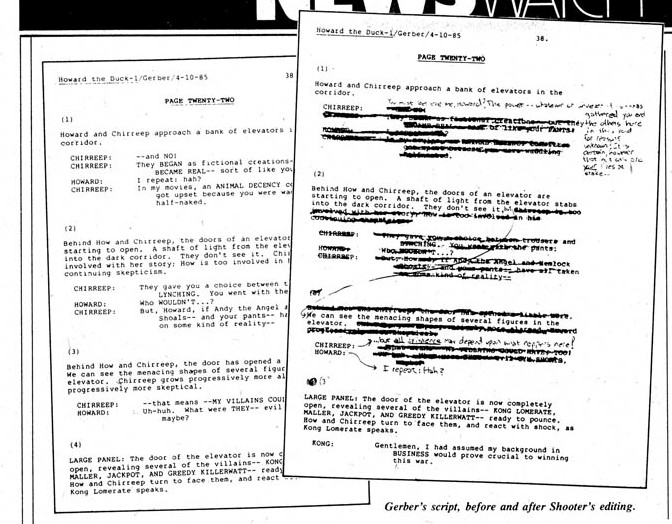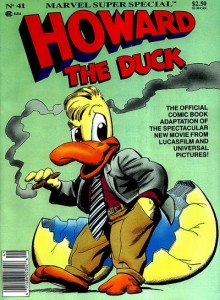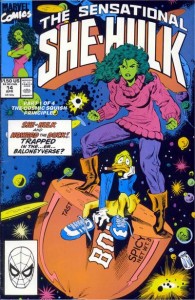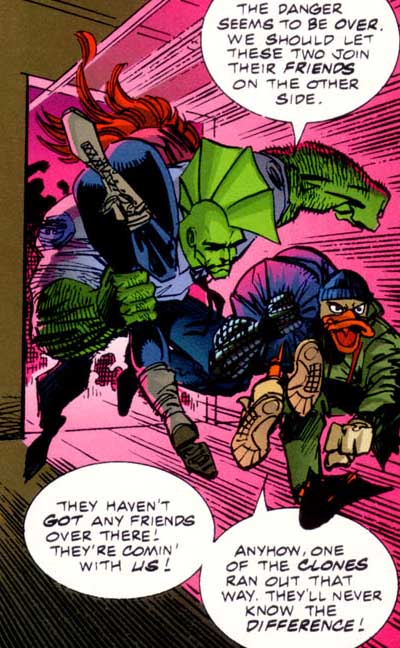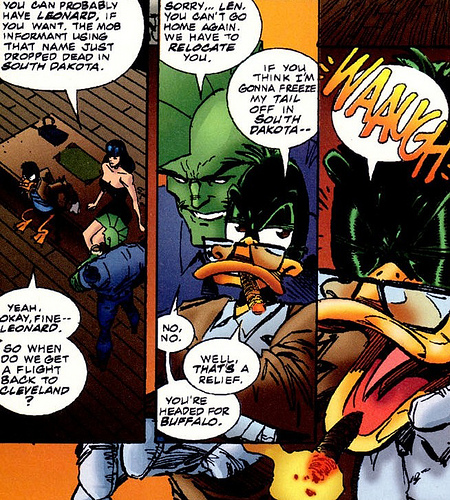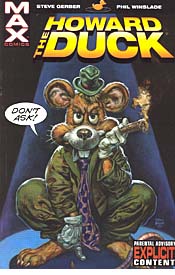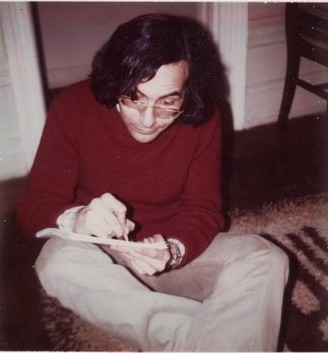![BollandHoward]()
Howard the Duck. Art by Brian Bolland.
This article is a history of the editorial and business relationship between Marvel Comics, their representatives, and the late writer Steve Gerber (1947-2008). Its focus is their dealings over Howard the Duck, Gerber’s signature character.
The piece has its origins in a historical series I’ve been intermittently working on called Jim Shooter: A Second Opinion. The series is a reexamination of the frequently maligned tenure of the Marvel Comics’ editor-in-chief between 1978 and 1987. The third article, still in progress, is planned to cover Shooter’s alleged conflicts with writers, artists, and editorial staffers in the months that followed his taking the editor-in-chief position. Gerber, the co-creator, writer, and editor of Marvel’s Howard the Duck series, was fired shortly after Shooter took over. An account of his termination seemed in order. Most writers have treated the termination as going hand-in-hand with the 1980 lawsuit Gerber filed over ownership of Howard, so I looked into that as well.
In 2009, Gerber’s close friend Mark Evanier wrote, “The whole matter of Steve’s legal problems with Marvel [...] is a very complicated situation which has never been accurately described in any past reporting.” He’s right. I discovered that the lawsuit in particular had never received anything close to adequate coverage. Lawsuits are a matter of public record, but not one writer appeared to have even read the complaint filing. Upon realizing that no one had done the most basic legwork on this episode, I shifted gears. I set aside the Shooter article, and began researching Gerber in depth instead. Presenting the record with him, rather than arguing it with Shooter, seemed a more urgent undertaking.
The lawsuit’s being public record gave me the opportunity to construct extended parts of the narrative from primary source documents and other court filings. Whenever possible, I have derived my account from contracts, business correspondence, and sworn court declarations. It’s preferable to having to rely on media interviews and earlier writers’ treatments of the matters at hand. With primary source documents, I don’t have to worry to what extent a person’s prejudices and agendas may be skewing their portrayal of a letter or contract; I can just see the document for myself. And while probably no first-person account is entirely free of inaccuracies, people tend to be more rigorous in statements made under oath than when talking to a journalist. In telling the story of the lawsuit, I’ve tried to do so as accurately as possible. In effect, I’ve sought to meet the challenge Mark Evanier’s statement makes. This article is intended as a definitive account.
I note that I am not looking for the imprimatur of, among others, Mark Evanier. He has spent many years working to develop a reputation as a comics historian, and several in the comics community put a good deal of weight on his opinion. I expect that, as Gerber’s friend, he will find the article distasteful. The depiction of Gerber’s various dealings with Marvel is an unvarnished one. I have no interest in providing a necessarily complimentary view of anyone involved. For my part, all I can I say is I’ve done my best to be both skeptical and fair towards Gerber and the others. I believe my presentation is both accurate and thorough. I hope those who would prefer a partisan portrayal favoring Gerber can respect the article as a conscientious effort. For those who think they can do better, I’ve made it as easy as I can for them to improve upon my work.
In addition to the bibliography, there is an accompanying post titled “The Howard the Duck Documents.” (Click here.) It is a trove of primary source materials related to the case. One will find copies of all of Gerber’s 1970s Marvel contracts, every extant piece of correspondence relating to his 1978 termination, and the most significant documents filed with the court. These include the lawsuit complaint, the extended declarations and responses by both sides in the complaint’s wake, and the judge’s final order to dismiss the case. For those curious as to what isn’t included, there is also a copy of the complete case docket, which lists every filing in the suit. Most of this material has never been published or even reported on before. It is all in the public domain, so those interested are free to copy and publish it for their own use.
The complete case records, reportedly two cartons of documents, are in the National Archives at Riverside, California. The staff there was immensely helpful in providing the documents I sought. I believe anyone looking to fill perceived holes in my research will find them just as invaluable. They definitely have my thanks.
![Steve Gerber]()
Steve Gerber
Steve Gerber was born in St. Louis, Missouri on September 20, 1947. He graduated from Saint Louis University in 1969 with a B. A. in communication. In 1972, while working as a copywriter for a St. Louis advertising agency, he contacted Marvel editor Roy Thomas about working for the publisher. Gerber and Thomas had met through Missouri comics-fan circles during the 1960s. Thomas, as he had previously done for fellow Missourians Denny O’Neil and Gary Friedrich, arranged for Gerber to join the company’s staff as an editorial assistant. The primary responsibility was proofreading. His salary would be $125 a week. (Adjusted for inflation, this would be the equivalent of just over $700 today.) Gerber, who was then 24, relocated to New York City, where Marvel was based.
![Adventure into Fear #11 (December 1972), Steve Gerber's solo scripting debut.]()
Adventure into Fear #11 (December 1972), Steve Gerber’s solo scripting debut.
Like other editorial employees at Marvel, Gerber supplemented his income with freelance scriptwriting for the company’s publications. According to the Grand Comics Database, his first published credits appear in the December 1972 issues of
The Incredible Hulk (an episode co-written with Roy Thomas),
Shanna the She-Devil (co-written by Carole Seuling), and
Adventure into Fear, featuring Man-Thing. Given Marvel’s cover-dating practices, the comics probably reached newsstands in September of 1972. Gerber most likely did the scripting for them that May. The Man-Thing feature was Gerber’s first series assignment, and he scripted it on a monthly basis for nearly three years. Shortly after embarking on the Man-Thing assignment, he also took over the scriptwriting duties on the
Daredevil and
Sub-Mariner series. At the end of 1972 or early 1973, he left his staff position to focus full-time on freelance writing for the company.
All of Gerber’s scriptwriting for Marvel at this time was done on a work-made-for-hire basis. Marvel owned all intellectual-property rights to the work he did. This was before 1978, when the 1976 Copyright Act’s mandate that work-made-for-hire relationships be agreed to in writing at the outset went into effect. Under the Copyright Act of 1909, as elaborated by federal-appeals-court decisions in Yardley v. Houghton-Mifflin (1939) and Brattleboro Publishing v. Winmill Publishing (1965), an independent-contractor relationship was assumed to be work-made-for-hire in the absence of a clear agreement to the contrary. Additionally, Marvel frequently stamped the back of freelancer checks with a legend that had, with the check endorsement, the freelancer acknowledge Marvel’s ownership of the intellectual-property rights to the work. One legend Marvel used reads:
By endorsement of this check, I, the payee, acknowledge full payment for my employment by Magazine Management Company, Inc. [Marvel's 1960s and early 1970s parent company] and for my assignment to it of any copyright, trademark, and any other rights in or related to the material, and including my assignment of any rights to renewal copyright.
This and similar legends have often been portrayed as transfer agreements, but according to the prevailing judicial precedents, the rights had already been transferred by dint of the freelancer relationship with the publisher. In practice, the legend was a redundancy that ensured the freelancer had been notified as to the publisher’s policy, and that the policy covered the work at hand.
There was nothing particularly unusual about Marvel’s conduct. Under the indivisibility doctrine that emerged from the 1909 copyright law, publishers could not, among other things, take action against infringement without ownership of the intellectual-property rights. Freelancer contributions were all but universally assumed to be work-made-for-hire throughout the periodical publishing industry, including newspapers, non-comics magazines, and other comics publishers. Back-of-the-check legends were not uncommon, either, and were used by such top-paying publishers as Mad and Playboy.
![htdaif19]() The first appearance of Howard the Duck. From Adventure into Fear #19, as reprinted in Essential Man-Thing, Vol. 1.
The first appearance of Howard the Duck. From Adventure into Fear #19, as reprinted in Essential Man-Thing, Vol. 1.
Gerber gradually created a large supporting cast for the Man-Thing feature, including the teenage sorceress Jennifer Kale, Dakimh the Enchanter, and Korrek the Barbarian. One year into the series, in Adventure into Fear #19, he and artist Val Mayerik introduced what would quickly become his most famous creation: a talking, cigar-smoking duck from another world named Howard. The issue, cover-dated December 1973, would have reached newsstands that September. It was most likely written the previous spring. In a 1976 interview, Gerber described when the initial idea for Howard the Duck came to him:
[Howard was created as] a joke. It was the only sight gag I could think of to top Korrek jumping out of a jar of peanut butter in Fear #19[.] I told Val to have a duck come waddling out of the bushes. (Kraft 10)
Gerber also described Val Mayerik’s contribution:
[T]he cigar was Val Mayerik’s creation. So was Howard’s clothing. I just told Val, “Don’t make him look too much like Donald, and for God’s sake, don’t dress him in a sailor suit. (Kraft 10)
Marvel ostensibly paid for Gerber’s work on the issue with a June 1, 1973 check for $285.00. The back of the check was stamped with the rights acknowledgement legend.
(For a copy of the check, both front and back, see “The Howard the Duck Documents”.)
The Howard character didn’t last long in the feature. Gerber told Jon B. Cooke in 1999 that editor Roy Thomas ordered him to remove Howard from the series “as fast as you can” (Cooke 61). Midway through the subsequent episode, published in The Man-Thing #1 (January 1974), Gerber and Mayerik had Howard fall off a giant stepping-stone bridge into an inter-dimensional void, apparently never to be seen again. The other characters considered him dead.
![htdmt10001]()
The assumed death of Howard the Duck. From The Man-Thing #1, as reprinted in Essential Man-Thing, Vol. 1.
But Howard had struck a chord with several readers. According to Gerber in 1975:
People were taken with him immediately. The office was flooded with letters; there was one wacko who sent a duck carcass from Canada […] saying, “Murderers, how dare you kill off this duck?” There was the incident at a San Diego Comics Convention where somebody asked Roy, I believe, who was speaking there, whether Howard would ever be coming back, and the auditorium stood up and applauded. Stan [Marvel publisher Stan Lee] was being asked about it everyplace he went on the college [lecture] circuit. (Kraft 10)
![htdgsmt4a]()
The return of Howard the Duck. From the opening page of the solo Howard story in Giant-Size Man-Thing #4 (May 1975), as reprinted in Essential Howard the Duck, Vol. 1
Marv Wolfman, then the editor of Marvel’s black-and-white magazine line, claims that he approached Gerber about featuring Howard in those titles (Dean 42). However, the decision was made to reintroduce the character in the color comics. Gerber and artist Frank Brunner put together a nine-page story that was published as a back-up feature in Giant-Size Man-Thing #4 (May 1975). The story picked up Howard right where The Man-Thing #1 episode had left him. The opening page showed him falling through the seemingly endless void. The top of the second page had him landing in a vacant lot in Cleveland. Over the course of the story, he befriends a pair of local boys, does battle with an anthropomorphic frog that’s terrorizing the neighborhood, and ends up arrested by the police. Gerber and Brunner did a follow-up story for the next issue of Giant-Size Man-Thing. The response to the stories was favorable, and the go-ahead was given to launch Howard in his own title.
![Howard the Duck 01 - 00 - FC]()
Marvel’s circulation director Ed Shukin didn’t have much faith in the new series. For the first issue, he ordered a print run of 275,000–Marvel’s minimum at the time for a standard-size color newsprint comic. That first issue (cover at left) shipped to newsstands in October of 1975. It promptly sold out. Looking back on the first issue’s sales, Shukin told The New Yorker writer Mark Singer, “I underestimated that duck” (Singer 30). Unfortunately, many of the copies weren’t sold to readers. Comic-book collectible dealers reportedly snapped up every copy they could find through newsstand vendors and distributors. They intended to hoard the books and then sell them at vastly inflated prices. One dealer, Jim Kovacs of Cleveland, claimed to have bought 900 copies the day the issue went on sale. He told the Washington Post he followed the distributor’s truck while it made its deliveries. In 1977, the average price of the issue among back-issue dealers was $12.50, a mark-up of 5,000 percent over the cover price of 25¢. Gerber, reflecting on the situation in 1999, said:
I was angry as hell. I felt as if the book had been sabotaged by the very people who supposedly liked the character […] The sales on [Howard the Duck issue] #2 were respectable. I don’t recall exactly what the sales figures were, but I think it would’ve done a lot better–the series would have done a lot better–had that first issue reached the stands. (Cooke 64).
![25899]() In the summer of 1976, partly in response to the unmet demand for the first issue, Marvel issued a tabloid-size Treasury Edition (cover at right). Along with a new episode, it reprinted the first issue’s story and all the character’s prior appearances. The material from the initial Man-Thing stories were, apart from one scene, limited to excerpts featuring the sections in which Howard appeared. Gerber and Val Mayerik produced a new splash page introducing the excerpts, and Gerber provided a text dialogue between Howard and a “Voice from on High.” The dialogue filled the half-page above the panels featuring Howard’s initial appearance from Adventure into Fear #19.
In the summer of 1976, partly in response to the unmet demand for the first issue, Marvel issued a tabloid-size Treasury Edition (cover at right). Along with a new episode, it reprinted the first issue’s story and all the character’s prior appearances. The material from the initial Man-Thing stories were, apart from one scene, limited to excerpts featuring the sections in which Howard appeared. Gerber and Val Mayerik produced a new splash page introducing the excerpts, and Gerber provided a text dialogue between Howard and a “Voice from on High.” The dialogue filled the half-page above the panels featuring Howard’s initial appearance from Adventure into Fear #19.
Gerber may have felt Howard would have done better had it not been for the speculation frenzy, but sales appear to have been healthy. Ed Shukin told The New Yorker the print-run on a new issue in 1977 was 400,000 copies, a 45% increase over the pressing of Howard #1. Newsstand periodical print orders generally reflect an expected sell-through rate of 50%, so Howard‘s paid circulation was probably about 200,000 copies per issue. Marvel’s confidence in the series’ sales was also reflected by the decision to bump it from bi-monthly to monthly status with the seventh issue.
The feature had strong cult appeal. The character’s alien perspective, combined with the strip’s setting in Marvel Comics’ superficially quotidian fantasy world, provided Gerber with an effective vehicle for satirical social commentary. The setting allowed him to parody comics and other pop-culture material with abandon. The satirical tropes were often clever and layered. Gerber also managed to imbue the character with a forlorn air of existential absurdity. He occasionally hit notes that, for all the series’ juvenile goofiness and adventure-fantasy trappings, were far more characteristic of literary fiction than anything seen up to that point in American comic books. Steve Gerber is widely considered the most accomplished writer of 1970s English-language adventure comics, and Howard the Duck’s better moments are much of the reason why.
![Frank Brunner]()
Frank Brunner
However, all was not good behind the scenes. Artist Frank Brunner was growing increasingly unhappy. In a 1999 interview with Jon B. Cooke, Brunner said that he felt he should have been credited as the co-writer, not just co-plotter, of the story in
Howard the Duck #1. At the very least, a change in the credits would entitle him to larger payment with reprints. Creative tensions with Gerber arose as well. With the second issue, Gerber began writing the stories full-script, and Brunner found Gerber’s insistence on delivering the script piecemeal oppressive. He told Cooke, “I couldn’t pace the story! [...] full script is one thing, you can at least pace it, but when you get it in pieces, I don’t know where to put the big dramatic scenes!” Brunner was also at odds with Marvel’s policy at the time for returning original art, and it led to arguments with Gerber. The policy was for a story’s scriptwriter to get two of the pages for a standard 17-to-19-page story, with the remainder divided in a two-thirds/one-third split between the penciler and inker. (Jim Shooter, Marvel’s editor-in-chief between 1978 and 1987, permanently eliminated the writers’ share in 1980.) At the time, a few of the company’s scriptwriters didn’t see why they should be entitled to the original pages and returned them to the artists. Gerber, though, wasn’t among them. He refused to accommodate Brunner’s requests to turn over the pages he’d been allocated. Finally, after Brunner heard reports of the first issue’s sales, he asked Marvel to increase his page rate. He was refused. He quit after turning in the art for the second issue. The third issue was pencilled by John Buscema, and then Gene Colan took over as the series’ regular artist. Steve Leialoha, who inked the Brunner episodes, stayed on as the series’ inker.
![ScarfaceDuck]()
![49139]()
The Scarface Duck poster (left) and Quack #1, featuring the Duckaneer (right)–artist Frank Brunner’s 1976 attempts to capitalize on Howard the Duck’s success.
Brunner didn’t go off quietly into the sunset. He immediately set himself up in competition with Howard and started doing his own cartoon duck material. His attitude was, “I was filling a void left by slow-moving Marvel [...] which did not immediately see the potential of the fan market–or of the duck” (Howe 182). The first product was a poster print, sold and distributed via mail order, titled Scarface Duck. It depicted a Howard-style duck in 1930s gangster-movie trappings. The second was a new duck-comics feature titled “The Duckaneer,” done in collaboration with inker Steve Leialoha. It debuted in the premiere (July 1976) issue of Quack!, published by Star*Reach for exclusive distribution to the nascent comic-book specialty market. Marvel doesn’t appear to have given either project any mind, but Gerber was not happy. After learning of the poster, he contacted Brunner and demanded a share of the profits. Brunner refused, saying to him, “Which part of the print [...] did you write or draw? What part of the deal did you arrange?” (Howe 183). It’s not known how successful these projects were, but Brunner all but abandoned duck-related efforts after the first Duckaneer story was published. He did a few media-parody duck prints for the poster market in the years that followed, but almost all his subsequent output was devoted to non-duck material.
![WrightsonHoward]()
The “Vote Howard the Duck” pin-back button. Art by Bernie Wrightson.
Steve Gerber had merchandising ideas of his own. On March 12, 1976, he entered into a licensing agreement with Marvel for the manufacture and sale via mail order of “Vote Howard the Duck in ’76” pin-back buttons. Marvel would be paid a royalty of five percent for each one sold.
(For a copy of the March 12, 1976 button licensing contract, see “The Howard the Duck Documents”.)
The licensing contract should have clarified any ambiguity that may have existed at that point with regard to ownership of the character. Section 4 of the agreement, titled “GOOD WILL, ETC.” includes this statement:
Licensee [Gerber] recognizes the great value of the Name and Properties and Subject Mark(s) and of the goodwill associated therewith and acknowledges that the Name and Properties and Subject Mark(s) and all rights therein (including copyright) and goodwill pertaining thereto belong exclusively to Licensor [Marvel].
The contract’s preamble specifically defines the terms used. The term “Name” refers to Howard the Duck’s “name, character, symbol, design, likeness, sounds and visual representation and/or each of the individual components thereof”. The term “Properties” means “copyright in literary and/or artistic materials featuring, containing and/or consisting of the names, characters, symbols, designs, likenesses, sound and visual representations” of Howard the Duck. The “Subject Mark(s)” are defined as “Trademark registration(s) of the Name and/or components thereof”. Gerber acknowledged in the contract that Howard was Marvel’s exclusive property.
Additionally, in Section 5 of the agreement, titled “LICENSOR’S TITLE AND PROTECTION OF LICENSOR’S RIGHTS,” the contract says, “Licensee agrees that it will not during the term of this agreement, or thereafter, attack the title or any of the rights of Licensor or Licensor’s grantors in and to the Name and/or Properties and/or Subject Mark(s) or attack the validity of this license.” In other words, Gerber contractually agreed to never sue over or otherwise challenge Marvel’s exclusive proprietary rights to Howard the Duck.
![Howard-the-Duck-81]() Gerber hired artist Bernie Wrightson, best known as the co-creator of DC Comics’ Swamp Thing character, to do the artwork for the button. It retailed for one dollar plus a quarter for shipping. Checks were to be made payable to Gerber, who handled the orders through Mad Genius Associates, a cooperative with fellow comics scripters Mary Skrenes, Jim Salicrup, Don McGregor, and David Anthony Kraft. The comic-book series was used to promote the button. It was advertised in the letters column of the fourth issue. A few months later, an episode revolving around the character’s presidential campaign was featured in issue #8 (cover at right). It reached newsstands in October of 1976. (The issue was cover-dated January 1977.) The faux presidential campaign contributed to the buzz around the series, and over the next year or so Gerber was interviewed for articles about the feature in Circus, Playboy, and the Washington Post.
Gerber hired artist Bernie Wrightson, best known as the co-creator of DC Comics’ Swamp Thing character, to do the artwork for the button. It retailed for one dollar plus a quarter for shipping. Checks were to be made payable to Gerber, who handled the orders through Mad Genius Associates, a cooperative with fellow comics scripters Mary Skrenes, Jim Salicrup, Don McGregor, and David Anthony Kraft. The comic-book series was used to promote the button. It was advertised in the letters column of the fourth issue. A few months later, an episode revolving around the character’s presidential campaign was featured in issue #8 (cover at right). It reached newsstands in October of 1976. (The issue was cover-dated January 1977.) The faux presidential campaign contributed to the buzz around the series, and over the next year or so Gerber was interviewed for articles about the feature in Circus, Playboy, and the Washington Post.
With the ninth issue, Gerber took over as the series editor. Judging from Sean Howe’s account in Marvel: The Untold Story, the expanded authority on the title was intended to mollify Gerber after he’d had his scriptwriting assignment for Marvel’s The Defenders series taken away (Howe 189). Gerry Conway, who had recently vacated Marvel’s editor-in-chief position, had negotiated a large contract with the publisher. It called for him to write and edit eight separate comic-book series. Five of the titles he took over had already been vacated by their regular writers, and two new ones were created to accommodate his quota. Someone, though, was going to have to be stripped of a series assignment for Conway’s benefit, and Gerber was made the sacrificial lamb. The freelance editing fee was a small fraction of what he had made writing The Defenders, but it seems the additional autonomy with Howard made up for the financial hit. And an opportunity for Gerber to make more money from Howard was just around the corner.
![gerberhgc2]()
The October 16, 1977 Sunday episode of the Howard the Duck newspaper strip.
In early 1977, Marvel and the Tribune & Media Syndicate decided to launch Howard the Duck as a daily newspaper strip. Gerber signed a contract with Marvel to write it on March 17. He would be paid one-third of Marvel’s share of the syndication monies after lettering and coloring expenses were deducted. Gerber was further entitled to one-third of any money Marvel received from licensing Gerber’s newspaper-strip material to other media. According to syndicate president Denny Allen, nearly a hundred newspapers initially subscribed to the feature (Smith 37). It debuted on June 6, 1977. Gene Colan was the strip’s first artist.
(For a copy of Gerber’s March 17, 1977 newspaper-strip contract, see “The Howard the Duck Documents”.)
In the first half of 1977, The Walt Disney Company contacted Marvel out of concern that Howard infringed on their trademarks for Donald Duck and related duck characters. In Marvel’s official account of what happened, published in 1980, Steven Grant wrote:
Disney’s licensees overseas suddenly saw their markets threatened when competitors issued the adventures of Howard The Duck. (In countries where comics are translated into languages other than English, the word “duck” is synonymous with “Donald Duck,” and has been for more than 40 years. Simply by virtue of the word “duck” in his name, Howard became what no comics character had been before: a threat to Donald Duck.) The overseas licensees took their grievances to Disney, who in turn contacted Marvel. (26)
The two companies quickly worked out an agreement, and Disney artists redesigned Howard’s appearance. The character would now have an oval head, proportionately smaller eyes, and a short, fat, upturned bill. He would also have toes, brows, and a rotund body. Most conspicuously, the previously trousers-less Howard would now be wearing pants. On June 30, 1977, Marvel art director John Romita issued a memo detailing the changes, including color codes.
(For the redesign model sheets, the first page of the Romita memo, and a subsequent related memo by Marvel production artist Marie Severin, see The Howard the Duck Documents.)
In his public statements of the time, Gerber seemed fairly nonchalant about the redesign. He told the Washington Post that he consequently might “just give Howard a whole new wardrobe, turn him loose in Saks and see what he comes out with” (Turan B2). However, there’s little doubt that privately, Gerber greatly resented what had happened. (His intense dislike of the redesign became publicly known with the release of a 2002 Howard comics project.) Gerber’s anger appears to have quickly found its way into the comic-book series.
![htd210001]()
From Howard the Duck #21, as reprinted in Essential Howard the Duck, Vol. 1.
Howard‘s 21st issue, pencilled by guest artist Carmine Infantino, reached newsstands in November 1977. (The indicia date was February 1978.) The episode was most likely written in July, shortly after the redesign specs were issued. On the surface, it was a lampoon of anti-pornography and other media-decency activists, with a few jabs taken at anti-gay-rights advocate Anita Bryant. But with knowledge of the behind-the-scenes goings-on, parts of the story take on an additional meaning: Gerber was also expressing his contempt for Marvel’s settlement with Disney. The activists, who call themselves the SOOFI, are urban terrorists. Their leader targets Howard for conversion due to his “youth appeal” and “kind of Saturday morning wholesomeness.” Howard is kidnapped, and when he awakens in the SOOFI’s base of operations, he discovers he has been outfitted in entirely new clothes, including pants. He finds the pants physically uncomfortable and an affront to his dignity. While explaining the wardrobe change, the SOOFI leader remarks on Howard’s formerly bare-bottomed appearance with disgust. The SOOFI leader then attempts to brainwash Howard by subjecting him to a device called the Blanditron, but it has no effect. Howard then punches the SOOFI leader and leaves. The final panel has Howard walking away from the reader. The discarded pants are left lying on the pavement. He says to the SOOFI leader, “[...] you just keep on tryin’–and I’ll just keep on resistin’–an’ we’ll both have a lot of cloudy days ahead.” (Emphases in the original.) Gerber seemed to be saying that although Marvel was willing to give in to Disney (considered by many a “Blanditron” of popular culture), he wasn’t about to capitulate. Howard would not appear in pants for the rest of Gerber’s tenure as writer-editor.
![htd21a]()
The ending of Howard the Duck #21, as reprinted in Essential Howard the Duck, Vol. 1
Marvel’s editorial and legal operations were in almost complete disarray, which is most likely how Gerber was able to get away with this. The office editorial staff had since the mid-1960s consisted of an editor-in-chief, an associate editor (or their equivalent), and a handful of editorial assistants who handled proofreading. Production manager John Verpoorten was known for grabbing pages for deadline-stressed books out of the assistants’ hands. He’d reportedly tell them, “You’ll read it when it comes out” (Howe 158). With the company publishing between 40 and 50 titles a month, it was all the staff could manage to get books to the printer on time. Titles in which the scriptwriter doubled as the editor, such as Howard, were probably given the least scrutiny as a matter of course. The lawyers working for Marvel and Cadence Industries (Marvel’s corporate parent) appear to have been largely disengaged from the company’s publishing operations. The situation with the legal personnel was so dysfunctional that Marvel was caught completely unprepared for the changes in the copyright law that took effect in January of 1978. It wasn’t until May of that year that the company’s operational protocols were properly in compliance. No one who was supposed to be paying attention was probably aware of what Gerber was doing.
![htd22a]()
Howard the Duck’s reunion with the Man-Thing cast of characters. From Howard the Duck #22 (March 1978), as reprinted in Essential Howard the Duck, Vol. 1.
By 1977, Gerber’s anger with the back-issue collector market appears to have subsided. He began to include material that would promote that market to new readers. Specifically, Gerber started highlighting the character’s history before the series. The story in Howard the Duck Annual #1, which shipped to newsstands in the summer of 1977, was drawn by the character’s co-creator Val Mayerik. Next to the splash-page credits, Gerber included the following caption: “Reunited at last! The creative team who hatched the wondrous waterfowl back in (gasp!) 1973!” (Emphases in the original.) And in issues 22 and 23 of the regular series, he reunited Howard with the cast of the 1973 Man-Thing stories. Gerber also included captions that noted the relevant back issues. These were congenial moves to the fans and the collector-market dealers. Apart from sparking interest in those early Howard appearances, Gerber flattered the attention of readers who’d been following his work and Howard from the start.
![htd22b]()
More from Howard’s reunion with the Man-Thing cast.
After Gerber scripted a trio of Mister Miracle episodes for DC Comics, Marvel’s largest competitor, Marvel decided it wanted Gerber working exclusively for them. On October 7, 1977, the publisher sent him an employment contract as a comic-book scriptwriter. It also covered his employment as editor of the Howard the Duck comic-book series. Gerber would no longer be a freelancer. His writing and editing work would be solely for Marvel. The contract would pay him, on a bi-weekly basis, a salary totaling $16,818 annually. (This is approximately $65,577 in 2014 dollars.) This income would be in addition to his share of the money from the Howard newspaper strip. Gerber would be expected to script at least 51 comic-book pages per month (the equivalent of three monthly series) and edit 12 standard-size comic books per year. The salary was based on a scriptwriting page-rate of $26.50, and an editing rate of $50 per book. (Adjusted for inflation, these rates would respectively be approximately $103 and $195 in 2014.) Gerber would be compensated at these rates for any work he did beyond his quota. He would be entitled to two weeks of annual paid vacation, and eligibility for enrollment in Marvel’s health, life, and other insurance plans. The term was for one year, and without written notice to the contrary from either Marvel or Gerber, it would automatically renew on an annual basis.
The contract outlined several privileges with Howard the Duck. Gerber would be given right of first refusal for scripting and/or editing duties on Howard projects beyond the monthly comic-book series. If he chose not to work on these projects, he would be consulted as to the choice of writers and/or editors Marvel would employ in his stead. Marvel would recommend and permit him to work for pay as a consultant on any film or television licensing projects. Marvel would also make any policy change about licensing income for writers and artists applicable to Gerber and Howard the day the change went into effect.
It is unknown whether Gerber ever consulted with an agent or attorney about this contract. The clauses regarding the privileges with Howard are troubling when considered against the contract as a whole. The way the contract is written, it appears Gerber would retain his privileges with Howard only as long as he worked for Marvel as a contract employee. Barring a subsequent agreement, if he or Marvel chose to terminate his employment, the privileges with Howard would be terminated along with it. An experienced agent would have most likely recommended Gerber not sign unless these clauses were revised to protect his interest in Howard in the event his employment ended. An attorney would all but certainly have advised him about the termination pitfalls.
Gerber signed the contract on October 27, 1977. To meet his writing quota, he would, in addition to Howard, take over scriptwriting chores on Marvel’s monthly Captain America series. The balance of his work requirement would be taken up with stories for Marvel’s black-and-white magazine line and fill-in efforts in the color comics.
(For a copy of Gerber’s October 7, 1977 Marvel employment contract, see “The Howard the Duck Documents”.)
![James Galton]()
James Galton
It wasn’t six months before things between Gerber and Marvel went off the rails. In March of 1978, the publisher terminated Gerber’s contract for writing the
Howard the Duck newspaper strip. Gerber was living in Burbank, California at the time, and initially, Marvel publisher Stan Lee attempted to handle the termination over the telephone. Afterward, on March 21, Gerber’s attorney Joseph D. Peckerman sent a telegram to Marvel president James Galton informing him that according to the terms of Gerber’s newspaper-strip contract, the termination was required to be in writing. Galton sent Gerber a formal termination letter on March 28. The reasons Galton gave Gerber for the termination have never been made public. Steve Gerber’s byline last appeared on the newspaper strip with the April 22 daily.
(For a copy of the March 21, 1977 telegram, see “The Howard the Duck Documents”.)
The cause for Gerber’s removal is disputed. Gerber alleged arguments over payment schedules for the artists. Others close to the situation say it was Gerber’s inability to get his work in on a timely basis.
Gerber told John Cooke in 1999:
Marvel wouldn’t pay [Gene Colan] to draw it. [...] Gene and I were supposed to get a percentage of the syndicate’s take for the strip. The problem was, the money came in 90 days, 120 days, six months–I don’t remember how long, exactly–after the strips were published. So, essentially the artist was working for nothing during that time, and no artist can afford to do that. Particularly on a strip he doesn’t own. […] I had a huge fight with Marvel about getting Gene an advance for his work. I wasn’t even asking them to pay Gene, as such–just advance him regular comic book rates against the income from the syndication […] they wouldn’t hear of it. […] Once the arguments started, they escalated very quickly […] They could’ve advanced Gene standard comic book rates to do the Howard newspaper strips. The whole problem would’ve gone away. (66)
However, Colan’s last daily strip was published on October 9, 1977, and his last Sunday appeared on November 6. (For production reasons, the typical Sunday-strip completion schedule runs approximately four to six weeks ahead of that for the dailies.) Colan had left the strip at least five months before Gerber’s termination. He appears to have had a regular income during the time he was working on the strip. According to a sworn declaration filed in federal court in 2011, Colan had also been producing comic-book art for Marvel under an employment contract. It most likely paid him a fixed bi-weekly salary for his comic-book work.
![Gene Colan]()
Gene Colan
In a 2000 interview with Will Allred, Gene Colan had this to say about his time on the strip and his eventual departure:
[...] the scripts didn’t come often enough. Add this to the fact that I was trying to burn the candle at both ends… I was afraid to let go of Marvel because you never know where these things are going to go. I didn’t want to put all my eggs in one basket and do nothing but Howard the Duck [the newspaper strip] and let everything else go. I just couldn’t do both. I actually tried, you know. [...] So, I just kept at it burning both ends. Eventually, I just didn’t have the energy to continue with Howard. Gerber was getting awful fussy and wouldn’t deliver the scripts on time. We were getting hell from the syndicate.
Colan does not appear to have ever addressed Gerber’s claim that the payment schedule posed problems for him, or whether Gerber was fighting to get the payment schedule changed on his behalf.
Val Mayerik, Colan’s immediate successor as artist on the strip, has a similar recollection as Colan. In a 2012 interview with James B. Hudnall, he said:
[…] Steve was also doing the Howard the Duck newspaper strip, and Gene Colan was doing that, was drawing that. And Steve, who was just notoriously late–I don’t know if there was ever anybody in the industry who was ever as late as Steve–had gotten himself so bound up in tardiness that Gene just got fed up, and he couldn’t take it anymore. He just couldn’t draw fast enough to keep compensating for Steve not meeting deadlines. So he dropped out, and Archie Goodwin [Marvel's editor-in-chief in 1977] called me and said, “Do you want to take this over?” And I thought, at the time, I didn’t have a whole lot of work. I had just gotten to New York, and I said, “Yeah, I’ll do it.” […] And I would call Gene [about reference], but Gene was already getting to be an older guy at that point, and he had his own deadlines to worry about, or he’d be off playing cards with his buddies or something. And I’d be talking to his wife, and she got real, real pissed off with me finally. I think she was just letting it out on me because she really wanted to let it out on Steve. “Leave Gene alone. He’s off this thing now. He’s free of Steve Gerber now. Leave him alone.”
Mayerik did not allege any problems with payment in the interview. He erroneously recalled that he left the strip when it was cancelled. He was actually replaced on it by Alan Kupperberg. Kupperberg began drawing the strip with the February 27, 1978 daily, and his first Sunday was published on March 27.
With regard to Gerber’s termination, Tribune & Media Syndicate president Denny Allen told The Village Voice:
[...] there were many cancellations for one very good reason: late delivery. I normally get a strip in 10 weeks before publication. Gerber’s came in on Thursday before the Monday it was supposed to hit the stands. We could barely get it to the papers in time. I ultimately had to tell Steve there wouldn’t be any Howard [emphasis in the original], unless I got a new team to create him [...] the editors I was dealing with at each publication didn’t like the writing either. I thought [Howard] could become a modern Pogo, but they said the public found him too difficult to understand, and the message didn’t come across. (Smith 37)
Marvel’s position was that Gerber was fired from the strip for lateness. Jim Shooter, Archie Goodwin’s successor as editor-in-chief, spoke about the matter to The Comics Journal shortly afterward. The reporting was published in the article “Marvel Fires Gerber.” This is the relevant excerpt:
Tardiness was also said to be the reason for Gerber’s removal from the Howard the Duck strip. According to Shooter, they were “producing strips within six days of their publication dates,” which had in itself caused several papers to drop the strip. The Syndicate had threatened to cancel the strip if a new writer was not chosen, although, according to Shooter, some of the problems stemmed from the difficulties in getting a regular artist [...] It was finally decided that Gerber would have to go. (7)
Marv Wolfman succeeded Gerber as scriptwriter on the newspaper strip. In a July 22, 1978 interview with Kim Thompson, he described the rush schedule he faced upon taking over:
I was told on Thursday I would take over the thing [...] I come into the office early Friday, because I have to go someplace, and Jim Shooter says, “Come in here.” I go into his office; Alan Kupperberg is sitting there. [Shooter] says, “We need three Sundays by Monday.” This is on Friday afternoon. I hadn’t even–now, you have to understand, you put Sundays around your story–I hadn’t even come up with a story. Alan and I did it, somehow, and it’s obvious that the first story suffered from both the deadline problem and the wrong handle for the strip. (51)
Gerber’s reaction to the termination was hostile. In his attorney’s telegram demanding written notice, the following statement was included:
Please be further advised that under the terms of said agreement [Gerber's newspaper-strip contract], upon the effective date of any such termination, all of your [Marvel's] rights in and to the characters contained in said comic strip shall terminate [...]
On April 5, 1978, Gerber sent a reply to Galton’s termination letter. In it, he reaffirmed the claims in the telegram, adding:
Please regard this as a formal notice that I, and not Marvel, am and shall be the exclusive owner of the comic character “Howard the Duck” and of all other characters, plots, themes, and settings created by me or under my authority which have been included in the comic strip, as well as the copyright(s) therein and thereto and all other incidental and allied rights, including tradenames, trademarks, etc., and any use after April 27, 1978 by Marvel or under its authority of any of said rights without my written consent thereto.
Gerber threatened, in the event of infringement of his alleged rights with Howard, to “exercise all of my rights at law and in equity to restrain the same and recover as may be appropriate all profits and damages arising therefrom.”
(For a copy of Gerber’s April 5, 1978 letter, see “The Howard the Duck Documents”.)
Gerber’s claims in this correspondence are perplexing. There is no language whatsoever in the newspaper-strip contract regarding transfer or reversion of rights in the event of termination or any other circumstance. Judging from the agreement, Marvel’s ownership would seem absolute. Gerber agreed “Marvel shall have all rights of every kind and nature, in and to the material [...]” Marvel appears to have regarded Gerber’s claims and threats as empty bluster. The company never sent a reply.
All Marvel appeared concerned with at this point was ending their relationship with Gerber. His lateness problems weren’t restricted to the newspaper strip. Since becoming a contract scriptwriter, Gerber had been meeting only approximately two-thirds of his 51-page monthly quota. The terms of the contract meant he was getting paid for work he hadn’t done. A blown deadline on Captain America forced a fill-in issue, and Howard the Duck had to be pushed back to bi-monthly status to accommodate Gerber’s output. Gerber also wasn’t making up the balance with his work for Marvel’s magazine line. Jim Shooter took him off Captain America so he could get caught up on other outstanding assignments. It was then that the folderol over the newspaper strip occurred.
![Stan Lee]()
Stan Lee
On May 2, 1978, Marvel publisher Stan Lee sent Gerber a letter terminating his comic-book scriptwriting and editing contract. The letter’s stated cause for termination was Gerber’s having “fallen behind in submitting material in excess of two months work requirement.” Lee also wrote that Gerber had “otherwise violated” the contract, although he did not provide specifics. However, Gerber’s claiming ownership of Marvel’s intellectual property and threatening legal action was likely seen as engaging in “activity which could be detrimental to Marvel.” The contract explicitly prohibited this. Gerber does not appear to have ever challenged the termination, or disputed the reasons given.
(For a copy of Stan Lee’s May 2, 1978 letter, see “The Howard the Duck Documents”.)
In the article “Marvel Fires Gerber,” Jim Shooter said, “I would not say there was nothing else to it [the termination of the comic-book contract for lateness]; I would just say that we found it advantageous to get out of the contract we were in.” On his website on August 15, 2011, Shooter wrote, “[...] he was threatening to sue Marvel. If you’re threatening to sue your employer, they probably aren’t going to keep paying you so you can pay your lawyers. He was fired. I couldn’t have prevented it if I had tried.”
![Jim Shooter]()
Jim Shooter
However, Shooter said in 1978 he was still open to employing Gerber on a freelance basis. In “Marvel Fires Gerber,” he called Gerber “one of the best writers in the business.” He further said he would “make any effort to get Steve Gerber type material.” On May 10, 1978, Shooter sent Marvel’s new work-made-for-hire contract to the writers and artists in Marvel’s freelance contributor pool. The provisions of the 1976 Copyright Act had gone into effect that January, and one of them was the new requirement that freelance work-made-for-hire relationships be acknowledged in writing. Gerber was among those who received the contract in the mailing. He chose not to sign it. That and the termination of his employment contract meant he could no longer be assigned new work on Marvel’s company-owned publications. For the time being, Marvel would no longer commission new material from Steve Gerber.
(For copies of Marvel’s 1978 work-made-for-hire contract and Jim Shooter’s accompanying cover letter, see “The Howard the Duck Documents”.)
On May 26, Gerber issued a statement to The Comics Journal about his separation from Marvel. It was published in the preface to a multi-page interview with Gerber by The Comics Journal editor Gary Groth. The statement read in part:
I was dismissed from the HOWARD THE DUCK newspaper strip in a manner which violated the terms of my written agreement. Marvel was advised that I was contemplating legal action which would likely result in my ownership of the HOWARD THE DUCK character and all rights therein. As a consequence of the notice given Marvel by my lawyers, the company chose to terminate my contract on the comics as well. Marvel’s action was not unanticipated, and my only regret is that, for a while at least, the Duck and I will be travelling separate paths. (26)
Gerber did not discuss his legal and business conflicts with Marvel in the interview. As for the statement itself, Gerber has never elaborated on how he was dismissed “in a manner which violated the terms of my written agreement.” From what is known, there doesn’t appear to have been any violation. The only thing that might remotely qualify is Stan Lee’s attempt to terminate the contract over the telephone.
As for what happened next between Gerber and Marvel, there wasn’t much of anything for quite some time. Gerber’s claims and threats were proving empty. The business and legal correspondence related to Howard looked to have ended with the termination of Gerber’s comic-book contract. Things proceeded as they had been, although without Gerber. Marvel continued to produce the newspaper strip with Marv Wolfman and Alan Kupperberg. The comic books also continued. The first two issues sent to press after the termination featured inventory stories plotted by Wolfman and Mark Evanier. Bill Mantlo then took over as the new scriptwriter, with Gene Colan returning as penciller. They did two new issues of the standard-size color comic book series, with the second reaching newsstands in February of 1979. The feature then went on hiatus for about six months.![22820]()
Later in 1979, a new series was launched as part of the Marvel magazine line, with painted covers, black-and-white interiors, and a larger trim size. The format, which was subject to more relaxed content restrictions than the color comics, was intended to appeal to older readers. The first issue (cover at right) had an October cover date and reached newsstands in August. Mantlo continued as scriptwriter, with Colan pencilling most of the stories.
There is no indication that Steve Gerber ever received any monetary compensation for this or the other publications. He doesn’t appear to have even complained about it.
Sometime in 1978, Disney seems to have taken notice that the most significant element of the Howard redesign was not being followed. The character was still not wearing pants. Negotiations were reopened, and in late 1979, Howard appeared to have been permanently trousered. According to Steven Grant’s article on the redesign, the second agreement codifying the redesign doubled the original’s length from four to eight pages (28). It was signed in 1980.
The non-Gerber Howard the Duck made almost no one happy. In The Village Voice, Gerber called the Wolfman/Kupperberg newspaper strips “downright horrible,” adding that the feature was “lobotomized, devoid of substance, and turned into a simple-minded parody” (Smith 37). According to Wolfman, Marvel publisher Stan Lee told him, “The Duck strip is really the worst thing I’ve ever seen” (Thompson 51). In an August 11, 2011 website post, Jim Shooter confirmed Lee’s low opinion of the Wolfman/Kupperberg material: “Suffice to say he hated it.” Mantlo’s stories weren’t well received, either. In a 1980 interview with Gary Groth, Shooter indicated he was especially put off by Mantlo’s shift from Gerber’s absurdist tone to partisan political polemic. It led him to ultimately remove Mantlo from the feature. Artist Stephen Bissette summed up the general feeling about the non-Gerber material years later when he said, “Howard the Duck has not made any sense without Steve Gerber” (Creators 105). In a contemporaneous essay, he wrote:
Howard the Duck was Steve Gerber, a direct, vital extension of his very self [...] Cut off from his creator, Howard is a meaningless, empty corporate-owned image, only as good as the creators employed to breathe life into him and none of those who followed in Gerber’s footsteps ever came close [emphasis in the original]. (Bissette 67-68)
The character’s commercial appeal was dwindling, too. The newspaper strip lasted just six months without Gerber at the helm; the final episode was published on October 29, 1978. The black-and-white comics magazine ran for only nine issues before it was cancelled. Low sales were presumably the reason. The final issue, cover-dated March 1981, shipped to newsstands that January. Less than three years after the forced separation from his principal creator, Howard the Duck sputtered into publishing oblivion.
As for Gerber, he seemed without direction at first. He wrapped up his obligations to Marvel with a “Lilith” story that was published in Marvel Preview #16 (Fall 1978). In his The Comics Journal interview, he mentioned that he was working on a three-part Dr. Fate story for DC (40-41). However, no story by Gerber featuring Dr. Fate saw print in the late ’70s, and it is unknown if Gerber ever completed it. (In 1982, DC published a four-part Dr. Fate story written by Gerber and Martin Pasko, but there is no indication whether this was the same project or a different one.) Gerber’s close friend Mark Evanier was packaging a line of comics for Marvel featuring the Hanna-Barbera animation characters. Gerber scripted a handful of stories for them under the pseudonym Reg Everbest. Evanier also had contacts in the TV-animation industry, and he got Gerber work at Ruby-Spears Productions.
It was the beginning of a second career. Gerber’s first TV writing assignment was on The Plastic Man Comedy/Adventure Show. Shortly afterward, he successfully pitched the Thundarr the Barbarian series to studio owners Joe Ruby and Ken Spears. The program, featuring design work by the celebrated comic-book cartoonists Alex Toth and Jack Kirby, debuted on the ABC network in the fall of 1980. Gerber wrote the series’ bible, served as the story editor, and was among the credited writers for every episode. The program quickly developed a cult following, and it has sustained interest to this day. Over the next seven years, Gerber worked as a writer and story editor for several animated TV series, including Dungeons & Dragons, G. I. Joe, and Transformers.
![Stewart the rat Cover]() Gerber hadn’t entirely turned his back on the comic-book field. In 1980, Eclipse Enterprises published Stewart the Rat, a satirical graphic novel featuring a rodent character in the same vein as Howard. With Gerber’s claims and threats over Howard apparently in the past, Marvel didn’t seem to hold any ill will. Stewart was pencilled by Gene Colan and inked by Tom Palmer, both of whom were under exclusive employment contracts to Marvel. Marvel gave them permission to work on the project. The book was distributed only to comic-book specialty stores, which carried publications on a non-returnable basis. Eclipse publisher Dean Mullaney was not able to provide information about sales in time for this article’s publication, but indications are that they were modest and below expectations. There appears to have been only one printing, and Eclipse still had copies available for purchase through mail order over a decade later. Gerber, who fully owned the intellectual-property rights to Stewart, never revisited the character.
Gerber hadn’t entirely turned his back on the comic-book field. In 1980, Eclipse Enterprises published Stewart the Rat, a satirical graphic novel featuring a rodent character in the same vein as Howard. With Gerber’s claims and threats over Howard apparently in the past, Marvel didn’t seem to hold any ill will. Stewart was pencilled by Gene Colan and inked by Tom Palmer, both of whom were under exclusive employment contracts to Marvel. Marvel gave them permission to work on the project. The book was distributed only to comic-book specialty stores, which carried publications on a non-returnable basis. Eclipse publisher Dean Mullaney was not able to provide information about sales in time for this article’s publication, but indications are that they were modest and below expectations. There appears to have been only one printing, and Eclipse still had copies available for purchase through mail order over a decade later. Gerber, who fully owned the intellectual-property rights to Stewart, never revisited the character.
As for Howard, he may have become moribund as a publishing property, but there was interest in him elsewhere in the media world. The Los Angeles-based Selluloid Productions took particular notice. Sometime in 1980, Marvel entered into negotiations with Selluloid to license the character for use in film, radio, and television. On September 1, 1980, the two companies signed an agreement giving Selluloid production and distribution rights for a Howard the Duck radio serial. Selluloid was also granted a one-year option for a live-action film featuring the character. Production on the radio serial, which starred Jim Belushi as Howard, began immediately. The show was intended for distribution to FM album-oriented-rock stations. Around this time, Marvel Productions, a Los Angeles-area animation studio owned by Marvel Comics’ corporate parent Cadence Industries, began putting together story and art materials for a Howard the Duck animated TV-series proposal.
![Belushi]()
From left to right, producer Lee Arnold, actor Jim Belushi, and director Steve Lushbaugh recording the pilot for the Howard the Duck radio serial. Photograph by Alan Penchartsky. From the October 4, 1980 issue of Billboard magazine.
In a December 24, 1980 sworn declaration, Steve Gerber indicated that he learned of the licensing negotiations between Marvel and Selluloid several months before they were finalized. He stated he contacted Marvel about the matter, although whether the contact or contacts were verbal or written was not clear. He asserted in these communications that only he, not Marvel, had the right to license or sell Howard the Duck and Howard the Duck stories. Gerber also said he offered to license Marvel the character and stories, but that Marvel refused to negotiate or agree to anything.
(For a copy of Steve Gerber’s December 24, 1980 declaration, see “The Howard the Duck Documents”.)
It had been more than two years since Marvel publisher Stan Lee had terminated Gerber’s employment at Marvel. Gerber’s claims and threats regarding ownership of Howard the Duck appeared to have ended with Lee’s termination letter. But at this point, with the possibility of film and broadcast-media treatments of Howard on the horizon, Gerber decided to renew the fight.
After Marvel’s latest rebuff, Gerber retained the services of attorney Henry W. Holmes, Jr. and the law firm Davidson & Holmes. (Holmes is probably best known for representing tennis icon Billie Jean King, boxing champion George Foreman, and science-fiction author Harlan Ellison.) On June 30, 1980, Holmes sent a letter on Gerber’s behalf to Marvel Productions. The letter demanded that Marvel Comics cease and desist all licensing negotiations with Selluloid. It was claimed that Gerber had never sold any rights to Marvel with regard to Howard the Duck beyond the rights to publish comic books featuring the character. The letter included the demand that Marvel return to Gerber “all materials and proofs and publications in your possession which depict in whole or in part the character or its name.” Holmes threatened legal action with reference to punitive damages if Marvel did not comply. Marvel does not appear to have responded to the letter.
(For a copy of Henry Holmes’ June 30, 1980 letter, see “The Howard the Duck Documents”.)
On August 29, 1980, Holmes filed suit on Gerber’s behalf in U. S. District Court, Central District of California. The defendants were the Cadence Industries Corporation, Marvel Productions, Inc., Marvel publisher Stan Lee, Selluloid Productions, Inc., and Selluloid principals Peter Shanaberg, Morrie Eiseman, and Peter Coffrin. The stated cause of action was copyright infringement. There were six claims for relief.
The first claim asserted that any license agreed to between Marvel and Selluloid with regard to Howard the Duck constituted infringement of Gerber’s intellectual-property rights.
The second claim demanded the following: (1) any agreement between Marvel and Selluloid or any other licensee regarding Howard be declared invalid; (2) any profits or benefits derived from those agreements be turned over to Gerber; (3) Marvel was to be required to assign and convey to Gerber “the copyright and all rights and interest” with regard to Howard and the related comic-book stories; and (4) all prior agreements relating to copyright assignment and conveyance between Marvel and Gerber were to be nullified.
The third and fourth claims alleged, respectively, unfair competition and conversion. The fifth accused Marvel of breach of implied contract by seeking to license Howard without Gerber’s consent.
The sixth accused Marvel and Stan Lee of “Breach of Trust and Confidence.” Marvel and Lee were alleged to have deliberately swindled Gerber out of the official copyrights for Howard and the related stories.
The complaint demanded, from each of the defendants, compensatory damages of not less than $250,000, and punitive damages of not less than $2.5 million. It also demanded a jury trial. According to the court docket, all defendants had been served with the complaint by October 16, 1980.
(For copies of the court docket and the lawsuit complaint, see “The Howard the Duck Documents”.)
On November 14, 1980, Donald S. Engel, a Los Angeles attorney representing Lee, Selluloid, and the Selluloid principals Shanaberg, Eiseman, and Coffrin, filed a motion to dismiss the suit on jurisdictional grounds. (The motion is dated November 12.) In the accompanying memorandum of points, Engel argued the suit was not about copyright infringement, which is under federal-court jurisdiction. Rather, Engel wrote, it was “a cause of action to determine contract rights and title in and to a copyright.” Gerber and Marvel were, according to Engel, in disagreement over the interpretation of his contractual relationship with the company. Engel claimed Gerber was effectively petitioning the court to transfer ownership of the Howard copyrights to him, which he argued the court lacked jurisdiction to do. In support of his argument, Engel cited Gerber’s Marvel contracts, numerous court precedents, and the fact that Marvel, not Gerber, held the registered copyrights to the Howard material. Pointing to the letters between Gerber and Marvel concerning Gerber’s contract terminations, Engel wrote, “It is apparent from this correspondence that the dispute between Marvel and Gerber can be stated in one sentence: Who owns the rights to the character Howard?” Numerous exhibits were filed as part of the motion, including Gerber’s Marvel contracts and all but one piece of the termination correspondence.
Engel made no mention of Gerber’s acknowledgement in the 1976 pin-back button licensing agreement that Howard was Marvel’s exclusive property. Nor did he mention that Gerber promised in the contract to never challenge Marvel’s proprietary rights.
(For a copy of Donald S. Engel’s November 12, 1980 Motion to Dismiss and Memorandum of Points, see “The Howard the Duck Documents”.)
Gerber and Holmes filed their respective responses to the motion to dismiss on December 24, 1980. Gerber’s took the form of a sworn declaration that purportedly outlined his view of the dispute. Holmes’ brief countered Engel’s legal arguments regarding jurisdiction.
(For copies of Steve Gerber’s declaration and Henry Holmes’ brief in reply to the motion to dismiss, both dated December 24, 1980, see “The Howard the Duck Documents”.)
Gerber began his declaration by claiming that since he created Howard as an independent contractor, he could not be considered Marvel’s employee when doing so. In an apparent effort to counter the point that Howard was created in the context of a company assignment, he asserted that the Howard who played a supporting role in the two 1973 Man-Thing episodes was not the same character who appeared in the Howard the Duck comic-book series. The Howard of those 1973 stories was a “minor walk on character,” “a mere proto-type” of the one in the Howard series, “killed off,” and “for all purposes ended [...]“. The Howard that began appearing in 1975 was a “new character,” “much more sophisticated,” and “entirely different” from the one that originally appeared in Adventure into Fear #19.
Gerber did not explain how he reconciled this view of the Howard character(s) with his statements in interviews, or the material in the Marvel Treasury Edition, Howard the Duck Annual #1, and, especially, Howard the Duck #22 and 23.
As an exhibit, Donald S. Engel had submitted a copy of the June 1, 1973 check that ostensibly paid Gerber for the scripting of the Adventure into Fear episode introducing Howard. Gerber attempted to discredit it by erroneously claiming that the cover date of December 1973 was when the publication went on sale. Gerber noted the standard lead time of scripting a Marvel color comic was three to four months ahead of publication. As such, this meant the episode could not have been written before June 1. He claimed it would have been written in August or September (the actual on-sale month). Gerber had nothing to say about the back-of-the-check rights acknowledgement.
Gerber then proceeded to directly discuss the copyright and ownership issues. He asserted that with Howard, “Marvel was granted only a limited license to publish, nothing more.” “Marvel Comics,” according to Gerber in the declaration, “did not ask me, nor did I agree, to assign or transfer rights to use or depict Howard or the Howard stories in any other medium, means, or matter. All of such rights were reserved by me.” Gerber wrote that he was told by Stan Lee and Marvel president James Galton “in substance” that his rights and interest in Howard were being protected for him by Marvel. He added that Galton told him, again “in substance,” that this protection made it unnecessary to put the copyrights in Gerber’s name. He also wrote that Lee and Galton told him no outside use of Howard would be made without his consent and participation.
Gerber went on to assert that “Marvel Comics did not even believe it had rights to Howard or the Howard stories, other than publication of comic magazines.” In support of this, he pointed to his newspaper-strip contract, which he said “clearly demonstrated” that “Marvel sought out and obtained his consent” with non-comic-book projects. Gerber went on to assert that that the termination of the newspaper-strip contract meant that the “limited license of rights” that he had granted Marvel was terminated as well. When it came to proof that the “limited license” was terminated, Gerber mentioned only his claims in the termination correspondence, and that the strip was eventually cancelled. As for his comic-book employment contract, he said it “pertained only to new creations” that he wrote during its term. It did not “relate to characters and stories” Gerber had created beforehand.
Gerber did not address how he could make such claims given that (1) the newspaper-strip contract contained no language whatsoever about obtaining his “consent”; (2) the contract characterized Gerber’s involvement with the strip as “services you will perform” and similar terms; and (3) it had Gerber “agree that Marvel shall have all rights of every kind and nature, in and to the Material [...]” He also did not discuss why, if what he said was accurate, the contract included no language of any kind that could be interpreted as referring to any license, “limited” or otherwise, or why there was no provision whatsoever for transfer or reversion of rights or ownership.
Gerber addressed the licensing agreement for the “Vote Howard” pin-back buttons. He started off by claiming it was “irrelevant” to the dispute and “not a grant [...] to Marvel Comics of any right to Howard or the Howard stories.” He effectively claimed he had the right to produce the buttons without Marvel’s permission. In describing the reasons he sought the agreement with Marvel, he wrote:
I felt that lending Marvel Comics’ name to the button [the buttons featured a Marvel copyright notice on the front], using the button design as an element of comic book stories, and obtaining free national advertising from Marvel Comics in its comic magazines would enhance sales of the button.
Gerber went on to say he “was motivated to pay a small royalty partially out of concern over Marvel Comics causing a dispute over use of its corporate name in connection with the button.”
Gerber did not discuss why his signing the licensing agreement should not be seen as acceptance that Howard was already Marvel’s property, particularly since it included a clause in which Gerber “acknowledges” that all intellectual-property rights to Howard “belong exclusively to” Marvel. He also did not discuss his contractual promise to never challenge Marvel’s proprietary rights to the character.
Gerber did not allege, as he had in his 1978 letter to The Comics Journal, that Marvel had removed him from the strip “in a manner which violated the terms of my written agreement.” He suggested that he was planning to terminate the newspaper-strip contract himself when he received James Galton’s March 27, 1978 letter.
On January 12, 1981, Judge David Kenyon denied the defendants’ motion to dismiss on jurisdictional grounds. Three weeks later, on February 2, the defendants filed their official answer to the lawsuit complaint. According to the filing, Donald S. Engel and his firm Engel & Engel were now representing Cadence Industries and Marvel Productions as well as the other five defendants.
Apart from some minor factual points (for example, “Defendant Lee is a resident of Los Angeles County”), Engel denied the claims in Gerber’s complaint in every particular. He named eight affirmative defenses.
The first defense stated that, with Gerber’s claims for relief, part of the second, and all of the third, fourth, fifth, and sixth ones were based on common law and California statute. Engel asserted that these claims were preempted by the U. S. Copyright Act of 1976 and should be dismissed.
With the second defense, Engel stated that Gerber was at all relevant times producing material on a work-made-for-hire basis. The third defense stated that Gerber assigned all relevant intellectual-property rights to Marvel. The fourth asserted that the actions of the defendants at issue constituted the proper exercise of their rights in and to the copyrights of the material.
According to the fifth defense, Gerber was barred from seeking relief due to his prior recognition of Marvel’s ownership of the intellectual-property rights to Howard the Duck.
The sixth defense asserted that Gerber was further barred from seeking relief due to the “doctrine of laches.” According to Engel, Gerber “was aware of facts alleged in his complaint and failed to act upon them for a long period of time,” and the defendants took his inaction for granted to their detriment. The seventh defense stated that Gerber’s claims did not comply with the applicable statute of limitations.
According to the eighth defense, Gerber’s claims were not actionable because the purported agreements he alleged they were based on were not in compliance with the applicable Statute of Frauds. (These agreements were presumably the claimed verbal promises made by Stan Lee and Marvel president James Galton.)
Engel closed the brief by stating that the defendants sought dismissal of the complaint, denial of all relief requested by Gerber, reimbursement for legal expenses, and whatever further relief the court deemed appropriate.
(For Donald S. Engel’s February 2, 1981 answer to the lawsuit complaint, see “The Howard the Duck Documents”.)
![tcj6211]()
The Comics Journal‘s ironic coverage of the lawsuit. From The Comics Journal #62 (March 1981).
The March 1981 issue of The Comics Journal opened its news section with a story about the case. It included mention of the denied motion to dismiss on jurisdictional grounds. The accompanying graphic ironically featured panels of the first appearance of the “killed off,” “mere proto-type” Howard the Duck instead of the “entirely different,” “much more sophisticated” Howard character Gerber claimed he was actually suing over. The only sources for the story were Gerber and Henry Holmes. There was no indication the Journal made an effort to contact any of the defendants or their attorney Donald S. Engel. There was also apparently no effort to acquire the lawsuit complaint or other filings from Gerber, Holmes, or the court. Judging from the magazine’s subsequent coverage, it never once attempted to get hold of a single document filed in the suit.
![Destroyer Duck 1]() To help cover his legal bills, Gerber decided to produce a benefit comic book. He wanted to do a feature that satirized his conflict with Marvel and the business environment of the comic-book industry. He asked cartoonist Jack Kirby, whom he knew from Ruby-Spears, to draw the strip. Kirby, generally considered the single most important cartoonist in Marvel’s history, had his own grievances with the company. He consented. The two put together Destroyer Duck, and partnered with Eclipse Enterprises to publish it. The first issue (cover at right) reached comic-book stores in mid-1982. Other contributors included Neal Adams, Alfredo Alcala, Sergio Aragonés, Connie Dobbs, Mark Evanier, Shary Flenniken, Gordon Kent, Steve Leialoha, Martin Pasko, Scott Shaw!, Dan Spiegle, and Joe Staton. Everyone involved donated their efforts. All monies received by Eclipse after printing and shipping costs were deducted went to help pay Gerber’s legal expenses. According to an email from Eclipse publisher Dean Mullaney, the issue sold 85,000 copies. Eclipse published six more issues over the next two years.
To help cover his legal bills, Gerber decided to produce a benefit comic book. He wanted to do a feature that satirized his conflict with Marvel and the business environment of the comic-book industry. He asked cartoonist Jack Kirby, whom he knew from Ruby-Spears, to draw the strip. Kirby, generally considered the single most important cartoonist in Marvel’s history, had his own grievances with the company. He consented. The two put together Destroyer Duck, and partnered with Eclipse Enterprises to publish it. The first issue (cover at right) reached comic-book stores in mid-1982. Other contributors included Neal Adams, Alfredo Alcala, Sergio Aragonés, Connie Dobbs, Mark Evanier, Shary Flenniken, Gordon Kent, Steve Leialoha, Martin Pasko, Scott Shaw!, Dan Spiegle, and Joe Staton. Everyone involved donated their efforts. All monies received by Eclipse after printing and shipping costs were deducted went to help pay Gerber’s legal expenses. According to an email from Eclipse publisher Dean Mullaney, the issue sold 85,000 copies. Eclipse published six more issues over the next two years.
![Kirby]()
Envelope illustration, by Jack Kirby and Alfredo Alcala, for the 1982 F.O.O.G. (Friends of Old Gerber) benefit art-print portfolio.
Others sought to help Gerber raise money as well. Cerebus cartoonist Dave Sim and his then wife, Deni Loubert, began contacting artists about publishing a benefit art-print portfolio. Gerber told Arthur Byron Cover in 1986 that while he didn’t know of the project beforehand, he gave it his blessing. The F.O.O.G. (Friends of Old Gerber) portfolio, as it came to be titled, featured prints by Sim, Gene Colan (who had left Marvel’s employ in March 1981), Michael Kaluta, Wendy Pini, Marshall Rogers, Frank Thorne, Charles Vess, Barry Windsor-Smith, and Bernie Wrightson. Jack Kirby and Alfredo Alcala provided a picture of the Destroyer Duck character for the envelope illustration.
With the filing of the defendants’ answer to Gerber’s complaint, the discovery phase of the lawsuit began. Those deposed: Gerber, Stan Lee, Peter Shanaberg, Morrie Eiseman, Peter Coffrin, Marvel Executive Vice-President for Business Affairs and Licensing Alice Donenfeld, Eileen Opatut (believed to be a Marvel or Cadence staffperson), Marvel Productions executive David DePatie, animation writers Gary Greenfield and Barry Marks (misspelled Marx in the docket), artists Val Mayerik and Frank Brunner, and former Marvel editors-in-chief Roy Thomas and Marv Wolfman. According to Wolfman, he stated in his deposition that he thought Gerber owned the rights to Howard (Dean 42). The court directed Marvel president James Galton to respond to written interrogatories from Gerber’s attorneys, but no notice of his having done so was ever filed. Gerber also filed notice of his intention to depose Marvel sales managers Ed Shukin and Mike Friedrich (misspelled Freederick in the docket), but no notice of those depositions being taken was ever filed, either.
There was a bit of drama related to the depositions. On October 27, 1981, U. S. Magistrate Ralph Geffen ruled that Gerber and his lawyers had been subjected to needless frustrations in their efforts to depose James Galton and Alice Donenfeld. Geffen allowed the two to be deposed through written interrogatories, and ordered Donenfeld to explain any and all attorney-client privilege and work-product objections to answering questions. The defendants were ordered to pay $2,150 in attorneys’ fees to Gerber’s lawyers. On December 15, 1981, Gerber got his own taste of having to pay the other side’s legal bills. After he twice failed to show up for his second deposition, Geffen ordered him to pay the defendants’ attorneys $1,200. Gerber’s request that the deposition be handled through written interrogatories was denied.
(For copies of the October 27 and December 15, 1981 minutes orders, see “The Howard the Duck Documents”.)
On May 14, 1982, Judge David Kenyon granted part of the defendants’ first affirmative defense. He dismissed Gerber’s third and fourth claims for relief on the basis that they were preempted by the 1976 Copyright Act. These were the claims alleging unfair competition and conversion. He refused to dismiss the fifth claim on the basis of Copyright Act preemption. The defense’s effort to dismiss the sixth claim and part of the second on that basis was not addressed.
(For a copy of the May 14, 1982 claim dismissal ruling, see “The Howard the Duck Documents”.)
Gerber and the defendants reached a settlement agreement on September 24, 1982. The joint motion to dismiss had Gerber, through attorney Henry Holmes, acknowledge to the court that all work he had done on Howard the Duck was under the “terms, conditions and circumstances” of work-made-for-hire as defined by the Copyright Acts of 1909 and 1976. Gerber further acknowledged that Marvel corporate parent Cadence Industries owned “all right, title and interest” to Howard the Duck and the Howard material he had produced, “including all copyrights, trademarks, goodwill and the property rights pertaining thereto, including renewals, extensions, and causes of action [...]” On November 5, 1982, Judge David Kenyon approved the motion. He ordered the case dismissed with prejudice.
(For copies of the joint motion to dismiss and the case-dismissal order, see “The Howard the Duck Documents”.)
Judging from the court docket, the lawsuit never got past the discovery phase. No notice was ever filed declaring that discovery was concluded. There were no motions to release Stan Lee, Peter Shanaberg, Morrie Eiseman, and Peter Coffrin from the list of defendants. (As the four’s actions were all as employees of the defendant corporations, they should have had no personal liability for any alleged wrong done to Gerber.) The defendants never filed a motion for summary judgment, which would have been all but certain at the close of discovery. Most significantly, there was never a formal pre-trial conference, and no trial was ever scheduled. In a 1986 interview with Arthur Byron Cover, Gerber said, “We fought it all the way to within two weeks of actually going to court.” What Gerber was “within two weeks of actually going to court” about is unknown, but it wasn’t a trial, at least not in the case of Gerber v. Cadence Industries, et al.
In conjunction with the motion to dismiss, Gerber and Marvel apparently entered into a “consulting agreement” with regard to Howard. The agreement was not filed or even acknowledged with the court, and the full terms are not known. Gerber repeatedly indicated in the years that followed that he was not at liberty to discuss the specifics. A Marvel representative contacted for this article stated that the publisher considers the agreement confidential. However, according to an April 30, 1985 letter sent by Marvel Vice-President in Charge of Publishing Michael Hobson to Gerber’s attorney Henry Holmes, Gerber was granted provisions for credit, royalties, and a “most favored nations” status “relating to compensation.” (The last most likely means no one could be paid a higher scriptwriting rate than Gerber for work on Howard the Duck comics.) Marvel retained “sole and discretionary editorial control” over the character, the authority to choose the artists working on Howard projects, and the option of employing writers other than Gerber on the property.
(For a copy of Michael Hobson’s April 30, 1985 letter, see “The Howard the Duck Documents.”)
The letter was made public by former Marvel editor-in-chief Jim Shooter in an August 3, 2011 post on his website. Elsewhere in the post, Shooter said the agreement “essentially included Howard the Duck in Marvel’s standard character-creation incentive plan.” (The plan, implemented in the early 1980s, gave the participating writers and artists licensing residuals, a creator credit in certain circumstances, and, with comics title-featuring the character(s) they created, a one-percent share of the cover-price for all sales in excess of 100,000 copies. Other characters and properties covered under the plan are believed to include Alpha Flight, Elektra, Cloak and Dagger, the Hobgoblin, and Power Pack.) If what Shooter said is accurate, Gerber more or less got what he would have eventually received if he hadn’t been fired as a Marvel scriptwriter and editor in 1978. His employment contract stipulated that “any change in Marvel’s policy regarding the rights of artists and writers to income derived from licensing of their creations for commercial exploitation shall be applicable also to Employee [Gerber] and to Howard the Duck from that day forward.”
It is unknown what money, if any, Gerber received as part of the settlement. Steven Grant, who co-edited the comics-freelancer newsletter WAP! with Gerber and Frank Miller in the late 1980s, had this to say in an email:
Steve never discussed the terms of the case with me. He was forbidden by the terms from discussing the terms. If there was a monetary element to the settlement, it wasn’t much, [and] all went to his lawyers. The suit left him with crippling legal bills that dogged him for the rest of his life. From what I gathered–[and], again, this is strictly what I gleaned from off-handed remarks Steve made, so I have no way of judging accuracy–the “settlement” was pretty much Steve throwing in the towel [...]
In the interview with Arthur Byron Cover, Gerber estimated his cumulative legal bills at $140,000. (Assuming Gerber was referring to the amount in 1982 dollars, this is the equivalent of almost $343,000 in 2014.) He said just over 20% of it had been covered by the proceeds from the Destroyer Duck comic book and the F.O.O.G. portfolio.
In October or November, shortly before the dismissal order was filed, Marvel published their first original story starring Howard in nearly three years. It was an eight-page take-off of the film It’s a Wonderful Life, written by Steven Grant and drawn by Paul Smith. The story was featured in Bizarre Adventures #34 (cover-dated February 1983). The issue had most likely been solicited to retailers before the settlement between Gerber and the defendants was reached.
![613483]() Gerber renewed his publishing relationship with Marvel in 1983 or early 1984. The company had changed a great deal since his departure in 1978. It was now much more than a publisher of cheap newsstand periodicals for children and teenagers. The rise of the comic-book-store marketplace, with the non-returnable distribution system it used, had radically changed the economics of comics publishing. The decreased financial risk promoted experimentation with more lavish formats and increasingly idiosyncratic material. The 1976 changes in the copyright law had made creator-ownership of publishing properties a far more tenable option. Marvel had begun publishing original creator-owned material in 1980 with the full-color anthology magazine Epic Illustrated. In 1981, a “graphic novel” line that aped the European comics-album format was launched. It was divided evenly between company- and author-owned projects. The fall of 1982 saw the publication of the first title under Marvel’s new Epic Comics imprint. These series enjoyed superior production values, and most featured properties wholly owned by their creators. Gerber and artist Val Mayerik proposed a graphic novel and subsequent six-issue Epic Comics series for a creator-owned fantasy-adventure called Void Indigo. Epic Comics editor Archie Goodwin and Marvel editor-in-chief Jim Shooter endorsed the acquisition, and Marvel contracted with Gerber and Mayerik to publish it.
Gerber renewed his publishing relationship with Marvel in 1983 or early 1984. The company had changed a great deal since his departure in 1978. It was now much more than a publisher of cheap newsstand periodicals for children and teenagers. The rise of the comic-book-store marketplace, with the non-returnable distribution system it used, had radically changed the economics of comics publishing. The decreased financial risk promoted experimentation with more lavish formats and increasingly idiosyncratic material. The 1976 changes in the copyright law had made creator-ownership of publishing properties a far more tenable option. Marvel had begun publishing original creator-owned material in 1980 with the full-color anthology magazine Epic Illustrated. In 1981, a “graphic novel” line that aped the European comics-album format was launched. It was divided evenly between company- and author-owned projects. The fall of 1982 saw the publication of the first title under Marvel’s new Epic Comics imprint. These series enjoyed superior production values, and most featured properties wholly owned by their creators. Gerber and artist Val Mayerik proposed a graphic novel and subsequent six-issue Epic Comics series for a creator-owned fantasy-adventure called Void Indigo. Epic Comics editor Archie Goodwin and Marvel editor-in-chief Jim Shooter endorsed the acquisition, and Marvel contracted with Gerber and Mayerik to publish it.
![30339]() Void Indigo proved a troubled and ultimately unfinished project. This was in part due to the negative reaction to its explicit violence and sexual content. The graphic novel (cover above left) saw print in the summer of 1984. According to a report in the December 21, 1984 issue of The Comics Buyer’s Guide, Canadian customs officials seized shipments “on the grounds that it depicted violence against women.” The first issue of the comic-book series (cover at right), which had a November cover date, was released that September. The content caused a great deal of unrest among retailers and distributors, many of whom, according the Buyer’s Guide, “returned copies and/or drastically reduced their orders for future issues.” The cancellation was announced before the second issue’s release. Carol Kalish, Marvel’s sales manager for the comic-book-store market, told the Buyer’s Guide there were two reasons: “The orders plummeted radically between the first and second issues, and there were persistent problems in maintaining a bi-monthly frequency.”
Void Indigo proved a troubled and ultimately unfinished project. This was in part due to the negative reaction to its explicit violence and sexual content. The graphic novel (cover above left) saw print in the summer of 1984. According to a report in the December 21, 1984 issue of The Comics Buyer’s Guide, Canadian customs officials seized shipments “on the grounds that it depicted violence against women.” The first issue of the comic-book series (cover at right), which had a November cover date, was released that September. The content caused a great deal of unrest among retailers and distributors, many of whom, according the Buyer’s Guide, “returned copies and/or drastically reduced their orders for future issues.” The cancellation was announced before the second issue’s release. Carol Kalish, Marvel’s sales manager for the comic-book-store market, told the Buyer’s Guide there were two reasons: “The orders plummeted radically between the first and second issues, and there were persistent problems in maintaining a bi-monthly frequency.”
At some point, Gerber and Marvel began discussing the prospect of his scripting new Howard the Duck comic-book stories. In a news article by Tom Heintjes in The Comics Journal #101 (August 1985), Gerber discussed his efforts to produce new Howard material, up to his decision to withdraw his only finished script after submitting it. According to the article, Gerber held almost all of the material featuring the character after his termination in disdain. It was reported that he felt “it was necessary to jettison much of the continuity [continuing story material] that was established by other writers because such stories were at variance with his conceptions of the book’s elements” (14). Gerber’s initial idea was to treat the material scripted by Bill Mantlo and others as hallucinations the character suffered while being repeatedly punched in the face.
It was not mentioned in the article, but at the time, Marvel editor-in-chief Jim Shooter was struggling to quell a feud that had erupted between cartoonist John Byrne, who wrote and drew the company’s Fantastic Four series, and scriptwriter Chris Claremont, who handled the company’s X-Men titles. They had previously collaborated on the main X-Men series, but in 1980 Byrne had abruptly quit in anger at how Claremont was modifying the stories in the final scripting. Byrne took over Marvel’s Fantastic Four series a few months later, and he occasionally tried to use the assignment as a platform for antagonizing his former collaborator. Fantastic Four readers were intermittently subjected to digs at Claremont’s work on X-Men, such as criticism of his placement of sound-effects lettering, or his handling of a particular villain. (Shooter claimed years later that many other examples were caught and removed before publication.) Claremont complained about Byrne, but Shooter was caught between a rock and a hard place. Byrne and Claremont were both contract employees of Marvel, and they were arguably the two most popular creators among the readership. Shooter couldn’t have Byrne harassing Claremont, but potentially alienating Byrne with disciplinary action wasn’t feasible, either. (Although according to Marvel art director John Romita, he talked Shooter out of removing Byrne from Fantastic Four at one point.) All Shooter could do was monitor Byrne and try to keep further jabs at Claremont from making it into print.
(Byrne eventually found Shooter’s limits. With a 1985 Fantastic Four episode that reintroduced the Jean Grey character from X-Men, Byrne turned in completed story pages that appear to have gone beyond what had been authorized. One scene rewrote the nature of the Phoenix entity that had bonded with Jean as presented in the X-Men stories Claremont had produced with Byrne and other artists. The Claremont material had indicated the entity was morally neutral, but Byrne portrayed it as unambiguously evil and vicious. Byrne’s portrayal would have effectively revised the psychology of Jean’s Dark Phoenix incarnation as depicted in “The Dark Phoenix Saga,” perhaps the most famous story in Claremont and Byrne’s X-Men run. Byrne claimed later that his plot for the episode was approved beforehand, but it’s not known if this particular revision was present in it. It is known that editor Mike Carlin was apparently surprised by the pages Byrne turned in. He told The Comics Journal upon seeing them he anticipated Shooter would object. However, Carlin authorized the pages to be inked and lettered before Shooter could see them. Shooter did object, and when Byrne refused to make changes, Shooter had Claremont rescript the scene for him. Another cartoonist was hired to provide two pages of new art that aped Byrne’s style. The incident helped create a rift between Byrne and Shooter that continues to this day. A full account of this and Byrne’s other conflicts with Shooter will be provided in a future installment of the Jim Shooter: A Second Opinion series.)
Bill Mantlo was also a Marvel contract employee, and Shooter didn’t appear to have any stomach for another version of the Byrne/Claremont feud. According to The Comics Journal news article, after Gerber told Shooter his idea for dealing with the Mantlo material, Shooter rejected it. He reportedly told Gerber that he felt it could be interpreted as an effort to embarrass Mantlo and the other writers who worked on the feature. According to Gerber, Shooter laid down two rules for Gerber’s references to the non-Gerber stories: Gerber could keep anything he liked, but he could not do anything that could be interpreted as disparaging the other writers’ material. In an apparent effort to keep as close an eye on Gerber as possible, Shooter then made himself the editor of Gerber’s new Howard stories.
![Michael Hobson]()
Michael Hobson
According to a April 30, 1985 letter from Marvel’s Vice-President in Charge of Publishing Michael Hobson to Gerber’s attorney Henry Holmes, Gerber had Holmes send Marvel copies of his signed work-made-for-hire contract and his proposed script for a new Howard story on April 10. An accompanying letter also appears to have discussed issues related to Gerber’s Howard the Duck “consulting agreement.” Hobson’s April 30 letter replied to Holmes and included a copy of the script after Shooter’s editing. Among other things, Hobson said the depiction of Howard was “subject to” the company’s settlement with Disney. He described Shooter’s work on the script as “very minor editorial changes,” and stated that the script as edited was accepted. He also said the company was looking into hiring Val Mayerik to draw it.
(For a copy of Michael Hobson’s April 30, 1985 letter, see “The Howard the Duck Documents.”)
It is unknown whether, in keeping with Marvel’s standard editorial process, Gerber had previously submitted a synopsis of the story for approval, and if he had, whether the submitted script differed from it.
According to The Comics Journal‘s news article, Gerber was quite unhappy with Shooter’s edits. He characterized them as “revolting” and a “total rewrite” (16). He reportedly sent a letter to Holmes saying that “Shooter’s edits effectively excise the very point of my script (16).” On May 9, Holmes sent Gerber’s reply to Marvel. Gerber discussed his issues with the editing at length. His complaints revolved around Shooter’s handling of Gerber’s treatment of Bill Mantlo’s work on the feature. In response, Gerber told The Comics Journal, “Marvel told me I could ignore continuity [i.e., Mantlo's work], but couldn’t do away with continuity” (16). Gerber claimed he then insisted Shooter be removed from the project, and that he be made editor in Shooter’s place. He said this demand was refused, at which point he withdrew the script.
Steve Gerber eventually made the submitted version of the script available on the Internet. The episode was titled “Howard the Duck’s Secret Crisis II,” a parody reference to such popular line-encompassing character-team-up event series as Marvel’s Secret Wars and DC’s Crisis on Infinite Earths. The script opens with a panicked, trousers-less Howard falling through interdimensional space. It then shifts scenes to Duckworld, Bill Mantlo’s version of Howard’s home planet, which is destroyed by a parody version of Marvel’s world-eating Galactus character. Gerber shows several of the doomed Duckworld residents, including Ronald the Duck, his wife, and two of their children. In Mantlo’s material, these were Howard’s parents and siblings. The scene then shifts again, this time to the planet Krylor, where a filmmaking “techno-artist” named Chirreep is at work. The scenes of Duckworld’s destruction are revealed to be a “techno-fiction” in which Howard is supposed to star. A caption identifies Chirreep’s earlier “techno-fictions” as the stories that appeared in the Howard the Duck black-and-white magazine series and Bizarre Adventures #34. Chirreep is arrested, and at her hearing, she is told by the presiding panel that her use of forbidden substances in the making of her “techno-fictions” has resulted in the creation of a “shadow multiverse” in which her fictions are reality. Further, the “real-life” counterparts of her “characters,” such as Howard, have become displaced in time and space. They are trapped in a “nether cosmos” that divides the “shadow reality” from the one of Gerber’s story. Later, sitting in her jail cell, Chirreep realizes that the creation of the “shadow reality” puts both it and her actual “reality” at risk of destruction. She escapes from prison, embarking on a mission to save “reality” itself.
From there, the scene shifts to “the rift between multiverses,” where Howard ends his fall by slamming into the side of a Winnebago travelling through space. Inside, he finds the Man-Thing cast and a few characters from earlier Howard stories, including two from stories not by Gerber. Howard does not recognize the two from the non-Gerber stories. In the distance from the Winnebago is a giant space “fire hydrant,” in which Dakimh the Enchanter perceives numerous Howard enemies from the comics during and after Gerber’s run. As Howard goes to leave, he opens the door to meet Chirreep, who then enters the vehicle. She starts talking about Duckworld, but he’s never heard of it. He then finds himself wearing pants. The others look outside the window to see the parody Galactus vomiting. The regurgitated matter reconfigures itself as a planet. An enormous office complex can be seen on the planet from space. Parody versions of assorted cosmic entities from Marvel stories meet the villains and Howard and his companions. Both groups end up in separate parts of the office building. Howard wants no part of the impending fight between the two groups and gets up to leave again. After he departs, the Jennifer Kale character observes that he doesn’t seem to realize he’s been lost in the rift for six years. As Howard makes his way through the halls, the pants he’s wearing disappear. Chirreep follows him, and over the course of their conversation, she realizes that Duckworld never existed in Howard’s “reality.” It only existed in the “shadow multiverse” reality created by her movies. She then explains that the two characters from the non-Gerber stories whom Howard didn’t recognize were “fictional creations” come to life. She also explains the origin of his pants. The script closes with Howard and Chirreep confronted by a group of villains.
In the letter Gerber sent to attorney Henry Holmes, The Comics Journal reported that he complained about three specific changes Shooter made. One, in Gerber’s version, Duckworld only existed in the “shadow multiverse” reality of the stories by Mantlo, et al.. After Shooter’s edits, it existed in both the “shadow multiverse” reality and the reality of the Gerber-written comics; only the “shadow multiverse” Duckworld had been destroyed. Two, Shooter eliminated references to the effects Chirreep’s movies had on Howard, specifically his being stranded in the rift for six years. In Shooter’s version, Gerber complained, Howard could have been in the rift for only a day and a half. Three, the Mantlo, et al. characters were not necessarily portrayed as Chirreep’s creations and “fictional” relative to the Gerber Howard’s reality. Gerber apparently devoted a great deal of space to discussing the implications of Shooter’s changes. Judging from the account of the letter, Gerber appears to have spent far more space discussing those implications than the changes themselves. Gerber also complained that Shooter’s changes derailed the story of the subsequent episode, although Shooter was apparently never sent it, and it’s unknown if Gerber ever wrote a treatment.
A comparison of the script against Gerber’s complaints indicates that Michael Hobson’s view of Shooter’s edits as “very minor” was understandable. Shooter apparently did nothing to change the action in the script. (If he did, Gerber doesn’t appear to have objected.) None of Gerber’s complaints related to things that would have required changes in the art descriptions. As far as Gerber’s complaints are concerned, Shooter mainly appears to have modified or excised the dialogue and/or caption material that characterized the non-Gerber material as “fictional.” In keeping with this, Howard’s ignorance of Duckworld in two lines of dialogue was most likely also altered. Additionally, Shooter appears to have excised Jennifer Kale’s reference on page 18 to Howard being in the rift for six years. (The Mantlo magazine stories began appearing six years previously in 1979.) Chirreep’s statement on page 21 that Duckworld only existed in the “shadow multiverse” was most likely removed or modified as well. Overall, Gerber’s complaints appear to refer to changes made to perhaps two captions (one a reference to Howard back issues) and nine lines of dialogue.
How Shooter reacted to the Galactus parody vomiting after it ate Mantlo’s Duckworld is unknown.
![SWII1_Gerber]()
From the Jim Shooter-scripted lampoon of Steve Gerber in Secret Wars II #1
At two points in The Comics Journal article, Gerber claimed to take umbrage at Shooter’s edits for reasons that went beyond the alterations of his script.
In March 1985, a month before Gerber submitted the script, Marvel released the first issue of Secret Wars II (cover-dated July) to comic-book stores. The issue was scripted by Shooter, with art by Al Milgrom and Steve Leialoha. One of the supporting characters was a TV animation writer who closely resembled Gerber. The story introduced him with a scene mocking Gerber’s views on media depictions of violence. (In general, Gerber felt non-explicit depictions of violence were a falsification.) The character then gains super powers. In revenge against a TV network for revising his scripts, the character uses his new powers to demolish their Los Angeles headquarters. In The Comics Journal article, Gerber suggested that the lampoon and the script editing demonstrated that Shooter had some sort of vendetta against him. He said, “I felt that if Shooter thought I could take that, than he would be able to take the satire in my script [...] I suppose [this incident] makes it obvious that there was more to it than just a poke in the ribs. What I would have thought was poking fun apparently turned out to be more than that” (16).
Shooter has never addressed the question of whether the Secret Wars II lampoon or his editing of the Howard script reflected any kind of grudge against Gerber. In 2011, in a comment to a post on his website, Shooter wrote, “Steve loved it [the lampoon]. He even sent me a rave fan letter.” However, the letter has not been published. Gerber does not appear to have ever publicly acknowledged that he enjoyed the story, much less sent an admiring letter to Shooter or Marvel.
Gerber also indicated that a double standard was at play in Shooter’s attitude towards Mantlo.
In 1976, Marvel launched The Rampaging Hulk, a black-and-white magazine series featuring the company’s Hulk character. Doug Moench was the title’s primary scriptwriter. The stories for the first nine issues were set, per editorial instructions, during the period between the early 1963 cancellation of the original, failed Incredible Hulk series and the revived, successful Hulk series that began in Tales to Astonish in the summer of 1964. Moench and various artists created a multi-issue storyline featuring the Hulk in battle with the Krylorians, an alien race seeking to conquer the Earth. The Hulk was accompanied throughout by Bereet, a Krylorian “techno-artist” (here, an inventor) who was trying to thwart her fellow Krylorians’ plans. As the episodes were designed as interpolations into the “continuity” of the Hulk character, they did not significantly contradict material in the Hulk color-comics series that began in 1964. Regular readers of the Hulk’s adventures in the color comics were free to ignore the material as one-off chapters of little to no importance in the character’s history.
![H269_Bereet2]()
From The Incredible Hulk #269 (March 1982).
In the March 1982 issue (#269) of The Incredible Hulk color-comics series, scripted by Bill Mantlo with art by Sal Buscema, the Bereet character was reintroduced. The Rampaging Hulk stories were portrayed as fictional movies the Bereet character had created, not actual episodes in the Hulk’s ongoing story. Mantlo and Buscema had effectively removed the material from the “continuity” of the Hulk’s adventures.
In The Comics Journal article, Gerber said his script had taken this idea from Mantlo’s story. In his effort to repudiate the Howard material by Mantlo and others, he was using a story device that Mantlo himself had used. Gerber felt this squared the circle of excising the material in a way that Mantlo couldn’t legitimately find offensive. He suggested that Shooter’s editorial actions were contradictory.
Shooter has never addressed why Mantlo’s treatment of Moench’s work may have been viewed as appropriate while Gerber’s handling of Mantlo’s material was not.
![htdscript]()
Graphic featuring side-by-side comparisons of a portion of Page 22 of Steve Gerber’s 1985 script for an unpublished Howard the Duck story, before and allegedly after Marvel editor-in-chief Jim Shooter’s editing. From The Comics Journal #101 (August 1985)
Gerber sent The Comics Journal copies for most of page 22 from both the original and edited versions. These were reprinted as a graphic accompanying the news article. As published, Shooter’s alleged editorial comments are all but illegible. One also can’t get a clear sense of the excisions from the way the pages are placed in the graphic. However, what was deleted on the page is very clear when one checks the image of the edited page against the script’s online publication. This is what Shooter ostensibly cut:
CHIRREEP: –and NO!
CHIRREEP: They BEGAN as fictional creations–but they BECAME REAL–sort of like your PANTS!
HOWARD: I repeat: hah?
CHIRREEP: In my movies, an ANIMAL DECENCY committee got upset because you were waddling half-naked.
[...] Chirreep is too involved with her story; How[ard] is too involved in his continuing skepticism.
CHIRREEP: They gave you a choice between trousers and LYNCHING. You went with the pants.
HOWARD: Who WOULDN’T…?
CHIRREEP: But, Howard, if Andy the Angel and Hemlock Shoals [the Mantlo characters in the Winnebago]–and your pants–have all taken on some kind of reality–
[...]
Behind How[ard] and Chirreep, the door has opened a little more. [...] Chirreep grows progressively more alarmed, Howard progressively more skeptical.
CHIRREEP: –that means –MY VILLAINS COULD HAVE, TOO!
HOWARD: Uh-huh. What were THEY– evil GYM SHORTS, maybe?
It appears Gerber, as he had in Howard the Duck #21, tried to include satirical attacks on Disney, Marvel’s settlement with the company, and the mandated trousering of the Howard character. He even repeated a trope from the earlier story: those responsible for putting Howard in pants were media decency activists upset over his cavorting about bottomless. But this time, those in charge at Marvel, particularly Jim Shooter and Michael Hobson, were paying attention. In 1977′s Howard the Duck #21, Gerber closed his satirical broadside against the settlement with the line, “[...] you just keep on tryin’–and I’ll just keep on resistin’–an’ we’ll both have a lot of cloudy days ahead.” Cloudy days were here. The difference this time was the “resistin’” wasn’t going to succeed.
As Gerber has never addressed Shooter’s Disney-related edits, the only ones Shooter is alleged to have made are the material on the page-comparison The Comics Journal published. However, several other revisions were likely. The artist would all but certainly have been directed to show Howard wearing pants throughout. The two references to Howard’s feet being webbed in the art descriptions would likely have been removed or, as per the settlement, changed to toed. And there was another jab at Disney that probably would have been targeted. About a year before the second Disney settlement, Marvel published a Bill Mantlo Howard story that featured a satirical Disney personification named Wally Sidney. Gerber included a panel that had the character being spanked.
Apart from the page-comparison graphic, there is not a single reference in The Comics Journal article to the Disney settlement or the editing that appears to have been related to it. Given that Gerber doesn’t seem to have been complaining about these edits, at least not publicly, it is unclear why he would have sent these pages to The Comics Journal, or why the magazine would have published them with the article. The edits on that particular page were all but irrelevant to Gerber’s account of why he withdrew the script.
Marvel made a small effort to revive the Howard the Duck series without Gerber’s involvement. After Gerber withdrew his script, Marvel published, eight months apart, two new issues of the color-comics series. The first, cover-dated January 1986, reached comic-book stores in September of 1985. It featured a years-old inventory story scripted by Steven Grant and pencilled by Paul Smith. The second issue, with a September 1986 cover date, reached comics stores the following May. It was co-plotted and illustrated by the character’s co-creator Val Mayerik.
![Howard the Duck movie poster]()
Howard the Duck movie poster
Near the end of
The Comics Journal‘s article on the script fiasco, it was reported that Gerber said “a movie with Howard is possible and he is the creative consultant on that” (16). It wasn’t long before the movie became more than a possibility. In October,
Star Wars impresario George Lucas announced that he would be executive-producing a live-action film version of
Howard the Duck through Universal Studios and his own Lucasfilm company. According to the
New York Times‘ Aljean Harmetz, the picture was described as “the Duck version of Indiana Jones.” Production was set to begin that month.
The director of the film was Willard Huyck, who would share the script byline with Gloria Katz, the credited producer. The pair were best known for collaborating with Lucas on the celebrated screenplay for his 1973 film American Graffiti. The film’s stars were Lea Thompson, Jeffrey Jones, and Tim Robbins. Howard would be played a number of dwarfs outfitted in an anthropomorphic duck costume, with the character’s voice provided by Chip Zien. David T. Friendly reported in the Los Angeles Times that the film’s budget, including production, prints, and advertising, was over $46 million. (Adjusted for inflation, this would be approximately $100 million in 2014 dollars.) In a 1986 interview with Dwight Jon Zimmerman for Comics Interview, Gerber said he had been actively consulted with on the script and was on the set for the last day of filming. He told Zimmerman he had a financial interest in the film. He was credited as Howard’s creator in the film’s advertising and opening titles.
It’s almost over, please? The final scene of Howard the Duck (1986)
The film opened on August 1, 1986. The reviews were brutal. Sheila Benson of the Los Angeles Times called much of the picture a “numbing waste.” Her review closed by saying, “the film itself is a pretty base canard.” The header of Jane Galbraith’s write-up in Variety read, “Daffy Duck will be pleased to hear he didn’t miss any career opportunities when he wasn’t chosen to star in ‘Howard the Duck,’ although producers certainly could have benefited from his talents.” Gene Siskel, Chicago Tribune film critic and co-host of the popular movie-review television show, Siskel & Ebert & the Movies, began his newspaper piece with the question, “Who was this stupid film made for?” In early 1987, he and his TV partner, Chicago Sun-Times critic Roger Ebert, included it in a special show covering the worst movies of 1986. (The program can be seen here. The discussion of Howard begins at about the eight-minute mark.) In 1987, the film won four Golden Raspberry Awards, including the dubious honor of being named the Worst Film of 1986.
The picture was a box-office failure. According to the film database site Box Office Mojo, it opened on 1,554 screens in North America and grossed just over $8 million its first week. During its second week, receipts fell by nearly 50% to $4.3 million. The week after that, the box-office take was just shy of $1.7 million, a drop of over 60%. Its cumulative North American box office gross was $16,295,774, a little more than a third of its costs. In the Los Angeles Times, David T. Friendly reported that the poor earnings contributed to Universal studio president Frank Price’s decision to resign less than two months after the film opened. Willard Huyck never directed another theatrical feature.
![25158]() Steve Gerber’s public statements about the film are contradictory. In 1986, prior to the film’s opening, his attitude seemed positive. He told Dwight Jon Zimmerman the picture was “faithful to the spirit of the comic book, and I think you can expect to see the same character, as far as Howard is concerned. They did capture Howard very, very well.” However, in a 2001 interview with Nate Shelton in Diamond Previews Online, he said the character was “treated as little more than a visual gag and a mouthpiece for lame one-liners.” He added that the film, “in a misguided attempt to appeal to a mass audience [...] told a rather simple-minded alien monster story [...]” He indicated he didn’t feel it was true to the comics feature.
Steve Gerber’s public statements about the film are contradictory. In 1986, prior to the film’s opening, his attitude seemed positive. He told Dwight Jon Zimmerman the picture was “faithful to the spirit of the comic book, and I think you can expect to see the same character, as far as Howard is concerned. They did capture Howard very, very well.” However, in a 2001 interview with Nate Shelton in Diamond Previews Online, he said the character was “treated as little more than a visual gag and a mouthpiece for lame one-liners.” He added that the film, “in a misguided attempt to appeal to a mass audience [...] told a rather simple-minded alien monster story [...]” He indicated he didn’t feel it was true to the comics feature.
In tandem with the film’s release, Marvel published a Marvel Super Special magazine featuring a color-comics adaptation of the film’s story (above right). It was scripted by Danny Fingeroth, with art by Kyle Baker. The adaptation was also serialized in a three-issue series published shortly afterward.
![27251-1]() In 1988, about a year after Jim Shooter’s departure from Marvel, Steve Gerber resumed freelance scriptwriting for the company. His first project was a 12-part Man-Thing storyline, illustrated by Tom Sutton, for the bi-weekly anthology title Marvel Comics Presents. In 1990, he became the regular scriptwriter for the company’s Avengers Spotlight series and the She-Hulk humor title. Howard the Duck guest-starred in four of the She-Hulk episodes, and judging from the covers, Gerber was again able to defy the Disney mandate that Howard wear pants. He continued to regularly write for Marvel into 1991. Other notable Marvel projects during this time include a Foolkiller limited series pencilled by J. J. Birch (a pseudonym for Joe Brozowski), and a Poison serial in Marvel Comics Presents with artist Cindy Martin. It is unknown if Gerber ever attempted to resubmit his withdrawn 1985 Howard the Duck script.
In 1988, about a year after Jim Shooter’s departure from Marvel, Steve Gerber resumed freelance scriptwriting for the company. His first project was a 12-part Man-Thing storyline, illustrated by Tom Sutton, for the bi-weekly anthology title Marvel Comics Presents. In 1990, he became the regular scriptwriter for the company’s Avengers Spotlight series and the She-Hulk humor title. Howard the Duck guest-starred in four of the She-Hulk episodes, and judging from the covers, Gerber was again able to defy the Disney mandate that Howard wear pants. He continued to regularly write for Marvel into 1991. Other notable Marvel projects during this time include a Foolkiller limited series pencilled by J. J. Birch (a pseudonym for Joe Brozowski), and a Poison serial in Marvel Comics Presents with artist Cindy Martin. It is unknown if Gerber ever attempted to resubmit his withdrawn 1985 Howard the Duck script.
Gerber spent the next few years scripting comics for the California-based publishers Malibu and Image.
In 1996, Marvel editor-in-chief Bob Harras asked Spider-Man Team-Up editor Tom Brevoort to guest-star Howard in the title. In a 2007 interview with Brian Michael Bendis, Brevoort recalled that he eventually approached Gerber about scripting the story. Gerber replied with a proposal that they do an unofficial crossover with The Savage Dragon/Destroyer Duck #1, a one-off team-up title he was working on with Savage Dragon creator Erik Larsen and penciller Chris Marrinan. According to Brevoort, Gerber said:
I want to do an unofficial crossover where we’ll do these two stories–the one in that book and the one in your Marvel book and we’ll set them in the same location, but the characters won’t really run into one another. They’ll just kind of run back and forth across the same landscape, but if you have the two books together you can kind of see that it’s this larger tapestry.
Brevoort described his response:
The part that worries me about this, Steve, is that I don’t know what’s going to be on those other pages. I know exactly what’s going to be on the Marvel pages, but I have no idea what you’re going to do over there.
Gerber then assured Brevoort that he wasn’t going to do anything that would get Brevoort into trouble.
While working on the Spider-Man Team-Up episode, Gerber became aware of Marvel’s plans to simultaneously re-introduce Howard in the publisher’s Generation X title. Howard would also appear in the Ghost Rider series. Brevoort characterized Gerber’s reaction as “upset,” and that he felt he had been unwittingly manipulated into participating in a coordinated revival of the character. Gerber’s lawyer Harris Miller even called Marvel to complain. Gerber was then told there would be no acrimony if he bowed out of the Spider-Man Team-Up story. Gerber responded that he would see it through.
![salida2]() The unofficial crossover in Spider-Man Team-Up consisted of only a few overlapping panels, with the Savage Dragon and Destroyer Duck characters indicated by close-ups of hands and half-seen features in the shadows. At a crucial moment, Howard the Duck and Howard supporting character Beverly Switzler find themselves in a warehouse amid a gaggle of clones. Over in the The Savage Dragon/Destroyer Duck book, the titular heroes grab Howard and Beverly to bring them to safety. The Dragon notes that the danger appears to be past and suggests taking them back. But Destroyer Duck, the character ostensibly created to help Gerber reclaim Howard through the courts, will have none of it. He says, “They haven’t got any friends over there! They’re comin’ with us! Anyhow, one of the clones ran out that way. They’ll never know the difference!” [Emphases in the original.]
The unofficial crossover in Spider-Man Team-Up consisted of only a few overlapping panels, with the Savage Dragon and Destroyer Duck characters indicated by close-ups of hands and half-seen features in the shadows. At a crucial moment, Howard the Duck and Howard supporting character Beverly Switzler find themselves in a warehouse amid a gaggle of clones. Over in the The Savage Dragon/Destroyer Duck book, the titular heroes grab Howard and Beverly to bring them to safety. The Dragon notes that the danger appears to be past and suggests taking them back. But Destroyer Duck, the character ostensibly created to help Gerber reclaim Howard through the courts, will have none of it. He says, “They haven’t got any friends over there! They’re comin’ with us! Anyhow, one of the clones ran out that way. They’ll never know the difference!” [Emphases in the original.]
In other words, Howard the Duck and Beverly Switzler had just been rescued from Marvel Comics. They were now residents of the creator-owned world of Savage Dragon and Destroyer Duck. The Howard who would be appearing in Marvel titles from that point on was a clone and an impostor.
The Savage Dragon/Destroyer Duck story then finds Howard and Beverly at police headquarters with the heroes. Beverly, previously a redhead, is now a brunette. Howard’s feathers are dyed a dark mallard green. They are set to enter the Witness Protection Program, with Beverly taking the name Rhoda Martini, and Howard now calling himself Leonard. The two would be relocating to Buffalo, New York.
![3877714464_199ef6c9f5]()
Tom Brevoort was outraged. Gerber, whom he’d idolized, had tricked him, and he was worried the stunt would cost him his job. Brevoort told Bendis, “he [Gerber] decided that me and my life and my family, we’re perfectly acceptable collateral damage to the larger point that he wanted to make.” Brevoort said that when he tried to discuss it with Gerber later on, Gerber told him words to the effect of, “Well, I’m really sorry that I had to do that to you, but you were in the way of the gunfire.” Brevoort’s position at Marvel turned out to be secure, but he was adamant about never working with Gerber again. He considered having done so the worst mistake of his career.
In a January 17, 2007 post on his website, Gerber all but completely confirmed the account Tom Brevoort gave Brian Michael Bendis. He wrote the unspecified bits he took issue with were attributable to different points of view and “understandable.” He closed the post by saying, “Tom, I am genuinely sorry for having put a very talented editor and a very nice guy–i.e., you–in a very difficult position.”
The comics field had entered an extended commercial slump in the mid-1990s. For the rest of the decade, Gerber divided his efforts between it and the TV-animation field. His writing work for the comics field was primarily for DC Comics. Most of his animation credits were for Superman and Batman TV projects. His work on the Batman: The New Adventures television series led to his being named one of the recipients of the show’s 1998 Emmy for Outstanding Special Class Animated Program.
![howard]() In 2002, Gerber scripted a six-issue Howard the Duck limited series for Marvel, with art by Phil Winslade and Glenn Fabry. Both Gerber and Marvel had appeared to put the Savage Dragon/Destroyer Duck incident behind them. The series was released through the company’s MAX imprint, which allowed for harsher language and more explicit sexual and violent content. Gerber’s antipathy to the Disney redesign of Howard, which hadn’t been enforced in over a dozen years, became the starting point for the story’s central visual conceit: Howard was transformed into an anthropomorphic brown mouse for the bulk of the narrative. Veteran comics critic R. Fiore praised the series in The Comics Journal. He wrote:
In 2002, Gerber scripted a six-issue Howard the Duck limited series for Marvel, with art by Phil Winslade and Glenn Fabry. Both Gerber and Marvel had appeared to put the Savage Dragon/Destroyer Duck incident behind them. The series was released through the company’s MAX imprint, which allowed for harsher language and more explicit sexual and violent content. Gerber’s antipathy to the Disney redesign of Howard, which hadn’t been enforced in over a dozen years, became the starting point for the story’s central visual conceit: Howard was transformed into an anthropomorphic brown mouse for the bulk of the narrative. Veteran comics critic R. Fiore praised the series in The Comics Journal. He wrote:
Steve Gerber has pulled the neat trick and rare feat of hopping onto an old warhorse after 20-odd years’ absence and riding it with much of the élan of the first time around. (43)
The series was released in a trade paperback collection (cover at left) in the fall of 2002. It proved to be Gerber’s swan song on the character.
A live-action Man-Thing film debuted on the cable-TV Sci Fi Channel in 2005. The picture was given a theatrical release outside North America. It was directed by Brett Leonard from a screenplay credited to Hans Rodionoff. The story was substantially derived from the Gerber-scripted Man-Thing episode “Cry of the Native!” from Adventure into Fear #16 (September 1973). A supporting character was named after Gerber. It is unknown if he ever received any compensation from the movie.
In 2007, Marvel released a new four-issue Howard the Duck limited series. It was written by Ty Templeton and pencilled by Juan Bobillo. Howard appeared in his duck incarnation. The series was collected in 2008 as a trade paperback titled Howard the Duck: Media Duckling. It is, to date, the last project starring the character to be released.
Steve Gerber passed away in Las Vegas, Nevada on February 10, 2008. According to his obituary in the New York Times, the reported cause was complications from pulmonary fibrosis. He was 60 years old.
Gerber’s last project to be published by Marvel was The Infernal Man-Thing, done in collaboration with artist Kevin Nowlan. It was released as a three-issue limited series and trade paperback collection in 2012.
In Sean Howe’s 2012 history Marvel Comics: The Untold Story, Gerber’s fellow comics and animation writer Mary Skrenes offered this remembrance of him:
There were some people who could only write, that’s all they could do. [...] Steve, unfortunately, was one. And people should know comics are a place to start and then move on. But he didn’t like animation, and he didn’t like television. He liked comic books. (428)
![Gerber]()
Works Consulted
Allred, Will. “Interview: Gene Colan.” www.comicbookresources.com. 16 Aug. 2000. Link.
“Belushi Voice.” Billboard, 4 Oct. 1980: 21.
Bendis, Brian Michael. Interview with Tom Brevoort. www.wizarduniverse.com. 8 January 2007. Article archived online at link.
Benson, Sheila. “Movie Review: ‘Howard’ Bows as One Lame Duck.” Los Angeles Times, 1 Aug. 1986. Article archived online at link.
Bissette, Stephen. “What Are Creators’ Rights?” The Comics Journal, September 1990: 66+.
Box office information for Howard the Duck (1986). Box Office Mojo www.boxofficemojo.com. Page accessed 24 May 2014. Link.
Brattleboro Publishing Co. v. Winmill Publishing Corp., 369 F. 2d 565 (2d. Cir. 1966). Link.
Chronological listing of U. S. comics publications featuring writing by Steve Gerber. Grand Comics Database. www.comics.org. Page accessed 24 May 2014. Link.
Colan, Gene. Declaration. 22 Mar. 2011. Filed with U. S. District Court, Southern New York, in the case of Civil Action 10-141, Marvel Worldwide, Inc., et al. v. Kirby.
“Creator vs. Corporate Ownership.” Panel discussion, Toronto Comic and Sequential Art Exposition, 21-22 Oct. 1989. The Comics Journal, September 1990: 101-106.
Cooke, Jon B. “Steve Gerber’s Crazy Days.” Comic Book Artist, Feb. 2000: 66-79. Rpt. In Comic Book Artist Collection, Vol. 3. Ed. Jon B. Cooke. Raleigh: TwoMorrows, 2005. 83-88.
—. Preview of “Of Doctors and Ducks: Interview with Artist Frank Brunner on His Marvel Days” from Comic Book Artist, Fall 1999. Article archived online at link.
Copyright Act of 1909. Public Law 60-349, 61st Congress, 1st sess. 4 Mar. 1909.
Copyright Act of 1976. Public Law 94-553, 94th Congress, 2nd sess. 16 Oct. 1976.
Cover, Arthur Byron. Interview with Mark Evanier, Steve Gerber, Jack Kirby, and Frank Miller. Hour 25, KPFK-FM, Los Angeles, 17 Feb. 1986. Transcript archived online at link.
Dean, Michael, Gary Groth, and Anne Elizabeth Moore, eds. “Marv Wolfman Trial.” The Comics Journal, Aug. 2001: 22+.
Evanier, Mark. “Tales of Steve.” www.stevegerber.com. 7 Jan. 2009. Article archived online at link.
Field, Tom. Secrets in the Shadows: The Art & Life of Gene Colan. Raleigh: TwoMorrows, 2005.
Fiore, R. “Funnybook Roulette.” The Comics Journal, May 2003: 47-49
Fox, Margalit. “Steve Gerber, Creator of Howard the Duck, Dies at 60.” New York Times 14 Feb. 2008. Article archived online at link.
Friendly, David T. “Frank Price Quits Universal.” Los Angeles Times, 17 Sep. 1986. Article archived online at link.
Galbraith, Jane. “Howard the Duck.” Film review. Variety. 5 Aug. 1986. Article archived online at link.
Gerber, Steve. “‘…and it’s not like you’re going to read about it on the Steve Gerber Web site.’” www.stevegerber.com. 17 Jan. 2007. Article archived online at link.
—. “Howard the Duck’s Secret Crisis II.” Script for unpublished comic-book story. 11 Apr. 1985. Archived online at link.
Gerber, Steve, Frank Brunner, and Tom Orz[echowski]. “Frog Death!” Giant-Size Man-Thing, May 1975: [33-41?] Rpt. in Essential Howard the Duck, Vol. 1. Ed. Matty Ryan. New York: Marvel, 2001. [15-23?]
Gerber, Steve, Gene Colan, Steve Leialoha, and I[rv] Watanabe. “Open Season!” Howard the Duck, January 1977: 1+. Rpt. in Essential Howard the Duck, Vol. 1. Ed. Matty Ryan. New York: Marvel, 2001. [211-228?]
Gerber, Steve, Gene Colan, and Tom Palmer. Stewart the Rat. New York: Eclipse, 1980.
Gerber, Steve, James Fry, Chris Ivy, Tom Smith, and Bill Oakley. “Sideshow.” Spider-Man Team-Up, December 1996 [32+?]
Gerber, Steve, Carmine Infantino, Klaus Janson, and I[rv] Watanabe. “If You Knew Soofi…” Howard the Duck, February 1978: 1+. Rpt. in Essential Howard the Duck, Vol. 1. Ed. Matty Ryan. New York: Marvel, 2001. [492-508?]
Gerber, Steve, Chris Marrinan, and Erik Larsen. The Savage Dragon/Destroyer Duck, November 1996.
Gerber, Steve and Val Mayerik. “The Way It All Began!” Marvel Treasury Edition #12. New York: Marvel, 1976.
Gerber, Steve, Val Mayerik, Joe Rosen, and M[ary] Skrenes. “Thief of Bagmom!” Howard the Duck Annual, 1977: 1+. Rpt. in Essential Howard the Duck, Vol. 1. Ed. Matty Ryan. New York: Marvel, 2001. [338-371?]
Gerber, Steve, Val Mayerik, Sal Trapani, and John Costanza. “Battle for the Palace of the Gods.” The Man-Thing, January 1974: 1+. Rpt. in Essential Man-Thing. Vol. 1. Ed. Mark D. Beazley. New York: Marvel, 2006. [232-250?]
Gerber, Steve, Val Mayerik, Sal Trapani, and Art Simek. “Cry of the Native!” Adventure into Fear, September 1973: 1+. Rpt. in Essential Man-Thing, Vol. 1. Ed. Mark D. Beazley. New York: Marvel, 2006. [172-190?]
—. “The Enchanter’s Apprentice.” Adventure into Fear, December 1973: 1+. Rpt. in Essential Man-Thing. Vol. 1. Ed. Mark D. Beazley. New York: Marvel, 2006. [212-230?]
Gerber, Steve, Val Mayerik, and I[rv] Watanabe. “Star Waaugh!” Howard the Duck, April 1978. Rpt. in Essential Howard the Duck, Vol. 1. Ed. Matty Ryan. New York: Marvel, 2001. [528-544?]
Gerber, Steve, Val Mayerik, William Wray, and John Costanza. “May the Farce Be With You!” Howard the Duck, March 1978: 1+. Rpt. in Essential Howard the Duck, Vol. 1. Ed. Matty Ryan. New York: Marvel, 2001. [510-526?]
Gerber, Steve and Phil Winslade. Howard the Duck. New York: Marvel/MAX, 2002.
“Gerber Sues Marvel over Rights to Duck.” The Comics Journal, March 1985: 11+.
Grant, Steven. Email to Noah Berlatsky. 27 Feb. 2014.
—. “How Howard Got His Pants.” Howard the Duck, November 1980: 24-28.
Grant, Steven and Paul Smith. “Howard the Duck’s Christmas.” Bizarre Adventures, February 1983: 20-27.
Groth, Gary. “Interview with Steve Gerber.” The Comics Journal, August 1978: 29+.
—. “Pushing Marvel into the ’80s: An Interview With Jim Shooter.” The Comics Journal, November 1980: 56+.
Harmetz, Aljean. “At the Movies.” New York Times, 18 Oct. 1985. Archived online at link.
Heintjes, Tom. “Gerber Pulls Howard Script.” The Comics Journal, August 1985: 14-17.
—. “John Byrne Leaves Marvel.” The Comics Journal, March 1986: 11-12.
Howard the Duck. Dir. Willard Huyck. Universal, 1986.
Howe, Sean. Marvel Comics: The Untold Story. New York: HarperCollins, 2012.
Hudnall, James. “Val Mayerik Interview.” www.jameshudnall.com. 13 May 2012. Audio archived at link.
Kraft, David Anthony. “The Foom Interview: Steve Gerber. Foom, September 1976: 7-16.
Man-Thing. Dir. Brett Leonard. Lions Gate, 2005.
Mantlo, Bill, Sal Buscema, Bob Sharen, and Rick Parker. “Enter: The Hulk-Hunters!” The Incredible Hulk, March 1982: 1+.
Martin, Robert Stanley. “The Howard the Duck Documents.” www.hoodedutilitarian.com. 28 May 2014. Link.
“Marvel Fires Gerber.” The Comics Journal, August 1978: 7.
Moench, Doug, et al. Essential The Rampaging Hulk. New York: Marvel, 2008.
Morrow, John. “The Other Duck Man.” Interview with Steve Gerber. The Jack Kirby Collector. April 1996: 38-41.
Nimmer, Melville B. and David Nimmer. Nimmer on Copyright. Albany: Matthew Bender, 1963.
Rodman, Larry. “The Gene Colan Interview.” The Comics Journal, March 2001: 58+. Reprinted online at www.tcj.com, 24 June 2011. Article archived online at link.
Shayer, Jason. “1986–Phoenix Rising unpublished pages.” www.marvel1980s.blogspot.com. 1 Sep. 2010. Article archived online at link.
Shelton, Nate. “Mad Genius, Angry Fowl” Diamond Previews Online. November 2001. Article archived online at link.
Shooter, Jim. Comment, 16 Jul. 2011, 12:17 AM, to “More Strange Tales.” www.jimshooter.com. 14 Jul. 2011. Archived online at link.
—. “Gerber and the Duck–Part 1.” www.jimshooter.com, 1 Aug. 2011. Article archived online at link.
—. “Gerber and the Duck–Part 2.” www.jimshooter.com, 2 Aug. 2011. Article archived online at link.
—. “Gerber and the Duck, Part 3.” www.jimshooter.com, 3 Aug. 2011. Article archived online at link.
—. “Many Happy Returns and Some Unhappy People.” www.jimshooter.com, 16 September 2011. Article archived online at link.
—. “Writer/Editors-Part 2.” www.jimshooter.com, 11 Aug. 2011. Article archived online at
—. “Writer/Editors-Part 3.” www.jimshooter.com, 15 Aug. 2011. Archived online at link.
Shooter, Jim, Al Milgrom, Steve Leialoha, Christie Scheele, and Joe Rosen. “Earthfall!” Secret Wars II, July 1985: 1+. Rpt. in Secret Wars II Omnibus. Ed. Mark D. Beazley. New York: Marvel, 2009. [9-33?]
Singer, Mark. “Underestimated Duck.” The New Yorker. 7 Feb. 1977: 29-30.
Siskel, Gene. “Flick Picks Guide: Howard the Duck. Chicago Tribune. 8 Aug. 1986. Article archived at link.
Smith, Howard and Cathy Cox. “Souped Duck.” The Village Voice. 4 Sep. 1978: 37.
Thompson, Kim. “An Interview With Marv Wolfman.” The Comics Journal, March 1979: 34+
Turan, Kenneth. “Howard the Duck.” Washington Post 27 Dec. 1977: B1+.
“Void Indigo Cancelled.” The Comics Buyer’s Guide, 21 Dec. 1984: 1.
Wilson, John. The Golden Raspberry Award winners and nominees for 1986. The Golden Raspberry Award Foundation. www.razzies.com. 23 Aug. 2000. Article archived online at link.
“The Worst Movies of 1986.” Siskel & Ebert & the Movies. Buena Vista Television. 1987. Link. Accessed 24 May 2014.
Yardley v. Houghton Mifflin Co., 108 F. 2d 28 (2d Cir. 1939). Link.
Zimmerman, Dwight Jon. “An Interview with Steve Gerber.” Comics Interview, August 1986: 6-19. Article archived online at link.

